The next generation of safety emerges Lithium's burning, fire, fire?
Brecht, Brodd: two more battery giants pass away
Risk management basics: hedging for beginners

Lessons to be learnt from clever use of social media
PENOX, using red lead to cut costs, formation time
Bringing the industry together
www.batteriesinternational.com
NEWSFOCUS:MAKE-OR-BREAKFOREUGREENDEAL Issue 131 Spring 2024



Not all machinery is created equal, with Eagle you know you are getting a company you can rely on, for the design, delivery and service for years to come. Automation • Oxide Production • Material Handling • Service Sorfin Yoshimura LTD 100 Crossways Park West, Suite #215 Woodbury, NY 11797 Tel: + 1.516.802.4600 Email: sorfin@sorfin.com Eagle Oxide Services Inc. 5605 W 74th Street Indianapolis, IN 46278 Tel: 317.290.8485 Email: sales@eagleoxide.com www.eagleoxide.com Accurate Products Hvidsvaermervej 135 DK-2610 Roedovre Denmark Tel: +45.4453.4546 Email: accurate@accurate.dk FLY HIGH Above the Rest. Not all eagles are created equal! Mixing • Oxide Production • Material Handling • Service
The dramatic growth in the use of lithium batteries from small-scale usage to electric vehicles — and now even large size BESS — is being accompanied by a surge in electrical fires. That’s the bad news headline, but let’s not forget that greater safety protocols and technologies are being developed and eagle-eyed insurance companies are scrutinizing their progress. And adjusting their finances accordingly.

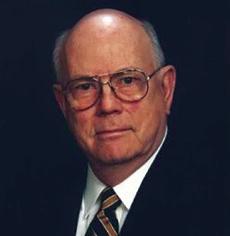
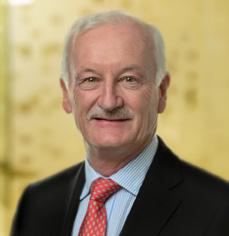
Ford’s EV investment slow-down, $5bn loss, unsettles battery investors
• GCube study charts BESS ‘failures’, warns insurers need confidence
• Albemarle signs new BMW lithium deal, but EV sales slump persist •Terra Supreme Battery set to launch bipolar lead battery plant in Indiana • ILA in costs warning as new EU workplace lead limits become law
• Exide Technologies boosts green credentials with climate targets
• Duke Energy to ‘phase out CATL from supply chain’ after security row
• Refined lead metal supply exceeded demand in 2023 reports ILZSG study
• BESS investments in Europe set to surge, says Aurora Energy
• Sustainability certification for Birla Carbon, new plants in US, Korea
• EnerSys picks South Carolina for $500m lithium cells giga-project
• Agratas names site for UK gigafactory
• Celgard, AEsir in Ni-Zn separator supply deal
• EnerSys unveils TPPL tech boost for batteries
• BMZ adds sodium ion to battery tech range
• ESS starts up long-duration battery demo project for US military
• Gravitricity plans
Finnish mine gravity storage prototype
FINANCE NEWS
Monbat mulls sales of three subsidiaries
• Queensland unveils A$570m battery jobs plan

46
• Precursor materials investment boost for Korean battery enterprise zone EIB mulls €500m finance for Vulcan’s zero-carbon lithium project
• Trent Capital takes full control of Microporous

CONTENTS www.batteriesinternational.com Batteries International • Spring 2024 • 1 COVER STORY: LITHIUM’S BURNING! FIRE, FIRE! (BUT THAT’S NOT THE COMPLETE STORY) 60
Ralph Brodd: lithium giant who galvanized the US — 1928-2024 6
Bill Brecht: lead battery rogue genius — 1948-2023 18
Cockerill: stepping away from Cornish Lithium 14
EDITORIAL: 4 Battery storage, the new realm of the double-talk OBITUARIES Two giants of the energy storage have sadly gone forever Ralph Brodd: History made bold: a key figure in the US lithium space 6 Bill Brecht: The gentle rogue genius of the lead battery industry 18 PEOPLE 10 Arvers succeeds Narishkin as new Bitrode chief executive • New technical roadmap on horizon as CBI celebrates fifth anniversary • Goodearl joins Eternity Technologies as sales director for North America • Slabe takes over as Ecobat CEO, president • Clarios wins second ethical company award • Janssen steps up as global CEO of Nyrstar • Sunlight appoints Mantzoufas as chief funding officer for giga project • GM appoints Kelty as VP of batteries • Cockerill quits Cornish Lithium to go for gold • Valente joins Nano One as CFO • Morrow appoints Boudgoust as CCO, Jon Fold von Bülow becomes chief science officer • Webster joins board of About:Energy • Oreskovic appointed VP for Myers EPS NEWS FOCUS 20 • EU elections manifesto, Timmermans cloud dispersed 20 • EV battery recycling chaos alert as EU waste rules loom 23 • ‘It’s make-or-break time for Europe’s Green Deal’ 24
26
Maroš Šefčovič: make-or-break time for Europe’s Green Deal 24
NEWS
FINANCE NEWS (CONTINUED)
• Addionics invests $400 million to boost EV battery tech plans
• Frontier, Mitsubishi agree Ontario lithium joint venture
• Investor Sosteneo buys into Enel BESS unit for €1.1bn
• Vanevo cash raise boost for flow battery stacks line
• SQM increases Altilium investment to $12m
• TotalEnergies acquires German BESS developer Kyon
• LGES leads $75m Sion Power capital boost RECYCLING
Ecobat, VW finalize UK lithium recycling deal • Taiwan’s ACME Metals installs ACE Green’s systems module after testing • Gravita endorsement by MCX, expands capacity to 291,000tpa • StarSun to invest in lead battery recycling plant in Oman • Sunlight to acquire full control of Ubatt • Li-Cycle gets liquidity boost from Glencore, Germany grants approval for new plant
• Regenerate Technology to launch lead ‘upcycling’ plant by the summer says CTO Athan Fox
• New Basel guidelines on lead recycling set for agreement in 2025, focus shifts to lithium waste
• Lead battery industry expertise backing Nigeria recycling program Northvolt in $5bn green loan boost for batteries, recycling
FEATURES
50
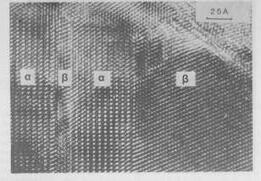

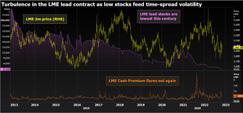
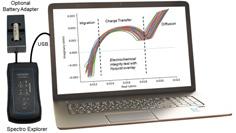

2 • Batteries International • Spring 2024 www.batteriesinternational.com Publisher Karen Hampton karen@batteriesinternational.com +44 7792 852 337 Editor Michael Halls editor@batteriesinternational.com +44 7977 016 918 Advertising director Jade Beevor jade@batteriesinternational.com Editor-at-large John Shepherd john@batteriesinternational.com +44 7470 046 601 Deputy editor Shona Sibary shona@batteriesinternational.com Finance administrator Juanita Anderson juanita@batteriesinternational.com Subscriptions, enquiries subscriptions@batteriesinternational.com admin@batteriesinternational.com Production/design Antony Parselle aparselledesign@me.com International advertising representation advertising@batteriesinternational.com The contents of this publication are protected by copyright. No unauthorized translation or reproduction is permitted. ISSN 1462-6322 © 2024 Mustard Seed Publishing UK company no: 5976361. Printed in the UK via Method Disclaimer: Although we believe in the accuracy and completeness of the information contained in this magazine, Mustard Seed Publishing makes no warranties or representation about this. Nor should anything contained within it be construed as constituting an offer to buy or sell securities, or constitute advice in relation to the buying or selling of investments.
CONTENTS
NEWS
The continuing story of lead dioxide— stoichiometry of the alpha form 57 Pat Moseley relates how crystallography helps explain the inner workings of lead batteries. Marketing in the brave new world of UGC 66 User generated content on the internet looks set to be the way forward for marketing and battery businesses large or small. Mitigating the financial risks when operating a secondary lead plant 74 Brian Wilson discusses how financial hedging can help mitigate difficult lead pricing. Insights for electrochemical impedance spectroscopy 79 Isidor Buchmann details a relatively unexplored test of battery health. EVENTS 84 Our definitive guide to the global conferences and exhibitions in the month ahead. Social media: the new key to marketing battery storage 66 Moseley: the lead dioxide story 57 Why EIS is opening up further tests of battery health 79 Wilson: risk management made plain, to hedge or not to hedge 74 Have conference will travel 84

Are we in the battery and energy storage business as full of doublespeak as the rest of the world? But do we want to do better?
In search of a truthful dialogue
“Europe is not known for its dynamism but it presently looks stagnant by any standard.”
That’s not a comment from this magazine but the March 30 top editorial in The Economist newspaper.
But in fact this is part of a broader question that needs to be flung to the architects of Europe’s current “situation”. (Or “deindustrialization”, as The Economist describes it.)
It’s about: the EU’s Green Deal that’s about to be torn to pieces; about its Batteries Directive that will be ineffectual for five years at least (if ever); and, the situation where any instinct for sensible business planning has been squashed by the European Commission’s crazed and unrealistic bureaucracy.
Underpinning this all, it’s also been about the use of language.
Europe’s big guns have talked their policies up hugely but — see our news focus article on European Commission second-in-command Frans Timmermans — have long never explained the situation properly. Instead they’ve used weasel words to discuss its thinking. (Or in the opinion of this magazine, its lack of it.)
Timmermans’ neologistic use of language goes back to Victorian children’s writer Lewis Carroll, in Alice Through the Looking Glass who imagines this conversation.
“When I use a word,” Humpty Dumpty said in rather a scornful tone, “it means just what I choose it to mean — neither more nor less.”
“The question is,” said Alice, “whether you can make words mean so many different things.”
Yes, how can you make the same words mean so many things?
How, to paraphrase Mr Timmermans, EU regulators are open to every battery chemistry and technology. But, but, but! Not the one in use in every car battery, back-up power system, telecoms tower and the like.”
As an aside one of the interesting features of listening to European Commission officials speaking at public meetings is that they — almost invariably — never stay for questions and at conferences, in particular, are
known to scurry off the moment they have delivered their presentation.
But this debate about language and confusing words and truth, in the sense of what is actually going on, and mixing it up is part of a larger picture.
Making language mean less
Outside of the Americas most people are unaware of Frank Luntz, the US mastermind communicator, who has used language to change the political landscape.
Luntz helped coin phrases such as: “energy exploration” (sounds better than “oil drilling”), “citizens” became “hard-working tax payers” and “global warming” was sterilized to “climate change”.
Most masterful: to describe “punitive sanctions” as “economic diplomacy”.
It didn’t change what was happening but phrasing the ideas in a more acceptable — depending on your political standpoint — fashion to convey your message.
Similarly, too, we’ve seen the way that the petrochemical giants have dealt with the way that they interpret our use of their products.
We now think more of our individual “carbon footprint” (courtesy advertising firm Ogilvy & Mather working for BP in 2004) than the petrochemical suppliers of kerosene to help us fly on holiday.
In my little village of Amberley in a very rural corner of southern England, a band of determined elderly people each week collect empty crisp packets, medical blister packs and milk bottle caps which can’t be recycled and then — perversely — once a fortnight drive to a collection point 10 miles down the road where it is picked up and processed.
Value of collected goods a hundredth of one US cent (if that). Landfill impact minimal. Gas to drop them off about $8.
This individual sense of culpability is not necessarily to be despised, though the logic of course is flawed, but their deeds need to be put into the media context. The fact is that since 1988, over 70% of global CO2 emissions have come from just 100 companies.
My villagers’ mistake is to accept any individual responsibility for corporate brand posturing (and profits).
EDITORIAL 4 • Batteries International • Spring 2024 www.batteriesinternational.com
Halls • editor@batteriesinternational.com
Mike
The war of language continues unabated. BP hammered its message home later in 2004 with its carbon footprint calculator — how much carbon did YOU use when you drove to work, when YOU bought that avocado in the supermarket, when YOU watched television?
Other perspectives
The battery business is in a fundamentally different position. We’re part of the solution. We’re not the problem.
Yet, we as an industry tolerate the linguistic misinformation that comes from Brussels which continues to pretend that Europe is at the cutting edge of any kind of self-sufficiency in energy storage.
This is all the odder given that, outside of Europe’s top civil servants, everyone knows that the continent is some 15 years behind the Chinese in terms of creating a viable lithium-battery supply chain and perhaps 10 behind North America.

In the structured mortgage-backed markets of the early 2000s how many knew what the terms meant?
It’s easy to tut-tut about other people’s misuse of language but it doesn’t take long for any outsider to spot the rank misuse the lead and lithium battery industry have achieved when mangling the communication language.
It’s worth focusing on three areas of this: misdirection; misleading jargon; and cliché, which renders words meaningless. Each is worth a complete essay on its own.
Perhaps the most striking example of misdirection — it’s one of the most obvious — that is the concept of the Advanced Battery. (Note, capital ‘A’ and ‘B’!)
For at least a generation, thinking back to when the ALABC was founded in the early 1990s, the idea has been bandied around that there were two types of battery.
There was the regular lead battery (most people used to think it was the car SLI battery, silly old them) and then there was the Advanced Battery.
But as soon as you dig deeper you find the Advanced Battery has been nothing more than a better version of the regular one. Yes, it may have a longer cycle life, be more robust, less gassing, water loss etc but has there been a huge step-change in the creation of this new Advanced Battery in the past 10 years?
Perhaps the biggest leap-forward in terms or what a regular lead battery can do, occurred well over a generation ago with the manufacture of VRLA/AGM batteries. (And, of course, the idea of ‘maintenance free’ batteries goes back to the 1930s and Otto Jache with gel batteries in the late 1950s.)
And jargon, why can it be misleading? From my earliest years as a financial journalist I realised that the primary use of jargon was not to work as a shorthand for those within a particular sector of business but one of exclusion, a blocking of an entry point for outsiders.
I remember seeing an investor offering that was an AAA-rated mortgage-backed security collateralized (wrapped) with other triple-A rated MBS that included triple-B and triple-C subordinated tranches. Pure misleading jargon. We knew what it meant and it was dodgy but investors didn’t and the banks wouldn’t tell.
The battery business pulls the wool over everyone’s eyes with clever little nonsenses such as storing “clean electricity”. So, in particular what is a “green electron”? Aren’t all electrons created equal? In scientists’ minds, electrons are electrons — they do whizzy things in extraordinary orbital shells around atoms — but green? When did they join any environmental movement?
Or storing clean electricity? One only has to think of the millions of petrochemical dollars spent to ship, build and install a large wind turbine and accompanying BESS to know that it’s probably on balance ‘green’ only in being better than a coal burning power station.
So green? Perhaps greener is a better term.
One can think of several battery firms, most recently that of Alsym Energy, which talk the green talk but won’t even reveal what their battery technology is, except it’s green. Very green. And non-flammable too.
And then there’s cliché. There’s masses here to say but probably the most overworked word in the battery storage business — as with other industry sectors too — is “innovation”.
This isn’t to criticise the fine work that the Consortium for Battery Innovation is achieving. Nor that of BCI’s impressive annual Innovation Award. It’s simply to say that the battery business has now over-used the word to the point it’s close to redundancy. Innovative used to mean something, now we can’t be too sure.
Mike Halls, Editor-in-Chief
EDITORIAL www.batteriesinternational.com Batteries International • Spring 2024 • 5
The North American advanced battery landscape would be very different without the technical achievements and later advocacy of one lithium giant who realised its importance and campaigned for its future.
History made bold: a key figure in the US lithium space is gone
It is with sadness that Batteries International and sister magazine Energy Storage Journal, have to announce the death of lithium battery giant Ralph Brodd, who died in February aged 95.
Jim Greenberger, NAATBatt executive director and its joint co-founder with Ralph, described him as “one of the most consequential figures in the history of advanced battery technology in the US.”
Ralph’s most enduring impact on US industry grew out of his article Factors Affecting U.S. Production Decisions: Why Are There No Volume Lithium-Ion Battery Manufacturers in the United States? published in December 2004.
In that article, Ralph was the first to sound the alarm about the loss of lithium ion battery manufacturing capability in the US and the long-term consequences of that loss.
His influence has been extensive.
Greenberger first met Ralph in 2007. It was Ralph who convinced him to found NAATBatt, the US and international advocate and trade body for advanced battery research and development, to address the looming crisis of lithium battery technology in the US.
That effort in turn caught the attention of a first-term senator from Illinois named Barack Obama. The rest is history.
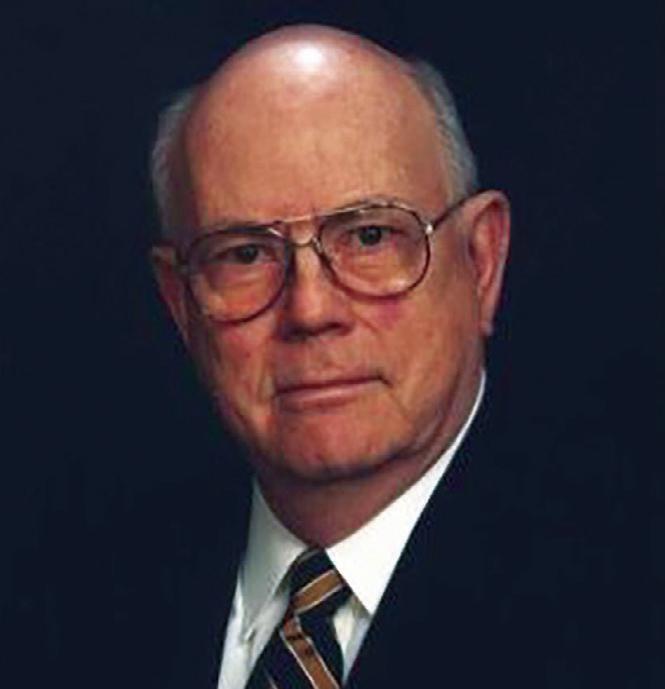
“Roger was one of the most consequential figures in the history of advanced battery technology in the US”
“Now Ralph belongs to that history he created. He had more impact on it than many realize,” says Greenberger.
Over the past few years, federal and state governments have made unprecedented investments in EVs and supply chain projects to try to help US manufacturers and workers regain the lead in lithium ion battery manufacturing, Greenberger said.
The revised Section 30D tax credit will inject about $7.5 billion of investment into US-made EVs. The Advanced Manufacturing Production Credit should generate tax credits of about $30.6 billion to US manufacturers through 2031. An additional $13.8 billion of subsidies has been awarded by states and localities to at least 51 EV and lithium ion battery plants.
“Every single one of those investments can trace its origin to Ralph Brodd and his forward-thinking article,” says Greenberger.
The early years
Ralph James Brodd was born in Moline, Illinois on September 8, 1928, his parents were of farming stock originally and his father had been a fighter pilot in the first world war. His mother was a teacher, a profession he spoke about with respect all his life and something that was deeply important as an academic. A chemistry set given to him, aged seven, for Christmas led to a love of science (“going boom was my favourite” he later described mixing zinc with acid and lighting the gases). “By the time I’d got to junior high school I’d decided to be a chemist,” he later recalled.
He obtained a BA in chemistry from Augustana College, a private Lutheran college in Rock Island, Illinois, in 1950, the year he married Dorothy who was to be his partner for the rest of his life. This was followed by an MA in physical chemistry from the University of Texas and his PhD there two years later.
OBITUARY: RALPH BRODD: 1928-2024 6 • Batteries International • Spring 2024 www.batteriesinternational.com
His connections with the Electrochemical Society (ECS) run deep. He was invited to join in 1954 as a young researcher pursuing a PhD at the University of Texas. Little did he know on his first visit to an ECS meeting in Cincinnati that this was a start of a lifetime relationship with the society or that he would one day become its president
A lovely anecdote is told in a later interview for the ECS archives.
It was 1954 and Ralph and his wife, Dorothy, had been expecting their second child. As full-time students, the couple worried about finding the money to pay the hospital bills.
The morning Dorothy was set to come home from the hospital, after delivering the couple’s second child, Ralph was deeply worried about where they would find the money to cover the costs, especially as healthcare in the US was very expensive.
Ralph braced himself for the worst but before heading to the hospital, but to his surprise, he checked his mailbox and discovered a letter from ECS.
In this he learned he had won the 1954 Corrosion Division Essay Contest. The letter came complete with a prize cheque that would be the answer Ralph and Dorothy were looking for.
The essay paid the hospital bill. “That saved us!” Ralph said years later.
That moment also spurred what would become Ralph’s lifetime dedication to the ECS. He went on to be elected ECS vice president in 1978, later claiming the title of president in 1981. He was named an honorary member of the society in 1987 and served as an editor of the Journal of The Electrochemical Society
In terms of work, fresh from obtaining his PhD in 1955 the young Dr Brodd joined what was then called the National Bureau of Standards. Here he worked specifically on standard cells, kinetics of battery-related reactions, and the internal impedance of batteries.
He later used to say that his understanding of impedance had been both the discovery of “one of the most powerful tools [in battery analysis] but also offering all sorts of very interesting things.” He worked at the standards bureau for six years.
Meanwhile he was also pursuing an academic career. He taught physical chemistry in the US Department of Agriculture Graduate School from 1956 to 1961, and lectured in elec-
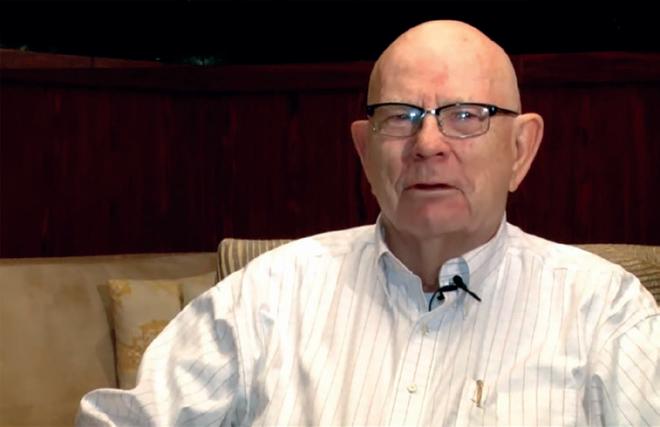
A young chemist discovers hydrogen: “…you’d drop a piece of zinc into a flask of hydrochloric or sulfuric and then put a match to it. I used to like it go BOOM! ... of course, mum wasn’t too happy with that.”
trochemistry at Georgetown University (1961) and American University (1958).
In 1961, Ralph joined LTV Research Center as a senior scientist and was appointed head of the energy sources section in 1962, which included fuel cell and plasma physics. During this time the fuel cells he had been helping develop were contenders for the first Apollo lunar landing series.
The Union Carbide years
His next move in 1963 was to the Battery Products Technology Center of Union Carbide Corporation in Parma, Ohio. He became group leader in 1965 and technical manager in 1966.
It was at Union Carbide he first encountered lithium batteries. He and a Japanese colleague were so excited about the possibilities of lithium manganese dioxide as a primary battery that they set up the International Battery Material Association and organized a conference where 200 people from Japan and elsewhere attended.
However, much to his disappointment Union Carbide wasn’t much interested saying that they reckoned it would take at least five to 10 years for lithium batteries to be commercially attractive.
Ralph recalls that indeed when some of the first lithium cells were
released, they first found a market for fishing floats in Japan. “Alkaline batteries were too heavy but a lithium battery was so light it could be used as a light for those wanting to fish at night. But we all could see it would soon outgrow the early limitations.
“There’s not much point in making a battery if you can’t sell it,” he said in an interview in 2015.
In 1978, he joined ESB which became INCO ElectroEnergy as director of technology.
He hit the ground running at INCO — in the next four years he established a Technology Surveillance group at the research center, this led him to having oversight and policy responsibility for the five INCO ElectroEnergy R&D laboratories. This was a huge remit as he had to cover many product areas ranging from primary and secondary batteries to uninterruptible power supplies and small electric motors.
It was after this he set up his own consultancy called Broddarp — a vehicle that he was to re-establish many years a later on his retirement when he reached the age of 70.
Consultancy clients led to other work, sometimes in new areas of energy storage.
He became project manager to the Amoco Research centre where he was responsible for rechargeable lithium sulfur dioxide battery project from 1984 to 1986.
OBITUARY: RALPH BRODD: 1928-2024 www.batteriesinternational.com Batteries International • Spring 2024 • 7
It was here he developed a sophisticated business plan and commercialization strategy that included market research — something that was starting to become popular at that time.
He next moved to Gould Inc where he would spend the next six years helping establish and manage its lithium Powerdex battery venture based on flat lithium battery technology. He established production, sales and marketing, and the RD&E functions for the venture. He developed new primary Li-MnO2 production technology and expanded the product line in response to market opportunities.
Two new solid electrolyte batteries were developed: one an ultra-thin 0.5 mm thick cell for specialty and smart card applications as well as a small hermetic cell capable of withstanding SMT processing temperatures (+200°C).
Valence and byond
With retirement starting to loom he joined Valence Technology in 1992 as staff consultant/marketing director and later as vice president of marketing. Valence Technology, was a venture group developing a unique Li-Ion battery system for rechargeable batteries for portable consumer.
He also continued to pursue his academic and teaching work. In 1990 he became adjunct professor in chemistry at Michigan Technology University a position he would only step down from in 2014 (then aged 84).
Ralph worked in many areas of electrochemical power sources: primary and rechargeable batteries, including porous electrodes, exploratory new concepts, separator, lithium batteries, fuel cells, oxygen electrodes, and zinc air batteries, and fundamental electrode properties.
He held offices in Washington Capital and Cleveland sections of the ECS. In 1971, he received the Heise Award from the Cleveland section. He was general chairman of the MnO2 Symposium sponsored by the International Common Sample Office in 1975 and was chairman of the council of sections, the battery division, and honors and awards committee.
Ralph served on the education and contributing membership committees, and was chairman of the 75th year anniversary celebration ad hoc committee.
Ralph also served the society as representative to the Intersociety Energy Commerce and Engineering Conference and a battery division editor.
He was national secretary for the International Society of Electrochemistry (ISE) and chair of the 1979 Gordon Conference in Electrochemistry and secretary of the National Advisory ad hoc Battery Committee to EDRA. He was a member of ISE, ACS, AAAS, the Chemical Society (London), American Institute of Chemists, Sigma Xi, and the New York Academy of Science.
Ralph published more than 110 articles and was awarded five patents and his papers waswidely published. But that barely scratches the surface,” says Jim Greenberger. “Yet he was also one of the kindest, most decent and most humble men you could ever hope to meet.”
A work-leisure balance
A friend wrote about his time at the ECS and after that: “He loved to travel, enjoy fine dining and sipping good wine. He especially loved it when his wife would accompany him on his business and leisure travels, allowing them to see amazing sights in many countries.
“He had a true love for work, travel, and providing for his family. He was a gentle and humble man.”
Bob Galyen, who took over as CTO for NAATBatt, told Batteries International. ”He was a wonderful person to know professionally, and a very influential person to those who knew him. A humble giant of the industry from the era of time which many younger generations don’t know about.
“His gentle, yet intellectual approach, utilizing a great work ethic, was to be admired by all.”
Greenberger said: “Our sincere condolences to Dorothy and to the rest of the Brodd family. Ralph will be sorely missed.”
Kentucky governor Steve Beshear said, when appointing Ralph to head up the Kentucky-Argonne National Battery Manufacturing Research and Development Center: “Ralph Brodd literally has written the book on advanced battery technologies, and I am excited by his willingness to help us develop a renowned battery manufacturing research and development center here in the Commonwealth,”
Looking back on his life it is strange that he is less well known than he deserves given his vital role in waking the US up to the challenges of the lithium battery revolution. Ralph will be missed by many, many more — knowingly or unknowingly — who have benefited from his teaching, wisdom,
humility and diligent intellectual integrity.
Ralph is survived by his wife of 73 years Dorothy (née Siegle). He was the father of Wayne, Lynn Faenza (Joe), and Bill; grandfather of Matthew Brodd, Stephanie Woodman, Stacy Rainwater (Chris), Angela Myford (Erik), David Faenza (Jocelyn), Alora Brodd, and Kendall Mareovich (Wes). He was also the great grandfather of 11.
SOUNDING THE ALARM
Ralph’s report Factors Affecting U.S. Production Decisions: Why are There No Volume LithiumIon Battery Manufacturers in the United States? — drew the following conclusions.
• Short termism. US battery companies opted out of volume manufacturing of Li-ion batteries, because of a low return on investment compared with their existing business. There was also significant time and investment required from conception to commercialization.
• US needed to think local Labor costs were not a major issue impeding large-volume production of the cells in the US. The Asian strategy of providing facilities and loans to establish manufacturing locally and create jobs was more important.
• Geographical link between manufacturing and technology Technological development tends to follow manufacturing to East Asia, as a natural consequence of developing manufacturing expertise. He said battery production will slowly shift to China, Korea, and Southeast Asia.
• Niche markets available Opportunities still exist for US companies to enter niche markets, such medical, military, or space applications. Mechanisms for cooperation between government, academia and industry need to be made so that advanced materials technologies have the resources and direction to succeed.
OBITUARY: RALPH BRODD: 1928-2024 8 • Batteries International • Spring 2024 www.batteriesinternational.com

Arvers succeeds Narishkin as new Bitrode chief executive
Pierre-Jean Arvers has succeeded Cyril Narishkin as CEO of US-based energy storage and battery testing equipment company Bitrode — but no offiicial explanation surrounds the reason for the move.
The Schuler Group, which acquired Bitrode and the Sovema Group in 2022, confirmed Arvers’ appointment to Batteries International, but declined to say when he took up the post or comment on the reason for Narishkin’s departure.
Narishkin has yet to
respond to questions but in a LinkedIn post said he was “looking for a new leadership role”.
He said he was proud of what Bitrode accomplished during his five years at the helm, “especially the launch of a new machine that has won contracts with major EV OEMs”.
Narishkin is the fourth CEO to stand down from their position at Bitrode in the past 12 years.
At the time of Bitrode’s acquisition by Schuler, Narishkin said the takeover
would help the firm “accelerate new product offerings and help Bitrode reach its technological potential”.
Schuler, which is part of the international technology group Andritz, said Arvers has more than 20 years of international experience including chemistry and chemical engineering.
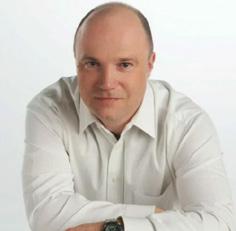
“The plan is to propel Bitrode to new operational heights through Arvers’ astute customer-centric approach to executive leadership in the EV, energy storage, and battery testing industries,” it said.
According to Arvers’ LinkedIn profile, he was most recently general manager of speciality wires, cables and braided sleevings group Omerin USA.
He is also a former president of NAATBatt International and president of Digatron Power Electronics USA.
New technical roadmap on horizon as CBI celebrates fifth anniversary
The Consortium for Battery Innovation has celebrated its fifth anniversary, revealing plans to publish its third technical roadmap for advanced lead batteries later this year.
The CBI was formally established on February 25, 2019 as the successor organization to the Advanced Lead Acid Battery Consortium.
As well as continuing ALABC’s work in pre-competitive research, CBI has expanded the program to promote innovation in lead batteries — not just through cutting edge research, but also highlighting the innovative new applications that utilize lead batteries.
Executive director Alistair Davidson told Batteries International on March 5 the growth in CBI’s membership over the past five years — from 72 to more than 120 today — mirrored the increase in technical programs and initiatives the organization is involved in to highlight the range of opportunities for lead battery energy storage.
“Since launching we’ve produced a key technical
roadmap which has helped drive forward enhancements in performance, all of which is critical to demonstrating the advantages and capabilities of lead batteries.”
Davidson said CBI plans to publish its third technical roadmap (the first was released in 2019) this year, in addition to working on a range of programs with members.
“Our members are the driving force behind our work and their enthusiasm and support has been pivotal to our success.”
Other achievements include successful bids for research and project funds from the EU — LoCelH2 and Aftrak — and a military microgrid project in the US.
CBI will be holding energy storage meetings in China and India this year as the organization expands its membership in Asia.
“Our technical workshops with car companies and OEMs are helping ensure we maintain support for micro-hybrid applications and the key application of auxiliary batteries,” Davidson said.
Meanwhile, CBI is preparing for the opening of
Battcon in Miami in May, which will be the first outing of the US annual stationary battery conference since CBI took over the running of the event.
Davidson said: “In the next five years we expect to see a lot more interest in lead battery projects as decision-makers and stakehold-
ers try to work out how to meet the huge demand for battery energy storage in 2030 and beyond.
“We see advanced lead batteries offering solutions to some of the most pressing challenges legislators face, from decarbonisation to electrification and sustainability.”
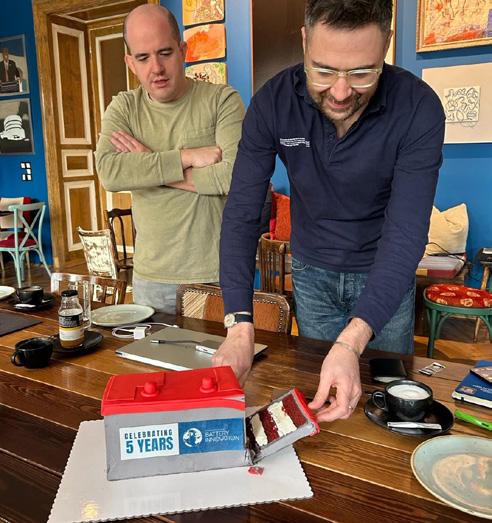
PEOPLE NEWS 10 • Batteries International • Spring 2024 www.batteriesinternational.com
The sweet spot of cutting-edge innovation. Executive director Alistair Davidson and technical director Matt Raiford said the results of the tear down analysis of CBI’s ‘battery’ were… delicious!
Goodearl joins Eternity Technologies as
sales director for North America

in North America.
Goodearl is leaving from Texas based-OEM Advanced EV where he was VP of strategic accounts and he announced his appointment in a LinkedIn post on March 4.
He is a former director of marketing and global accounts at the Hammond Group and has some 37 years’ experience in the battery industry.
Goodearl first came to prominence while working for Randy Hart at Supe-
rior Battery Manufacturing Company in 2006 as VP of international sales and marketing.
Last January, Eternity announced an expansion of its premium range with the launch of its QUASAR carbon nano flooded deep cycle bloc battery.
The battery is designed for a range of applications including golf carts and the marine sector and is also suitable for solar and reserve power applications.
Slabe takes over as Ecobat CEO, president

Ecobat said on January 29
Thomas Slabe had been appointed as the company’s third CEO and president in five years with immediate effect.
Slabe, who will also sit on the board, succeeds Marcus Randolph.
Randolph became president and CEO in March 2022 — following Jimmy Herring’s sudden departure — and he will continue to sit on the board of the lead and lithium recycler as chairman.
Slabe is a former CEO of castings company Neenah Enterprises and a corporate president of Contech Engineered Solutions’ building
materials division — both in the US.
Batteries International reported on January 25 that Ecobat had commissioned its first lithium recycling plant in the US.
Ecobat’s lithium sales VP Elliott Ethridge said despite the company’s long history in lead recycling, it made sense to go into lithium: “We see lithium coming on to augment a lot of spaces that lead doesn’t serve.”
Clarios wins second ethical company award
Clarios announced on March 4 it had been recognized as one of the world’s most ethical companies by Ethisphere for the second consecutive year.
The honour is bestowed on companies that demonstrate business integrity through excellence in ethics, compliance, sustainability, leadership and governance.
Last year was the first time the world’s largest manufacturer of automotive batteries had been recognized.
Clarios is one of only
eight such illustrious names for 2024 in the automotive industry.
A total of 136 organizations were recognized in the latest list spanning 20 countries and 44 industries.
Ethisphere uses its proprietary Ethics Quotient to assess companies. Firms are required to answer more than 200 questions on culture, environmental and social practices, ethics and compliance activities, governance, diversity and initiatives that support a strong value chain.
The process serves as an
Janssen steps up as global CEO of Nyrstar
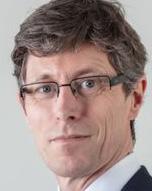
Guido Janssen has been appointed global CEO of the Nyrstar Group effective February 2.
Janssen was previously co-CEO of the group, with operational responsibility for European and US activities, including operating the German lead production plant Stolberg — acquired from Ecobat in 2022.
Dale Webb, who had been co-CEO alongside Janssen since December 2022, has resigned for personal reasons.
However, Nyrstar said Webb would continue to support Janssen and colleagues until the end of March.
operating framework to capture and codify the leading practices of organizations across industries and around the globe.
Last October, the lead and lithium batteries giant was announced as the winner of the circular economy category of the World Sustainability Awards.
Clarios was one of 15 companies shortlisted for that award, which honoured firms that “go above and beyond” to continuously reuse, recycle and retain materials and products.
Australian operational and functional leaders will report to Janssen while a review of reporting structures is completed, Nyrstar said.
Nyrstar, which is a subsidiary of Trafigura, the mining giant, is a multi-metals mining and smelting company that is a market leader in the production of zinc and lead metal.
Last September, Nyrstar Australia said it was considering options to expand its battery recycling operations backed by South Australia’s state government.
PEOPLE NEWS www.batteriesinternational.com Batteries International • Spring 2024 • 11
Battery veteran Ray Goodearl has joined Eternity Technologies as director of sales for specialty products
100 years is just the start. Are you charged up for more?





BCI 2024 CONVENTION + POWER MART EXPO
APRIL 2124, 2024 + FORT LAUDERDALE, FLORIDA






Join us for the convention of the century as Battery Council International celebrates 100 years of industry leadership. The 2024 BCI Convention + Power Mart Expo will be an electrifying experience like no other — with stimulating speakers, dynamic panel discussions, exciting industry forecasts and numerous networking opportunities — culminating in a grand Centennial Celebration.

TAKE YOUR SHOT AT $100,000! In honor of BCI’s centennial celebrations, this year BCI has amped up the excitement and is offering a once-in-a-lifetime, $100,000 prize for our annual hole-in-one challenge! Learn more about the BCI Convention and Golf Tournament.








Sunlight appoints Mantzoufas as chief funding officer for giga project

battery manufacturer said on January 17 Mantzoufas would also be responsible for the integration and monitoring of the group’s projects funded through development initiatives and investment schemes in Europe and America.
Mantzoufas was most recently governor of Greece’s EU-backed Recovery and Resilience Facility. He is also a former board member of the European Investment Bank.
Of that amount, €20 million would be spent toward an annual production capacity of 1.7GWh of lithium batteries, on top of €105 million already invested at Xanthi on R&D and a prototype lithium ion cell production line.
Last August, Sunlight announced the comple-
tion of an R&D program into developing ‘smarter and healthier’ lithium ion batteries.
In November, Sunlight confirmed it was spinning off its lead recycling operations into a new subsidiary to guarantee raw material supplies for lead battery production.
The lead and lithium
Sunlight said in September 2021 it would invest €50 million ($54 million) to expand its lead and lithium manufacturing unit in Xanthi, north-eastern Greece.
GM appoints Kelty as VP of batteries
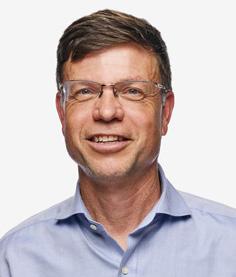
February 8.
In the newly created post, Kelty, a former Tesla executive, will take charge of GM’s battery cell strategy — including overseeing the use of raw materials, research, developing and investing in new technology, commercialization of cells and packs and end of life opportunities.
Kelty reports to GM president Mark Reuss, who said Kelty’s expertise, would
help the company become a leader in EV tech development.
Most recently, Kelty was a VP at silicon anode material company Sila with responsibility for sales, business development, battery cell manufacturing partnerships and battery engineering.
Before Sila, Kelty led the Tesla battery development team for 11 years, where he was responsible for technical exchanges and commercial negotiations with battery cell suppliers and early-stage battery cell developers.
He began his work in lithium ion batteries in 1993, working for Panasonic.
In December 2022, the US Department of Energy said it had closed a $2.5 billion loan to help finance construction of three lithium battery cell manufacturing plants by LG Energy Solution and General Motors’ Ultium Cells joint venture.
Seoul hosts inaugural World Battery Forum

Representatives of battery associations from South Korea, the US, Europe and Japan attended the first annual World Battery Forum in Seoul on March 4.
The Korea Battery Industry Association (KBIA) hosted the inaugural forum that will be convened once a year, with the second meeting to be held in 2025 in the US.
Initial members of the forum include KBIA, the US Portable Rechargeable Battery Association, Europe’s industry association for advanced rechargeable and lithium batteries (RECHARGE), the Battery Association for the Supply Chain in Japan and the Battery Association of Japan.
NATTBatt participated as an observer ahead of becoming a member of the forum.
Global major cell manufacturers were also represented at the forum including LG Energy
Solution, Samsung SDI and SK On, along with Stellantis and Varta, Panasonic, TDK Corporation and Microsoft.
KBIA said the forum will serve as an umbrella body for associations to campaign for batteries to be at the heart of eco-friendly policies worldwide, scrutinize regulatory measures, support fair and free trade and investment in the battery industry and cooperate to secure battery supply chains.
Topics on the agenda for the first meeting included the impact of the US Inflation Reduction Act internationally, policy and regulatory environments, battery supply chains and battery recycling-related issues
KBIA executive vice president Park Tae-sung said the forum is laying the foundations to strengthen cooperation on issues affecting the battery industry globally.
“We look forward to the forum serving as a platform for the global battery industry to cooperate on worldwide battery-related policies, regulations and standardization.”
PEOPLE NEWS www.batteriesinternational.com Batteries International • Spring 2024 • 13
The Sunlight Group has appointed Nikos Mantzoufas as chief funding and institutional affairs officer for construction of a lithium ion cells gigafactory project in Greece.
Kurt Kelty has been appointed VP of batteries for General Motors, the auto giant announced on
Cockerill quits Cornish Lithium to go for gold
Ian Cockerill has stepped down as independent non-executive chairman of UK exploration firm Cornish Lithium, following his appointment as CEO and executive director of gold mines multinational Endeavour Mining.
Cornish Lithium said on March 6 founder and CEO Jeremy Wrathall will also take on the role of chairman on an interim basis.
The process of finding a replacement independent non-executive chair will start soon.
Wrathall thanked Cockerill for his work with the company over the past two years saying the firm had made significant progress including securing an undisclosed landmark financing package.
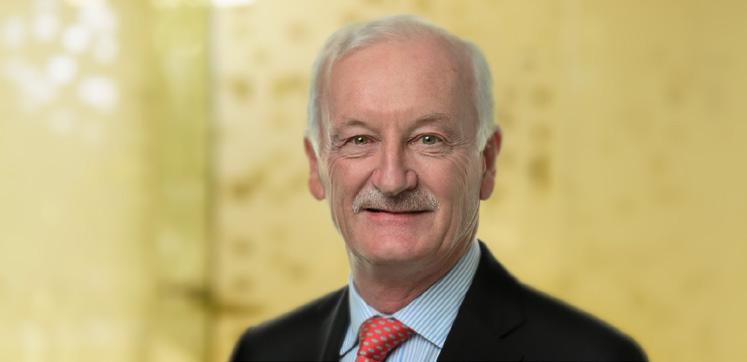
Meanwhile former director Keith Liddell has rejoined the board as a non-executive director.
Alongside his long association with Cornish Lithium, the company said Liddell brings a wealth of knowledge of mineral
extraction techniques and management of such projects worldwide.
In 2021, the company was granted permission to also go offshore in its search for lithium to supply the UK’s future EV battery market.
Last month, Cornish Lithium announced details of a community engagement programme in Redruth, Cornwall, about its plans for a geothermal project to extract lithium from mineral-rich groundwaters.
Valente joins Nano One as CFO
Carlo Valente has joined Canada’s Nano One as CFO effective January 15, the company has announced. He succeeds Dan Martino, who will remain with the company as VP of finance.
Valente was most recently CFO of a private, international renewables company and has more than 26 years of experience supporting companies as they scale-up with capital raising, M&A transactions and strategic planning, Nano One said.
Nano One founder and CEO Dan Blondal said Martino had worked as CFO since January 2020 on a fractional basis through Donaldson Brohman Martin CPA — where he holds other CFO positions for publicly traded companies.
By staying on as VP of finance, Martino would ensure continuity and support in financial reporting and finance-related projects, Blondal said.
In September 2023, Sumitomo Metal Mining announced a C$16.9 million ($12.5 million) investment in Nano One as part of a new battery materials development partnership.
The firms said the equity investment boost was part of a collaboration that
would have a particular focus on LFP and NMC production.
On October 23, Nano One said a pre-feasibility study indicated the firm could realize an estimated 10-fold increase in production capacity at its lithium iron phosphate cells facility in Quebec.
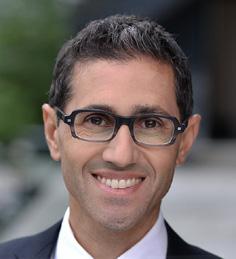
Hoppecke wins platinum medal from business sustainability ratings firm
European lead battery manufacturer Hoppecke said on January 10 it had received its first platinum medal from business sustainability ratings firm EcoVadis.
The accolade puts the company into the top 1% of all firms assessed by EcoVadis based on the organization’s reviews of business practices relating to the environment,
ethics, labor and human rights and sustainable procurement.
EcoVadis assesses more than 100,000 companies across 175 countries annually.
Medals are awarded based on a company’s performance compared with all rated companies in the EcoVadis database over the preceding 12 months.
Hoppecke sustainability officer Ludwig Merz said the battery maker had received several gold medals from EcoVadis in recent years.
Last year, Hoppecke’s new batteries production plant in Poland secured ISO 9001:2015 and ISO 14001:2015 certification for quality and environmental management.
PEOPLE NEWS 14 • Batteries International • Spring 2024 www.batteriesinternational.com
Morrow appoints Boudgoust as CCO, Jon Fold von Bülow becomes chief science officer
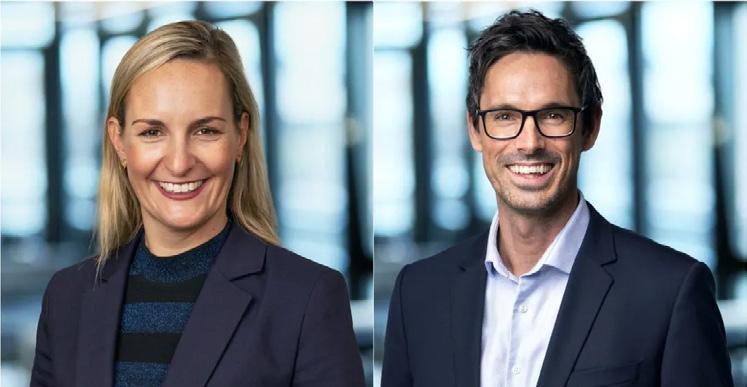
leading Morrow’s R&D department with responsibilities including further developing the company’s LFP cell technology and transferring product designs and specifications to the manufacturing team.
He will work alongside co-founder Rahul Fotedar who continues as CTO.
Morrow Batteries said on January 23 it had appointed Christin-Marie Boudgoust (pictured above left) as CCO, while co-founder Jon Fold von Bülow (above right) has been promoted to chief science officer.
Boudgoust’s first day at the company was January 15 while Fold von Bülow’s promotion was effective on January 1.
Boudgoust’s responsibilities will include securing off-take agreements, building partnerships and driving technical sales, Morrow said.
Fold von Bülow is now
The appointments follow that of CFO Steffen Føreid who joined Morrow last October, after the company said it was raising up to €70 million ($74 million) in new capital as it moves toward commercial production.
Morrow’s first gigawatt-hour LNMO battery cells factory in Arendal in the south of Norway is set to start up this year.
Webster joins board of About:Energy
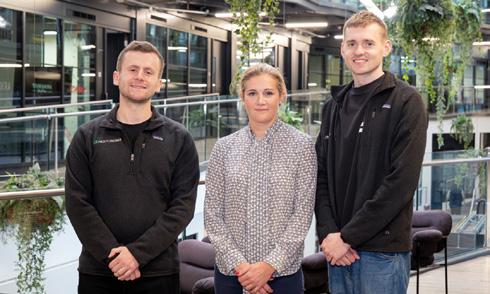
Tech investment expert Laura Webster has joined the board of London-based battery software developer About:Energy, the company announced on January 10.
Laura Webster with About:Energy co-founder and CEO Gavin White (right) and COO and co-founder Kieran O’Regan
Oreskovic appointed VP for Myers EPS
Mike Oreskovic has been appointed VP of energy storage systems for Myers Emergency Power Systems, following Myers’ takeover of Storage Power Solutions (SPS).
Oreskovic was a co-founder and former MD of SPS, Myers told Energy Storage Journal on February 9.
Following the acquisition, for an undisclosed sum, Pennsylvania-based
Myers launched its EnerShed BESS products line which the company said has scalability starting from 60kW and can be deployed to support a variety of uses including peak shaving, energy arbitrage, demand response and back-up power.
Myers CEO John Daly said the takeover of SPS would accelerate the firm’s expansion and capabilities in the BESS market.

Webster, a partner at investment firm Coltrane Asset Management, has a successful track record in navigating technology market volatility, About:Energy said.
She also specializes in angel investing and made what About:Energy said was a notable investment in its June 2023 seed round, valued at £1.5 million.
“This investment underscores her forward-thinking approach and her ability to identify and support promising ventures in the energy sector,” the firm said.
Founded in 2021, About:Energy is a spinout from Imperial College London and the University of Birmingham.
The company’s software platform, ‘The Voltt’, can be used by customers developing their own battery programmes to cut development costs and use the modelling software to reduce time to market for their own products.
PEOPLE NEWS www.batteriesinternational.com Batteries International • Spring 2024 • 15
John Shepherd says farewell to Batteries International, welcomes Shona Sibary as incoming deputy editor
John Shepherd, editor-atlarge of Batteries International News, has stepped down to take on the editorship of a publication covering the wider automotive aftermarket sector in the UK.
The veteran energy journalist, who joined the team that also publishes Batteries International and Energy Storage Journal in February 2022, officially stepped down on March 26.
Joining the team will be Shona Sibary, a long-standing journalist with extensive experience writing for UK national newspapers on a variety of subject matter. She starts her new position as deputy editor for Batteries
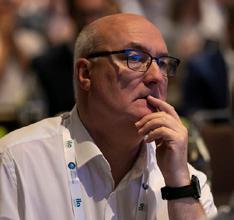
International on April 8.
“I’m looking forward to learning more about this tremendous and important industry,” she says, “it’s at an absolutely critical time to be learning more about batteries and what part they can play — not only in modern life, but also a sustainable future.
“I am honoured to be joining the leading publi-
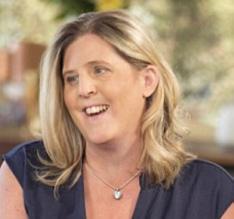
cation in the industry to further contribute to their flagship work in reporting everything the world needs to know about this fascinating and crucial market.”
Mike Halls, editor-in chief of both publications, said John would be sorely missed by the staff and also the industry. “I wish him every success in his future endeavours, he’s been a great
person to work with and he’s moving on to yet more exciting and interesting things.
“We will all miss him but we have high hopes that he may occasionally be able to represent our magazines at future conferences.”
Shepherd said: “It’s been a fantastic couple of years working with the team behind the pre-eminent publications dedicated to the international battery and energy storage markets.
“I will particularly miss supporting the team with our second-to-none reporting at industry events, at which I am proud to have also worked with leaders of battery companies and trade organizations worldwide.”
Farewell to battery industry veteran Sergio Pezzotti: 1932-2024
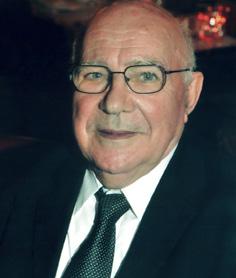
It is with sadness that Batteries International reports the death of Sergio Pezzotti, a founder of battery components group Accumalux, who died in Monza, Italy on March 19 aged 91. We hope to contribute a fuller piece for the magazine later in the year.
Sergio, a 66-year veteran of the battery industry, was laid to rest in Monza — just over a year after the death of his beloved wife Cesarina.
His son Alberto, director of Italian plastics moulding company Technofin 98, told Batteries International that his father was born
in Milan on September 19, 1932, when Sergio’s father was working for Alfa Romeo.
Sergio later graduated from the Alfa Romeo technical school — joining the battery industry in 1951 working for a company that was producing hard rubber battery cases and lids.
He went on to be a pioneer in the development of plastic injection moulding for battery plastic components and, in 1960,
Sergio joined Accuma in Monza. Accuma specialized in the production of materials for industry including cases and lids for lead batteries.
Sergio was among the founders of the Accumalux Group in Luxembourg in 1976 and he also founded several similar companies across Europe, the US and Africa from the 1970s to the 2010s.
He was also involved in the sale of equipment for
the production of battery plastic components or moulds by those companies in South America, Asia and Europe, as well as research and development well into the 2010s.
Sergio retired shortly after the Covid pandemic. Son Alberto told Batteries International his father will be greatly missed by himself and his wife, Elena, as well as by many people in the industry that have sent condolences to the family.
Ninety-year-old Mahavir Prasad Agarwal has been reappointed as chairman and a director of Gravita India for the next three years.
The Rajasthan-headquartered Indian lead recycler said the reappointment, with effect from April 1, was approved at a board meeting on March 28.
Agarwal, the father
of Gravita’s MD Rajat Agrawal, retired as director of Rajasthan’s medical and health department in 1992 and went on to launch Gravita that year with his son. He has been a guiding force and source of inspiration to the whole company ever since, Gravita said.
Last month, Gravita said it had increased
the total lead recycling capacity of the group to almost 291,000 tonnes per annum — keeping the firm on course to achieve its overall target of 425,000 tpa by fiscal 2026.
The increase came after Gravita expanded lead battery recycling at its plant in Tanzania by 5,000 tonnes per annum to 12,000 tpa.
PEOPLE NEWS 16 • Batteries International • Spring 2024 www.batteriesinternational.com
Gravita’s Agarwal reappointed chairman for next three years
Another giant in the evolution of the modern lead battery industry has passed away. We celebrate the life, achievements and legacy of one of the greats.
The rogue genius of the lead battery industry

“He was a great person to be with, interesting and fun but one of the most inventive minds I’ve met. It might even be fair to call him a genius.”
It is with sadness that Batteries International has just heard of the death of William Brecht who died at his home in Rio Rancho, New Mexico on June 3, 2023.
Bill was a much-liked, larger-thanlife figure in the battery business for over four decades, making huge contributions to the advancement of the industry’s engineering and technology and even occasionally nicknamed “a rogue genius” for the originality of his thinking.
Bill was born in Philadelphia, Pennsylvania on March 14, 1948. He graduated from Lafayette College with a science degree in mechanical engineering and a minor in nuclear engineering in 1971.
In 1974 he joined Exide Battery in Philadelphia. A combination of hard work and innovative thinking helped him climb the corporate ladder at
the battery giant in the early 1980s to become vice president of technology. During his time there his research led to a step-change performance increase of an industrial forklift battery — he was later dubbed ‘The Father of the Load Hog” for his quite remarkable work — a concept which formed the basis of some of much of his later thinking.
He subsequently moved to become a VP for C&D. After that he ran two factories for Evanite Fiber Corporation, a battery components manufacturer, before moving back to battery research as CTO at Trojan Battery Company.
Given his deep background in battery seals and profound interest in bipolar batteries he was then lured to work for Atraverda in Wales.
On retirement he was widely sought after as a consultant for Sebang
Global Battery in South Korea, and Full River Battery in China. He was also one of the cofounders of bipolar firm Advanced Battery Concepts.
Bill was a highly respected technologist in his specialty field of lead acid battery technology and battery charging technology. He was an enthusiastic electrochemist with 53 US and foreign patents to his name.
One friend wrote: “Bill left an indelible mark on the world with his inventions in both motive and stationary power touching everyday lives of people. Working with the nuclear navy (submarine batteries), mining equipment, fork lift, scissor lift, utility vehicles, marine batteries, and golf cart batteries. He invented battery chargers for golf carts, and more.
“He patented the Single Point Watering System. He developed battery separators and a sealing technology for lead acid batteries as well as working with telecoms around the world with telecommunications, and back-up power systems for the New York Stock Exchange and many government agencies.”
Perhaps lesser known are some of his other inventions outside of the

Brecht was ‘The Father of the Load Hog” for his quite remarkable work
OBITUARY: BILL BRECHT, 1948-2023 18 • Batteries International • Spring 2024 www.batteriesinternational.com
Bill was a larger-than-life figure in the battery business for over four decades, making huge contributions to the advancement of the industry’s engineering and technology
world of batteries such as a patent for a zero tracking turntable (for high quality stereo players).
He was a lifetime member of the IEEE (Institute of Electrical and Electronics Engineers, Power Electronics Society) and contributed as management, technical program chairman, program presenter among other things for Intelec, the International Telecommunications and Energy Conference.
He was part of the battery standards committees for Battery Council International and also played an active role with the ALABC (the Advanced Lead Acid Battery Consortium, now known as the CBI).
For the first part of his retirement Bill bought a bar restaurant near his home on Long Beach California called Quinn’s Irish Pub only to find he was still much in demand as a consultant. On his final retirement
he sold Quinn’s and moved to New Mexico.
The personal side of his life was fulfilled by his long-time wife and partner Laura — they were married for 49 years — and a consuming interest, a love of sailing which he had from an early age. He was an accomplished sailor.
In his last years Bill’s health was a troubled one. He survived two cancer episodes and also had a heart valve replacement with two back-to-back strokes that left him in an electric wheelchair for the last 12 years of his life. His wife, Laura, was constantly at his side as helper, caretaker and friend during this last period of his life.
“He was a great person to be with, interesting and fun but one of the most inventive minds I’ve met,” said a friend. “It would even be fair to call him a genius.”
He leaves behind his daughters


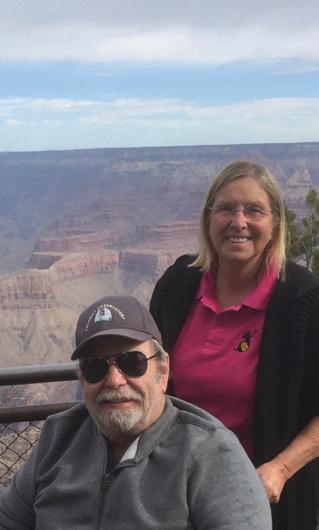
Audrey Moran (and granddaughters, Maggie Jean and Daisy Jo Moran), and Vanessa Gibson (and granddaughter Piper Elle Gibson). His ashes were committed to the ocean off Long Beach, California on October 13, 2023.
A COLLEAGUE WRITES
Bill Brecht is the reason I have worked in the battery industry for over 25 years. I learned everything I know about batteries from him, along with the book, Storage Batteries, by Vinal, that he insisted we all own and read. I’ve often said how fortunate I felt to have started my journey in the battery industry under Bill’s guidance, and to have continued working alongside him for many years afterward. He exemplified a true engineering spirit, consistently devising solutions to challenges and pioneering ideas, which he meticulously validated through comprehensive testing. I had the privilege of participating in many of those projects. Bill was not only intellectually inspiring but also a caring and supportive presence in my life. The days spent working with Bill are some of the most significant highlights of my career.
OBITUARY: BILL BRECHT, 1948-2023 www.batteriesinternational.com Batteries International • Spring 2024 • 19
Bill and Laura at the Grand Canyon
A student hovercraft project in 1971, to elegant boating in his later years
EUROBAT has hit the campaign trail ahead of European elections in June that could supercharge the fortunes of the battery industry, or see political support wane if voters turn away from green energy, says John Shepherd.
EUROBAT EU elections manifesto launch — batteries on the ballot
Elections to the European Parliament will take place in June and could be pivotal in shaping the future of battery technologies.
EUROBAT, the European association of automotive and industrial battery manufacturers, hit the campaign trail in Brussels on February 20 with the launch of its own manifesto — a five-year plan featuring policy proposals to help shape the post-election agenda in support of the industry.
The event was both imaginative and necessary, as could be testified by the 150 or so who attended.
Champagne and canapés were served up to welcome guests even before the event had begun inside the art deco Résidence Palace — originally the city’s first luxury apartment block that was designed in the 1920s for the city’s bourgeoisie and aristocracy.
One mischievous member of the throng mused on the parallels of an industry raising its glass to a sparkling future amid rising energy and manufacturing costs, just as legend says Nero fiddled away in opulent surroundings while a great fire engulfed Rome.
Today, Résidence Palace is home to the International Press Centre,

suitably located in close proximity to the headquarters of the European Commission.
The location was ideal for ensuring a blaze of publicity that could only serve to impress on the press and politicos the importance of the battery industry to Europe’s future.
Suitably fizzing with anticipation, delegates were ushered in to hear EUROBAT’s opening election pitch from association president Marc Zoellner who, as CEO of Hoppecke Batteries, knows the business inside and out.
He said all mainstream battery technologies, namely lead, lithium, nickel and sodium, were vital to underpin-
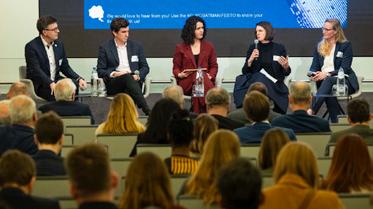
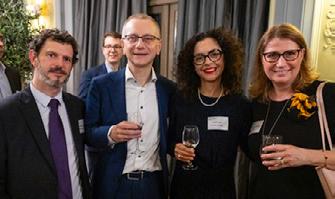
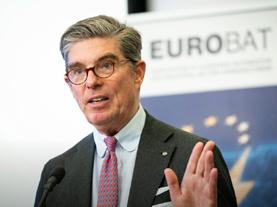
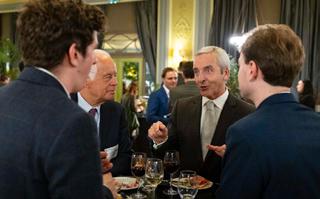
ning the EU’s Green Deal decarbonization and circularity goals.
The entire battery industry should be front and center of proposals to combat CO2 emissions and the clean energy transition.
Zoellner’s words were reassuring to those in the audience who recalled a time not so long ago when lead was viewed by some as the Cinderella of batteries. The technology that was required to do the heavy lifting in the shadows but not be allowed to share the spotlight with newcomers such as lithium.
There are those in the corridors of power in Brussels that still not dare give lead the credit it is due, but times are changing.
Keynote speaker, German Christian Democrat European Parliament member Peter Liese, issued an impassioned cry for all battery tech to be deployed as best suits requirements.
Liese also made clear he and other politicians welcomed the departure last year of former Green Deal supremo Frans Timmermans, who was widely regarded as a thorn in the side of the lead battery sector.Liese diplomatically described Timmermans’ time as former European Commission executive vice president as “problematic”. (See facing panel.)
And in the spirit of transparency, Liese explained why he also had a personal interest in ensuring the success of batteries: he has a son working for Hoppecke.
The EUROBAT manifesto was billed as “key asks” or recommendations for those who will decide the direction of travel for the EU over the five years from June 2024 based on three pillars: innovation, a “global level playing field” and circularity.
One of the manifesto’s key recommendations is the appointment of an EU commissioner with specific responsibility for safeguarding the bloc’s battery materials supply chain.
Peter Javorčík, the Commission’s
NEWS FOCUS: EUROBAT THINKING 20 • Batteries International • Spring 2024 www.batteriesinternational.com
David Shaffer, EnerSys and Stefan Stübing, Exide






Hammond’s innovative signature products, SureCure® and Treated SureCure®, are two of more than 150 customized additives that are improving battery performance and lowering manufacturing costs for battery manufacturers around the world.





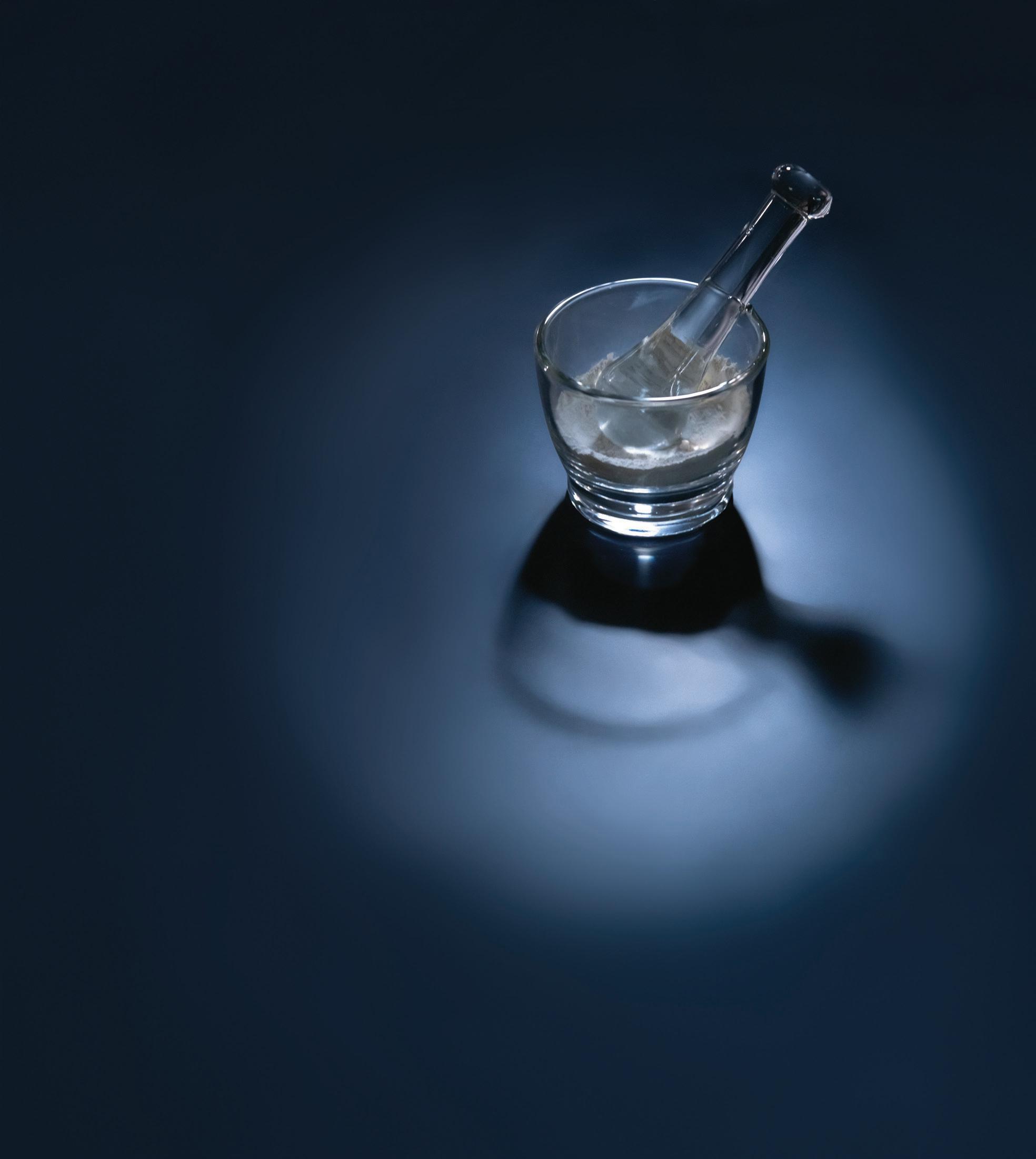
CEO Terry Murphy kicks off Hammond's '2024 & Beyond' video series with this declaration: "There are NO shortcuts." Drawing upon their long-term institutional and industry knowledge, Murphy, COO Gordon Beckley, and other members of the management team from R&D and manufacturing offer unique insights on the importance of people, research, supply chains, product innovations, industry collaborations, environmental
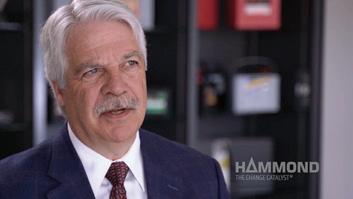
manufacturers around the world and providing chemical innovations that help drive the industry's evolution in energy storage. Explore ’2024 & Beyond’ at hammondglobal.com/2024-and-beyond Hammond Unveils

goals, and the ability to adapt in facing industry challenges. As Battery Council International celebrates a major milestone this year, Hammond Group reflects on 90-plus years of supporting battery
HAMMONDGLOBAL.COM INFO@HAMMONDGLOBAL.COM
150+
Advanced Battery Chemistry 90+ Years.
Products. One Focus.
INDUSTRY NEWS
‘2024 & Beyond’ Short Video Series Giving Insight into Industry-Leading Process & Priorities
current director general for transport, energy, environment and education, rejected the idea of a dedicated commissioner for strategic autonomy, saying the task should be uppermost in the minds of all commissioners.
He was followed on to the stage by a panel including Inga Petersen from the Global Battery Alliance, William Roberts from Rho Motion, Céline Domecq from Platform for Electromobility and Christian Rosenkranz — VP for sustainability and corporate affairs EMEA at Clarios and chairman of the Consortium for Battery Innovation.
It was a pity Javorčík slipped out of the event and did not take part in the subsequent hour-long panel discussion, although such luminaries frequently depart quickly before they have to mingle with delegates’ questioning — more than could be said for the time it takes to get legislation on to the EU statute books.
In the event there was no time for any members of the audience to put a question to the panel, which was far from ideal. Nevertheless, the mini conference catalyzed many of the substantial issues that will arise on the election trail and that can impact the battery industry.
According to the European Council on Foreign Relations, the European Parliament elections will result in a major shift to the right, with populist radical right parties gaining votes and seats across the EU, and centre-left and green parties losing votes and seats.
In a policy brief published in January, the ECFR said a populist right coalition of Christian democrats, conservatives, and radical right MEPs could emerge with a majority for the first time.
This sharp right turn is likely to have significant consequences for European-level policies and the biggest post-election policy implications are likely to concern environmental policy.
In the current parliament, a left/ center-left coalition has tended to get its way on environmental policy issues, but many of these votes have been won by small margins. A significant shift to the right in the new parliament would mean that an anti-climate policy action coalition could dominate.
This would deeply undermine the EU’s Green Deal framework and the adoption and enforcement of common policies to meet the EU’s net zero targets.
Protests across Europe before and after the manifesto launch highlight the political volatility across the region.
Some of Europe’s major cities have been engulfed by protests from angry farmers and food producers who say climate policies, increasing costs and tiny margins are threatening their livelihoods.
At one point towards the end of February, acrid black smoke engulfed parts of Brussels as farmers burned tyres and used fossil-fuel guzzling trac-
tors to block the boulevards. So have the farmers planted the seeds of political change that indicate a move away from the EU’s cherished Green Deal policies? Europe is at a political crossroads and the fortunes of the battery manufacturing sector and associated supply chains, like it or not, are inextricably linked to the EU’s political fate.
THE ‘PROBLEMATIC’ TIMMERMANS YEARS
The lead battery industry can breathe a sigh of relief and help energize Europe’s clean energy transition now one of the industry’s bogeymen — former EU Green Deal supremo Frans Timmermans — is out of office, a senior MEP has said.
German Christian Democrat European Parliament member Peter Liese, speaking at the launch of EUROBAT’s manifesto in Brussels on February 20, said: “We should not go back to the Timmermans years.”
Liese diplomatically described Timmermans’ time as former European Commission executive vice president in charge of the Green Deal as “problematic”.
“Since Timmermans has left we’ve had a different focus,” he said.
In June 2020, when in charge of the Green Deal, Timmermans issued an implicit warning during a EUROBAT webinar that the future of the lead battery industry was limited.
“We have to assess which technologies have reached a maturity that will not allow more innovation, we shouldn’t be throwing money at those,” he said. “We look at things that have a future rather than things that have had a great past” — implying that the Commission was eager only to advance lithium batteries over lead ones.
“We are more reluctant [to invest] when a technology doesn’t seem to have much potential for development and has a huge negative impact on the environment … we’re technology agnostic but we’re not stupid.”
One industry commentator at the time said: “I was dumbstruck when he said this … phrases like a ‘technology’ ie a battery chemistry with no potential for development but a great past and having a huge negative impact on the environment and the like. There was no doubt

Liese: “Since Timmermans has left we’ve had a different focus”
he was mentioning lead batteries — what else could he possibly have been talking about?”
Timmermans resigned his post last August to stand as a candidate in the Netherlands’ general election. He was replaced by Maroš Šefčovič. His apparent animosity to the lead battery sector was a major area of concern for lead battery manufacturers and an issue frequently highlighted by Batteries International
Timmermans also issued a preposterous soundbite just months after the Russian attack of Ukraine, saying Europe was on the cusp of achieving energy self-sufficiency, if it had not already done so.
However, industry observers point out that even today the EU has a long way to go — as evidenced by EUROBAT’s call for the appointment of an EU commissioner with specific responsibility for safeguarding the bloc’s battery materials supply chain.
Meanwhile, Liese used EUROBAT’s manifesto launch to also confirm a Batteries International article, published last November, that a decision on controversial proposals for lead metal to be added to an expanded European chemicals authorization register has been shelved until late this year at the earliest.
NEWS FOCUS: EUROBAT THINKING 22 • Batteries International • Spring 2024 www.batteriesinternational.com
EV lithium battery recycling activities in Europe risk grinding to a halt within months, shaking investor confidence in the sector, if new waste classification rules come into force, Batteries International revealed in January.
EV battery recycling chaos alert as EU waste rules loom
Proposed EU regulations designating lithium black mass as hazardous waste — which could limit its storage before processing to just six months — could be in force by the summer.
However, industry insiders warn the move, coupled with existing bottlenecks disrupting shipments of used lithium batteries for processing between EU member states, could be a hammer blow for Europe’s fledgling recycling sector — depriving battery manufacturers of domestic supplies of raw materials.
The warning comes just weeks after trade associations urged EU leaders to scrap “cumbersome, lengthy and costly” processes holding back lithium battery recycling services and hampering competition.
Julia Poliscanova, senior director of vehicles and e-mobility for clean transport campaign group Transport & Environment, confirmed to Batteries International on January 15 that the European Commission is planning to designate black mass as hazardous.
Regulations
Poliscanova said experts in the sector met to discuss the proposals last November and the Commission’s Joint Research Centre (JRC) is now compiling final recommendations.
“We expect the JRC’s report to come out in the first quarter of this year and to recommend designating black mass as hazardous,” Poliscanova said.
If the Commission accepts the recommendation, it has the power to immediately amend existing waste regulations.
Transport & Environment’s raw materials policy officer Franziska Grüning told Batteries International on January 17 that the smooth functioning of inter-EU waste transportation is key to enhancing the recycling industry and ultimately advancing the EU’s circular economy plans.
He warned that the hazardous waste classification could hinder the efficient collection of batteries as companies
would be required to follow stricter requirements on declaration and notification.
Digital systems
However, he said the Commission could consider exemptions that would allow initial transports of lithium battery waste to be delivered to designated processing facilities.
Grüning said the Commission has already reviewed regulations on waste shipments and proposals on the table include using digital systems to keep track of such cargoes within the EU.
The European Battery Recycling Association (EBRA) says disruption in the materials supply chain is inevitable, “given the low number of existing battery recycling facilities across the EU, and the fact that there is often only one facility or sometimes no facility in a country”.
EBRA has called for battery manufacturing waste to be classified according to the battery’s chemistry.
As pressures on the sector increase, German chemicals giant BASF and Stena Recycling announced a new EV battery recycling partnership on January 9.
Prototype
Stena said it will collect, assess, and pre-treat end-of-life batteries and battery production scrap to produce black mass at its facility in Halmstad, Sweden.
BASF will further process and refine the black mass at its battery recycling prototype metal refinery in Schwarzheide.
Asked about potential disruptions to lithium recycling in Europe, Stena’s product area manager for batteries, Marcus Martinsson, told Batteries International: “From an industrial point of view, we do not wish to store black mass any longer than necessary, due to the general risk and raw material exposure.
“We therefore hope that a restriction in storage of black mass would be balanced with swift permit approval
processes to allow for efficient transport of material across borders in Europe.”
The president of BASF’s catalysts division, Daniel Schönfelder, who is also responsible for the company’s battery materials and battery recycling business, said: “We believe that black mass exports to non-OECD countries should be banned.”
‘Shut downs’
“However, this is not yet the case across all Europe and we support the EU’s action to establish a Europe-wide binding regulation.”
On black mass, Schönfelder said storage was needed “to a certain extent” to support reliable material flows for production and refining.
“If regulation is too strict this can pose challenges to the production and in a worst case can lead to production shut downs if allowed storage limits are reached.”
Ecobat’s VP of global sales Elliott Ethridge said in an article posted on the group’s website on January 8: “If you’re in the recycling market, you’re playing the long game. You can’t be short-term.”
Bottleneck
On challenges facing the sector in Europe, Ethridge warned: “If you can’t export the material, but you also don’t have the capacity to properly refine it, you create a bottleneck that you’ll have to deal with, and that might actually incentivize companies to reclassify the material and not report it correctly.”
According to a study published last month by Germany’s University of Münster, China will become self-sufficient in meeting its needs for key EV battery materials lithium, cobalt and nickel around 10 years before Europe and the US.
The study said China is expected to have the capacity to cater for its domestic demand for lithium from 2059 onwards — but this will not be the case in Europe and the US until after 2070.
NEWS FOCUS: EV RECYCLING www.batteriesinternational.com Batteries International • Spring 2024 • 23
Seven years after the launch of the European Battery Alliance, the EU battery industry is still short of cash and raw materials, while BESS and renewable power projects struggle to get on to the grid.
‘It’s make-or-break time for
Europe’s Green Deal’
In a dire assessment of Europe’s vulnerability in the highly competitive global battery manufacturing sector batteries supremo Maroš Šefčovič, the European Commission’s executive VP for the EU Green Deal, has said the bloc currently supplies only 1% of its own needs for key battery raw materials.
Šefčovič told a European Investment Bank (EIB) forum attended by policymakers, business leaders and academics in Luxembourg on February 8 the EU also needed to find at least €700 billion ($767 billion) in additional investment each year up to 2030 — a staggering €4.2 trillion — to achieve the objectives of the Green Deal and REPowerEU, which is the Commission initiative aimed at ending reliance on Russian fossil fuels before 2030 in response to the invasion of Ukraine.
Securing easy access to new, climate-related financing, is now among the “make-or-break” conditions for the Green Deal, according to Šefčovič.
He revealed that Europe’s “stagnated” power sector infrastructure is in urgent need of an overhaul, with thousands of connection requests including those for renewable energy generation and energy storage facilities being rejected because of insufficient grid capacity and other issues.
However, he said despite concerns about the region’s power infrastructure, he regarded the EU’s combined electricity grids as being the best worldwide — at least for now.
Šefčovič called for the EIB to establish a dedicated ‘sustainable critical raw materials task force’ focusing exclusively on financing projects securing reliable European supplies of key battery materials including lithium, cobalt and nickel.
The task force should be able to take higher risks than a normal bank, innovating new financing solutions to address market failures and acting as venture capital when necessary, he said.
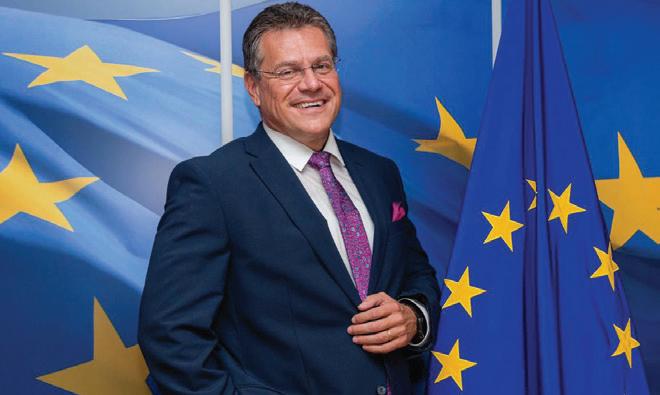
Šefčovič:
The task force could also lead the efforts of national funds dedicated to raw minerals, such as those in Germany (worth €1 billion) and France (€2 billion), and a newlylaunched €500 million fund launched by EU sustainable energy investor EIT InnoEnergy and Demeter, an actor in venture capital and private equity.
Taking more direction action to secure critical raw materials would be in line with a call by EUROBAT, the association of European automotive and industrial battery manufacturers, for the appointment of an EU ‘commissioner for strategic autonomy’ with specific responsibility for safeguarding the bloc’s battery materials supply chain. (See our report elsewhere in this issue.)
The Commissioner’s remarks are his starkest to date on the challenges facing Europe’s energy sector but he has, so far, declined an invitation from Batteries International sent via his team to comment in depth.
The grid, the grid
However, this magazine has unearthed a briefing document prepared by the European Commission that analyzes
these problems in greater detail.
The briefing, appropriately titled Grids, the missing link — an EU Action Plan for Grids, was released a few weeks before last Christmas.
According to the briefing, the electricity network that zigzags the 27 member states of the EU internal market spans more than 11 million kilometres.
The briefing acknowledges that, in many EU countries, renewable generation projects face long waiting times to get connection rights.
Waiting time for permits for grid reinforcements are between four to 10 years, and eight to 10 years for high voltages.
Connection backlogs in the distribution grid are escalating rapidly, with several thousand new requests per month for a single medium-size distribution system operator, according to the briefing.
And in the face of uncertainty over connection timelines, permitting procedures and costs, projects are being stalled and even scrapped.
Comparing Europe’s challenges with other countries, the briefing said the US estimates the need to expand that nation’s electricity transmission
NEWS FOCUS: EUROPE’S MISSING 99% 24 • Batteries International • Spring 2024 www.batteriesinternational.com
EU needs €4.2 trillion by 2030 to achieve planned objectives
systems by 60% by 2030.
Meanwhile, China’s State Grid Corporation has announced investment of just over Rmb 1 billion ($142 million) in power grids in 2022-23.
The briefing references International Energy Agency data, released in October 2023, that says more than 80 million km of grids are needed worldwide by 2040 — the equivalent of the entire existing global grid.
The agency estimated around 1,500GW of advanced renewable projects are waiting in grid connection queues globally.
However, while accepting the need for more investment in grids, the European Commission’s briefing points out that grid operators cannot do this in isolation.
Grid operators, both at the transmission and distribution levels, are faced with an unprecedented increase in the volume of capital expenditure, the briefing said.
For example, the size and rapid extension of a company’s investment programme may affect its credit rating, with negative consequences in trying to secure finance.
That is why a new range of tailormade financing products and instruments to support grid investments is needed.
Fears over cybersecurity are another factor in the need to nurture ‘homegrown’ European solutions to expand and modernize grid infrastructure.
Relying on third country suppliers to meet critical energy infrastructure needs, in particular nations “not aligned with EU values and positions”, can create risks in terms of cybersecurity and the potential weaponization of such supply chain dependencies, the briefing warned.
And it is not only battery makers who have concerns about securing raw material supplies. The briefing said EU grid operators also face challenges in getting sufficient access to raw materials such as copper or steel.
Given the ambitious deployment objectives, boosting domestic production capacities and diversification of supplies of raw materials and key components will have to be pursued domestically and via EU agreements or partnerships with reliable third countries.
“As insufficient investment in distribution grids and storage is already hampering citizens and businesses, a new approach to identify and support local grid projects appears necessary to prevent gaps in the future.”
PUTTING IT ALL TOGETHER
According to Eurelectric’s Power Barometer 2023 study, Europe has suffered a stagnating rate of electrification of around 20% for the past 15 years.

(In the graphic, FF55 refers to the EU’s target of reducing net greenhouse gas emissions by at least 55% by 2030.)
BANKING ON BATTERIES, BUT RUNNING ON EMPTY
The association, which represents the common interests of the electricity industry at a European level, said decarbonizing Europe, extricating the bloc from dependency on Russian fossil-fuel supplies and ensuring long-term fossil-fuel-free energy sovereignty, requires a tripling in electrification by 2050. The European Investment Bank, which is owned by EU member states, has yet to respond officially to Šefčovič’s proposals and would not comment on his specific remarks.
Sources told Batteries International on March 5 that bank chiefs had a “positive” opinion on the critical raw materials task force proposal.
However, in an on-the-record comment, an EIB official said coordination efforts at the EU level are important to avoid fragmentation in the support of the development of infrastructure needed for the green transition.
“We are working closely with the European Commission and industry to bridge gaps by providing financing at advantageous rates,” the official said.
Research by Batteries International shows that, over the past three years, the EIB financed electricity networks in the EU at an average rate of nearly €4 billion annually.
Last summer alone, the EIB announced €45 billion in additional financing, on top of the bank’s
regular lending sums, to support the REPowerEU plan and European manufacturing in state-of-the-art ‘strategic net-zero technologies’. Eligible projects also include investments in the extraction, processing and recycling of EU-designated strategic critical raw materials.
A battery industry insider who has a particular focus on the EU market told Batteries International on condition of anonymity: “The eye-watering sums that the EIB has already poured in to try and shore up Europe’s entire energy sector show that investment alone is clearly not the answer to the challenges faced.
“Seven years after the European Battery Alliance was launched, the EU has precious little to show for the billions of euros invested to date.
“It also cannot be right that the few gigafactories Europe has to date cannot rely on secure supplies of raw materials. Meanwhile, BESS and renewable energy projects risk being scrapped because of delays in securing connections to grids.”
NEWS FOCUS: EUROPE’S MISSING 99% www.batteriesinternational.com Batteries International • Spring 2024 • 25
Graphic: Eurelectric
Ford’s EV investment slow-down, $5bn loss, unsettles battery investors
Ford looks set to continue a freeze on selected investments in its EV business after revealing the unit’s $4.7 billion loss outstripped overall net income of $4.3 billion in 2023, which one industry commentator said equates to nearly $65,000 for each EV it sold.
CFO John Lawler said on February 6 that mainstream customer take-up of EVs was happening at a slower rate than the industry expected — and he reiterated last year’s shock announcement that the auto giant had “deferred
certain capital investments” in EVs until they’re justified by demand.
However, Lawler insisted EVs are here to stay and said it is developing next-generation EVs that will “surprise customers” and be profitable within a year once launched.
Industry observers have told Batteries International the move will unsettle investors in the lithium battery supply chain — and the slowdown in sales of EVs will likely lead analysts to revise forecasts for the fortunes of the lead battery sector.
Meanwhile industry
commentator Robert Bryce — who said last November that Ford was facing up to the “truth bomb” that motorists don’t want to pay a premium for EVs — said on February 7 the firm’s losses are only part of a train wreck in the EV market.
“Perhaps the most remarkable thing about the staggering losses at Ford and the other automakers is that the carmakers didn’t understand the limited appeal of EVs,” Bryce said.
According to Bryce, who hosts the Power Hungry Podcast, EVs are a niche
market, primarily defined by class and ideology, with some 57% of EV owners in the US earning more than $100,000 annually, 75% are male and 87% are white.
Last October, Tesla CEO Elon Musk said he was concerned about the impact of high interest rates on car buyers and said the firm was hesitating on its plans for a factory in Mexico as it assesses the economic outlook.
“You know the EV business is in trouble when Musk makes such comments,” Bryce said.
GCube study charts BESS ‘failures’, warns insurers need confidence
More than half of BESS failures happen within the first two years of operation, according to analysis published by renewable energy projects insurance underwriter GCube yesterday.
GCube said its report — Batteries Not Excluded: Getting the Insurance Market on board with BESS — is based on analysis of 12 years of public BESS
failure data. However, the company said underwriters are increasingly supporting the battery storage sector, but need confidence about the management of thermal runaway risks, public safety liabilities and transportation “challenges”.
GCube itself expects BESS assets to represent 30% of its underwritten renewables portfolio by the end of this year.
Key findings include that, overall, the market now has around 10 failures reported on average each year — a 10=fold increase compared to 2016.
While this escalation suggests an expanding battery market, it also highlights the absence of well-established safety and reliability procedures.
GCube says while the statistics broadly align with
industry growth, there is concern that failure trends may persist as the market deploys larger 100MW+ utility-scale assets, leading to increased financial losses for owners, developers, and insurers.
“This concern arises from a recurring pattern in rapidly expanding market segments, where new technologies often face challenges related to quality control — a dynamic recently observed in the offshore wind market,” the report said.
US-based speciality chemicals producer Albemarle said on February 20 it had agreed a battery-grade lithium hydroxide supply deal with BMW.
Under the multi-year agreement, which starts next year, the companies will also partner on technology to develop next-generation lithium ion batteries for EVs.
Albemarle said its agreement is the second with BMW, but the first to include a shared interest in research opportunities to accelerate lithium
battery innovations. But the agreement comes against a backdrop of a fall in global interest in EVs, with motorists reluctant to switch amid concerns over the vehicles’ high price tag and availability of charging stations.
The sudden and sustained drop in the price of lithium to what one analyst called “totally unsustainable levels” is set to reverse, however. The issue is when.
Last October, Tesla CEO Elon Musk said he was concerned about the impact of high interest rates on car buyers and said
the firm was hesitating on its plans for a factory in Mexico as it assesses the economic outlook.
Meanwhile industry commentator Robert Bryce — who said last November that Ford was facing up to the “truth bomb” that motorists don’t want to pay a premium for EVs — has said the firm’s losses are only part of a train wreck in the EV market.
“Perhaps the most remarkable thing is that the carmakers didn’t understand the limited appeal of EVs,” said Bryce.
GCube urges developers and owners to take measures including ensuring sufficient spacing between battery modules and careful selection of the most appropriate battery tech for projects.
Fraser McLachlan, GCube founder and CEO, said: “We don’t want to repeat the mistakes of the past of allowing growth in deployment and technological scale to take priority over quality control, and the large-scale losses and market destabilization that are possible to result from that.”
NEWS 26 • Batteries International • Spring 2024 www.batteriesinternational.com
Albemarle signs new BMW lithium deal, but EV sales slump persist
The expander may be negative, but your experience will be entirely positive.
The job of negative expander is to reduce strain, maintain capacity and improve performance. In a way, that’s our job, too.
TEXEX ® NEGATIVE EXPANDER
At APG, we deliver the best products and customer satisfaction in the industry through unwavering focus and personal relationships.
We offer the best pre-blend negative expander on the market, brought to you by a certified Women’s Business Enterprise and family-owned company you know and trust.

Find out more at atomizedproductsgroup.com info@atomizedproductsgroup.com
Terra Supreme Battery set to launch bipolar lead battery plant in Indiana
Supreme Battery is set to launch production of its Group 31 battery — based on what it describes as a composite grid bipolar AGM lead acid chemistry — at its plant in the US, Batteries International has learned.
TSB co-founder, CEO and president Nick Busche told Batteries International on February 1 that around $33 million has been invested in setting up the Albion, Indiana advanced lead battery manufacturing project to date, with manufacturing set to start in May and full production beginning in September.
The company has not disclosed details of its bipolar technology, but said initial production capacity shall incrementally increase and double in 2026.
TSB said the facility, comprising five standalone buildings across a total 120,000ft2, will deploy automation and robotics and meet the highest environmental responsibility standards.
The Group 31 batteries are the initial product offering — targeting sectors including trucking, local delivery, marine, railroad, renewable energy storage in both residential and utility scale, data center back-up power and military market segments. Busche said TSB
has already attracted a lot of interest from multiple industry sectors as the need for Group 31 batteries exceeds the global supply.
‘Enormous opportunities’ Busche said: “Compared to current flooded and AGM technology, TSB’s composite grid bipolar technology has overcome the limitations and failure points to provide significantly improved power output, fast charging, greater depth of discharge and number of charge/ discharge cycles comparable to lithium chemistries at a premium lead acid price point.”
Busche said the company believes there are enormous opportunities for its batteries in multiple vertical markets.
TSB has acquired equipment to manufacture batteries using technology that it claims replaces industry-standard cast-lead grids with a proprietary co-extruded lead-impregnated glass fiber woven into a square-mesh grid. This provides dimensional stability and solves several issues associated with lead acid battery failure, Busche said.
“The bipolar grids utilize proprietary nano-dimension, metal-free energy-storage materials that deliver up to 25% more
capacity per gramme than conventional energy-storage materials.”
Some equipment was acquired from a former battery manufacturing plant in Oklahoma and reconfigured for production in Indiana.
New BCI member
According to Busche, proprietary arrangement of the bipolar plates in standard Battery Council International (BCI) package dimensions results in batteries delivering 2,000 charge discharge cycles at 80% depth of discharge with an industry leading cold cranking amp rating and a fiveyear warranty.
In applications limited to 60% DOD, TSB claims its tech delivers 4,000 cycles, approximately 11-year service life if charged and discharged once daily.
In partial state of charge, micro cycling applications centered at 50% SOC, the technology has been field tested and delivered over 15 million PSOC cycles with +/- 5% change in SOC per cycle.
TSB, which recently become the newest member of BCI, says its technology is priced as a premium lead acid battery while meeting lithium product performance specifications.
The company claims that, unlike lithium battery chemistries, its composite bipolar technology requires no temperature management to operate under extreme low-temperature conditions and is also intrinsically safe, transportable by all shipping methods and recyclable.
TSB is entering the market against a backdrop of what the company says is a significant shortage of manufacturing capacity in the US.
Storage demands of clean tech and renewable power generation have put tremendous pressure on the existing manufacturing base which can no longer keep up, TSB says.
‘Next-gen manufacturing system’
Despite increasing focus on lithium ion chemistry BESS solutions, TSB says while lithium batteries can meet longevity requirements they exhibit several deficiencies in stationary and mobile applications, have “intrinsic safety issues” and are expensive.
An added expense incurred by lithium-based BESS units is the need for equipment to control battery temperature, while the batteries themselves present what TSB says are “challenging logistical issues in shipping and transportation”.
Busche says: “The most cost-effective solution for energy storage has always been lead acid batteries in either flooded or AGM packaging.
“The traditional objection to lead acid batteries has been the number of cycles delivered at 50% depth of discharge limited to 400, which is 1.1 years of useful life before replacement. However, lead acid batteries have always been attractively priced.”
NEWS 28 • Batteries International • Spring 2024 www.batteriesinternational.com
Battery cells developer CustomCells announced its move into a new combined HQ and lab at Itzehoe in northern Germany on January
The company,
said the move will spur innovation. Existing inves-
include
Ventures and Porsche. An extruder is on order for installation at the facility as operations ramp up. CEO Dirk Abendroth said: “Research is fundamental to reinforce and expand our own
as
He
the
Germany and significantly increase its patent applications from the doubledigit number filed in 2023. The groundbreaking ceremony for the new, four-storey 10,000m2 facility took place in November 2022. The site is set to be expanded by an additional 6,000m2 over the next five years. CustomCells opens new HQ and laboratory in Germany
18.
founded in 2012 as a spin-off from the Fraunhofer Institute,
tors
VSquared
claim
a premium battery cell manufacturer.”
said
company wanted to continue investing in
ILA in costs warning as new EU workplace lead limits become law
New lower workplace limits for lead set to become law in the EU could create unnecessary compliance costs for battery manufacturers and supply chain firms, industry leaders have warned.
ILA senior regulatory affairs director Steve Binks told Batteries International the rules, made public last year, include a revised binding workplace occupational exposure limit for lead in air of 0.03Pb mg/m3 and a biological limit for lead in blood of 15µg Pb/100 ml.
However, Binks welcomed a transition period — accepted by the EU after campaigning by the ILA — whereby a limit value of 30µg Pb/100 ml blood will apply until the end of 2028.
The updated rules will enter into law when they are published shortly in the Official Journal of the EU. EU member states then have two years to adopt the new limit values into their respective national laws.
The rules replace 40-year EU workplace air lead limits of 0.15 Pb mg/m3 and for employees to have blood lead levels of no higher than 70µg Pb/100 ml blood.
There is also new guidance to protect female workers of childbearing age.
The ILA said the transition period should allow companies sufficient time to introduce the necessary changes in working practices for managing blood lead levels.
Special medical surveil-
lance provisions have also been developed for workers who may have been occupationally exposed to lead over several years, which will minimize any health risks while protecting their employment.
However, Binks warned that some member states could go further and be more restrictive than the EU-wide mandate.
Germany already has a blood lead national value of 15µg Pb/100 ml, which was introduced two years ago. Individual EU states could also decide to adopt the new measures immediately rather than abiding by the transition period.
Binks said: “As an industry we have long adopted
Exide Technologies boosts green credentials with climate targets
European lead acid battery manufacturer Exide Technologies has unveiled plans to achieve a binding target of a 30% reduction in emissions by 2030.
Exide said on February 2 it aimed to mitigate direct emissions and those linked to purchased energy — commonly referred to as scope 1 and 2 emissions.
Exide said it also planned to boost the sustainability of its operations by ensur-
ing that, by 2030, a minimum of 20% of its energy consumption will be derived from renewable power that is generated by the company itself or on its behalf.
The company said it eventually hoped to go beyond 20% by embracing other “environmentally focused initiatives”.
Exide already operates three solar power generating facilities across Spain and Portugal and has three
battery recycling plants.
The company said in March 2021 that it had gone live with a solar plus storage installation at its Portuguese battery production facility at Castanheira do Ribatejo, to store solar-generated power using 500kWh of Exide’s Sonnenschein A600 gel batteries.
The installation followed another in 2020 in Azambuja, just 18 miles away, at a battery recycling facility.
ambitious voluntary guidelines for the reduction of lead exposure for employees in our member companies because the prevailing legislative limits were outdated and not reflective of the available health science or modern exposure controls.
“Our guidelines have seen the average blood lead values for employees in ILA companies fall in 2022 to 11.85µg Pb/100 ml blood and most companies are well on target to meet the EU’s new biological exposure limits.”
But he told Batteries International it was regrettable the European Commission’s impact assessment did not assess the costs or benefits of lowering air lead limits but instead focused entirely on blood lead targets.”.
The revised binding occupational exposure limit for lead in air will create unnecessary compliance costs for many European companies in the battery and other lead-using supply chains, without achieving significant health benefits, Binks said.
During the process of developing the new binding workplace limits all stakeholders recognized that a measurement of internal dosage in the form of regular employee blood lead testing was a better risk management tool than air lead measurements.
India has given the green light to install rooftop solar systems in one million homes, as part of a subsidized program the renewables industry says will boost investment in battery storage and smart energy infrastructure across the country.
India’s cabinet approved the scheme on Febru-
ary 29, just days after the country’s Gujurat state hosted the Smarter E India/Intersolar India 2024 and associated conferences including EES India — organized by Messe Muenchen India, Solar Promotion International and Freiburg Management and Marketing International.
Under the scheme, the government said collateral-free low-interest loans will be offered to buy the solar systems, with purchasers able to sell surplus electricity to power distribution companies. The three-day Smarter E India and associated conferences closed on February 23.
“We need policymakers to understand that proper impact assessments should accompany these decisions to ensure measures are effective and proportionate, and that they do not hamper unnecessarily European companies’ competitiveness and growth potential.”
On the transition period, he said: “We’ve been working on this since the European Chemicals Agency opinion was published in 2020.”
NEWS www.batteriesinternational.com Batteries International • Spring 2024 • 29
Batteries, renewables shine under India solar rooftops scheme
Duke Energy to ‘phase out CATL from supply chain’ after security row
Duke Energy is scrapping a BESS supplied with batteries from Contemporary Amperex Technology (CATL) amid a national security row — and has pledged to “phasing out” the Chinese battery giant’s tech from its entire supply chain, according to US lawmakers.
The move comes after Duke shut down the BESS at US military base Camp Lejeune last December, amid allegations the CATL battery tech posed a poten-
tial threat to national security.
Senior members of the US House Select Committee on the Chinese Communist Party, led by chairman Mike Gallagher, said in a statement published on February 9 Duke had since committed to decommission the CATL battery storage system at Camp Lejeune and will instead install an American alternative.
“Additionally, in our most recent meeting with company leadership, Duke
committed to entirely phasing out CATL products from its supply chain.
“We are grateful to Duke for taking this first step to protect US grid security from Chinese Communist Party-controlled companies operating in Americans’ backyard.”
And in what might be regarded as an ominous warning to other companies, the statement added: “Others that continue to work with CATL, and other companies under the control of the
CCP, should take note.”
Duke has not responded to a request for comment.
CATL has also not responded to requests for comment.
In a statement issued through Reuters last December, CATL said accusations about its batteries posing a potential security threat were false and misleading and that its products had passed rigorous safety and security reviews including those by US authorities and businesses.
Refined lead metal supply exceeded demand in 2023 reports ILZSG study
The global supply of refined lead metal exceeded demand by 92 kilo-tonnes in 2023, according to the latest provisional data released by the International Lead and Zinc Study Group on February 21.
The Lisbon-based group said inventories reported by the London Metal Exchange, Shanghai Futures Exchange,
The Consortium for Battery Innovation has joined a three-year US program to highlight how advanced lead batteries could be deployed as part of a range of technologies for long duration energy storage projects.
The CBI confirmed to Batteries International on February 7 it had joined as a ‘teaming partner’ of the US National Consortium for the Advancement of LDES Technologies.
Launched in January this year, the initiative is funded by the US Department of Energy to bring together players in the
producers, merchants and consumers rose by 123kt and totalled 447kt at the end of the year.
World lead mine production increased in Bolivia, Kazakhstan, Peru and Australia, where Galena Mining commissioned its 95,000 tonne-a-year Abra mine in January 2023.
These increases were partially balanced by reduc-
energy storage sector.
The consortium is led by Sandia National Laboratories with the support of five other national labs — Argonne, Idaho, National Renewable Energy, Oak Ridge, and Pacific Northwest.
The main goal is to promote collaborations to develop and implement strategies necessary to achieve the commercialization of LDES technology within the next 10 years, the CBI said.
CBI’s research and innovation manager Alyssa McQuilling and its technical director Matt Raiford
tions in Europe, Mexico and the US, resulting in an overall rise globally of 1.1%.
Production of refined lead worldwide increased by 2.8% in 2023, mainly as a consequence of increases in Australia, China, Germany, India and the United Arab Emirates, ILZSG said.
The increases were partially offset by reductions in Bulgaria, Italy,
are involved in eight of the program’s 16 so-called ‘tiger teams’ — including technology development, evaluation and testing, demonstrations and deployments, investor confidence and finance.
McQuilling said: “Our experts point out that advanced lead batteries are well suited to inter-day LDES applications. They also see the potential around hybrid long duration systems, combining advanced lead batteries with another technology such as flow batteries to cover both short and long duration response.”
Japan, South Korea, Russia and the UK.
Global demand for refined lead rose by 1%, with increases in Europe, China, India, Mexico and Taiwan being largely offset by falls in South Korea Turkey and the US.
Output of refined lead from recycled material accounted for 66% of global production in 2023, which ILZSG said was a similar share to that recorded in 2022.
Meanwhile, Chinese net imports of lead contained in lead concentrates rose by 15% to total 666kt in 2023. Net exports of refined lead metal rose by 61% and amounted to 183kt.
In 2023, at $2,138, the average LME cash settlement price was 0.6% lower than that in 2022. The highest cash settlement price of $2,331 was recorded on January 4 and the lowest of $1,985 on December 1.
At Rmb15,774 ($2,194), the average Shanghai Futures Exchange cash settlement price in 2023 was 3.3% higher than that in 2022.
NEWS 30 • Batteries International • Spring 2024 www.batteriesinternational.com
CBI puts advanced lead in focus for long duration ESS program
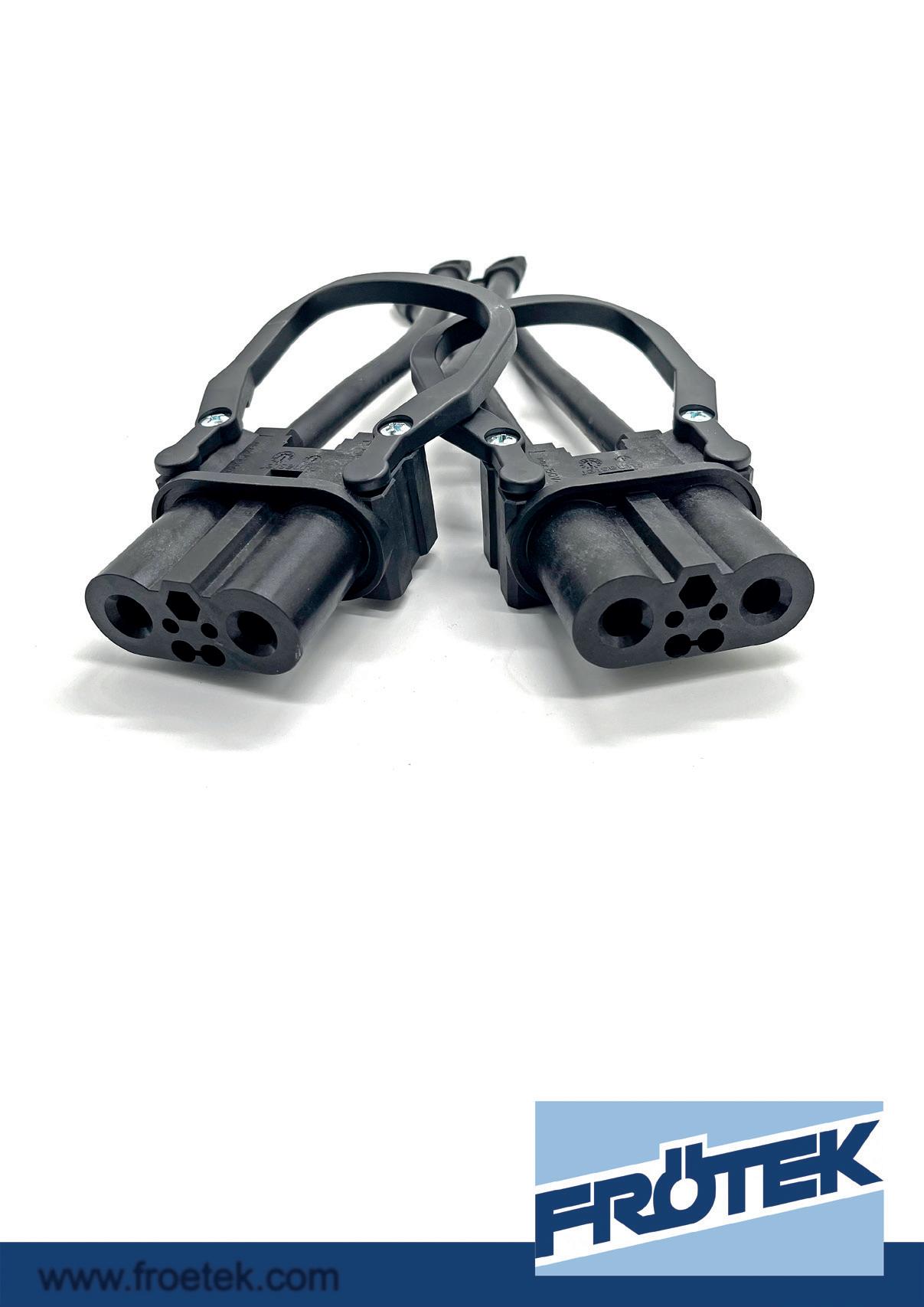

Mutlu Akü battery exports take further hit over Russia sanctions
Lead battery exports for Turkey’s Mutlu Akü have plummeted by nearly 70% over the past year, largely as a result of the RussiaUkraine war, Batteries International has learned.
Mutlu’s owner Metair Investments said in a trading update on March 11 the battery maker’s decision to halt sales to Russia in line with European Union sanctions — plus the cancellation of an order from a key US customer — resulted in Mutlu’s exports dropping from 1.7 million units in 2022 to just half-a-million units.
Hyperinflation in Turkey
also piled pressure on Mutlu and the manufacturer’s overall sales of automotive batteries in 2023 fell to 3.3 million compared to nearly 5 million the previous year. Aftermarket sales dropped to 1.0 million units (previously 1.6 million).
Turkish interest rates increased to 42.5% and annual inflation peaked at 65%, contributing to a rise in interest costs for the South Africa-based Metair group.
This in turn hurt the wider performance of Metair’s energy storage division, which also includes Romanian lead and lith-
ium company Rombat and South Africa’s First National Battery.
Metair said it expects to post a 17% fall in the group’s combined automotive battery sales for 2023 when it publishes detailed results toward the end of March.
In light of the challenges experienced in Turkey, the energy storage division’s revenue is likely to be flat against the previous financial year, with pre-hyperinflation EBIT margin (before impairments) expected to be between 8.5% and 9.5% (previously 9%), supported by the South African battery business.
However, Metair said top line growth in its automotive components business was improving, thanks to a 20% increase in sales to South African OEMs in 2023 over the previous year, despite supply chain disruptions exacerbated by deteriorating rail and port infrastructure in the country.
Paul O’Flaherty recently took over as Metair’s CEO. He succeeded Sjoerd Douwenga — whose resignation for undisclosed health reasons was announced by Metair at the end of 2023y.
EU climate target needs ‘robust plan’ for battery raw materials
EU leaders have been told they must do more to ensure Europe has reliable supplies of raw materials essential for batteries, renewables and other cleantech sectors to underpin climate policies.
Eurometaux, which represents non-ferrous metals producers and recyclers in Europe, said a “robust plan” was needed to support climate target proposals for 2040 unveiled by the European Commission on February 6.
The Commission said it is aiming for a 90% reduction in greenhouse gas emissions relative to the year 1990 by 2040.
The proposals will be considered by the new Commission that will be formed following June’s elections to the European Parliament.
However, Eurometaux director general Guy Thiran said industry needs “more carrots and fewer sticks to thrive across the next two
decades”. According to Eurometaux, much of the EU’s existing metals capacity has already seen “carbon and investment leakage”, including 50% of aluminium, zinc, and silicon capacity curtailing in the last two years.
New raw materials investment is starting to go to the US because of more favourable incentives under the Inflation Reduction Act (IRA), which Eurometaux said offers a simplicity and
Exide Technologies acquires Li battery tech firm BE-Power
European lead acid battery manufacturer Exide Technologies said on March 11 it had acquired German lithium battery tech firm BE-Power for an undisclosed sum.
BE-Power, which develops and assembles battery and power modules, was founded in 2004 by Volker Klein.
Klein has more than 30 years of experience in lithium ion technology.
BE-Power and its proprietary battery management system and software is now part of Exide’s energy solutions division.
Exide president and CEO Stefan Stübing said the acquisition would propel the company to new heights in providing sustainable and cuttingedge energy storage solutions.
Batteries International reported recently on
Exide’s plans to achieve a binding target of a 30% reduction in emissions by 2030.
The company, which already operates three solar power generating facilities across Spain and Portugal and has three battery recycling plants, said it eventually hoped to go beyond 20% by embracing other “environmentally focused initiatives”.
certainty that Europe has yet to equal.
Eurometaux communication director Chris Heron told Batteries International capital and operating expenditure in Europe is much higher than any other parts of the world, and IRA subsidies have expanded that gap.
Heron said 50% of the EU’s aluminium, zinc, and silicon capacity is still offline today as a result of Europe’s energy crisis.
Eurometaux president Evangelos Mytilineos said securing the raw materials Europe needs will be of ever-growing strategic importance.
“Every tonne of metal that Europe stops producing at home will be replaced by higher-carbon imports from the capacity ramping up abroad.”
Eurometaux urged EU leaders last November to scrap “cumbersome, lengthy and costly” processes holding back lithium battery recycling services and hampering competition.
NEWS 32 • Batteries International • Spring 2024 www.batteriesinternational.com
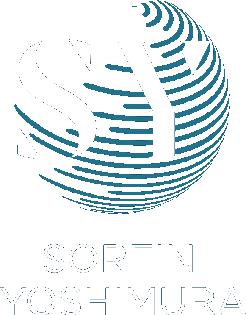





USA: sorfin@sorfin-yoshimura.us
CHINA: qingdao@sorfin-yoshimura.cn
BRAZIL: vendas@sorfin.com.br
THAILAND: jiroyoshimura@sorfin-yoshimura.jp





JAPAN: tokyo@sorfin-yoshimura.jp
FRANCE: paris@sorfin-yoshimura.fr
MEXICO: dbortoni@sorfin-yoshinura.us
INDIA: sales@sorfin-yoshimura.in
WE’VE GOT YOU COVERED
www.sorfinyoshimura.com
SY Innovations: agurevich@sy-innovations.com
NatPower plans to create new generation of UK BESS ‘gigaparks’ with £10bn renewables
NatPower is to develop 60GWh of battery storage in the UK as part of a £10 billion ($13 billion) package of investment in renewables, the group announced on March 7.
The UK arm of the European energy group said it will apply for planning permission for the first of three battery gigaparks this year and 10 more in 2025.
NatPower has earmarked £600 million to develop new
substations — strengthening the UK’s ability to feed more renewable power into the grid.
The group will also announce new solar and wind projects for the UK this year.
Stefano Sommadossi, CEO of NatPower UK, said investing in the grid and working with grid operators was key to solving bottlenecks slowing the shift to clean energy.
“By investing in substations and focusing on energy storage first, we will enable the next phase of the energy transition and bring down the cost of energy for consumers.”
Meanwhile, the founder director of UK clean energy developer Kona Energy, Andy Willis, warned on March 12 the UK must do more to tackle grid connection delays.
Commenting on UK
Telangana boost for Amara Raja giga corridor investment project
Leaders of India’s Telangana state government pledged further backing for national battery giant Amara Raja’s ‘giga corridor’ investment plans, in talks held on January 3.
Amara Raja broke ground in May 2023 for its 16GWh lithium battery cells factory and research complex in Telangana.
The lead and lithium battery manufacturer — renamed Amara Raja Energy & Mobility last September — said the project would feature advanced laboratories and testing infrastructure for material research, prototyp-
AAC secures
The Automotive Cells Company has secured €4.4 billion ($4.8 billion) debt to support construction of three European gigafactories, in addition to the lithium ion facility it opened in France last year.
ACC said on February 12 the finance boost would accelerate its expansion of battery cells and modules production for EVs.
The new plants will be in France, Germany and Italy
ing, product life cycle analysis and proof of concept demonstration.
Amara Raja chairman and MD Jayadev Galla said in the January 3 talks with Telangana leaders that the state has the potential to become “a major force in the growing EV and new energy sector”.
Galla thanked ministers for the government’s support for the giga corridor project as part of an expansion of Amara Raja’s operations in India.
Telangana chief minister Revanth Reddy indicated the state was ready to step up support for attract-
ing increased investment for the project. He said promoting clean energy and battery storage technologies was a priority for the state.
Telangana has already agreed a memorandum of understanding with Amara Raja Advanced Cell Technologies (ARACT), a wholly owned subsidiary of the battery group, which has been working on Li ion cell chemistries specifically suited for Indian subcontinent conditions.
ARACT already supplies lithium battery packs and chargers to some two and three-wheel vehicle OEMs.
billion debt for new gigafactories
and ACC, which is backed by Stellantis, MercedesBenz and TotalEnergies-owned Saft, said it would also step up R&D investment.
The debt is underwritten by a consortium of commercial banks including BNP Paribas, Deutsche Bank and ING.
ACC chief executive Yann Vincent said the firm’s customers must be able to rely on robust and
reliable European players capable of delivering high volumes of competitive batteries with a low CO2 footprint.
He said more production sites could happen in the future. “We will determine our needs as and when we conclude additional contracts. We are resolutely looking to the future, with a view to achieving our objective of growing our production capacities.”.
government plans to build new gas-fired power stations, Willis said: “Arguments for/against gas plants aside, on current grid connection processes any new gas stations would be at the back of the queue and therefore would not be connecting until at least 2037.”
Willis said any projects that can get online fast to increase energy security should be given priority.
Wuxi Lead, Tiamat plan €500m
French sodium ion gigafactory
Proposals for a 5GWh sodium ion battery manufacturing plant in France have been unveiled by Wuxi Lead Intelligent Equipment and Tiamat.
The companies said on February 1 they had formed an alliance for the project in Amiens, backed by investment in excess of €500 million ($538 million), with construction starting for an initial 0.7GWh line in the first quarter of this year.
Batteries will initially start rolling out of the plant in the fourth quarter of 2025, with completion of the entire 5GWh facility scheduled for 2030.
Tiamat CEO Hervé Beuffe, whose company is a spin-off from the French research institute CNRS, said existing and new investment partners were supporting the project, which would tackle “sovereignty and material availability concerns associated with conventional energy storage technologies”.
Shanghai-based Wuxi Lead, launched in 1999, focuses on producing equipment for several industrial sectors including lithium ion batteries.
NEWS 34 • Batteries International • Spring 2024 www.batteriesinternational.com
€4.4
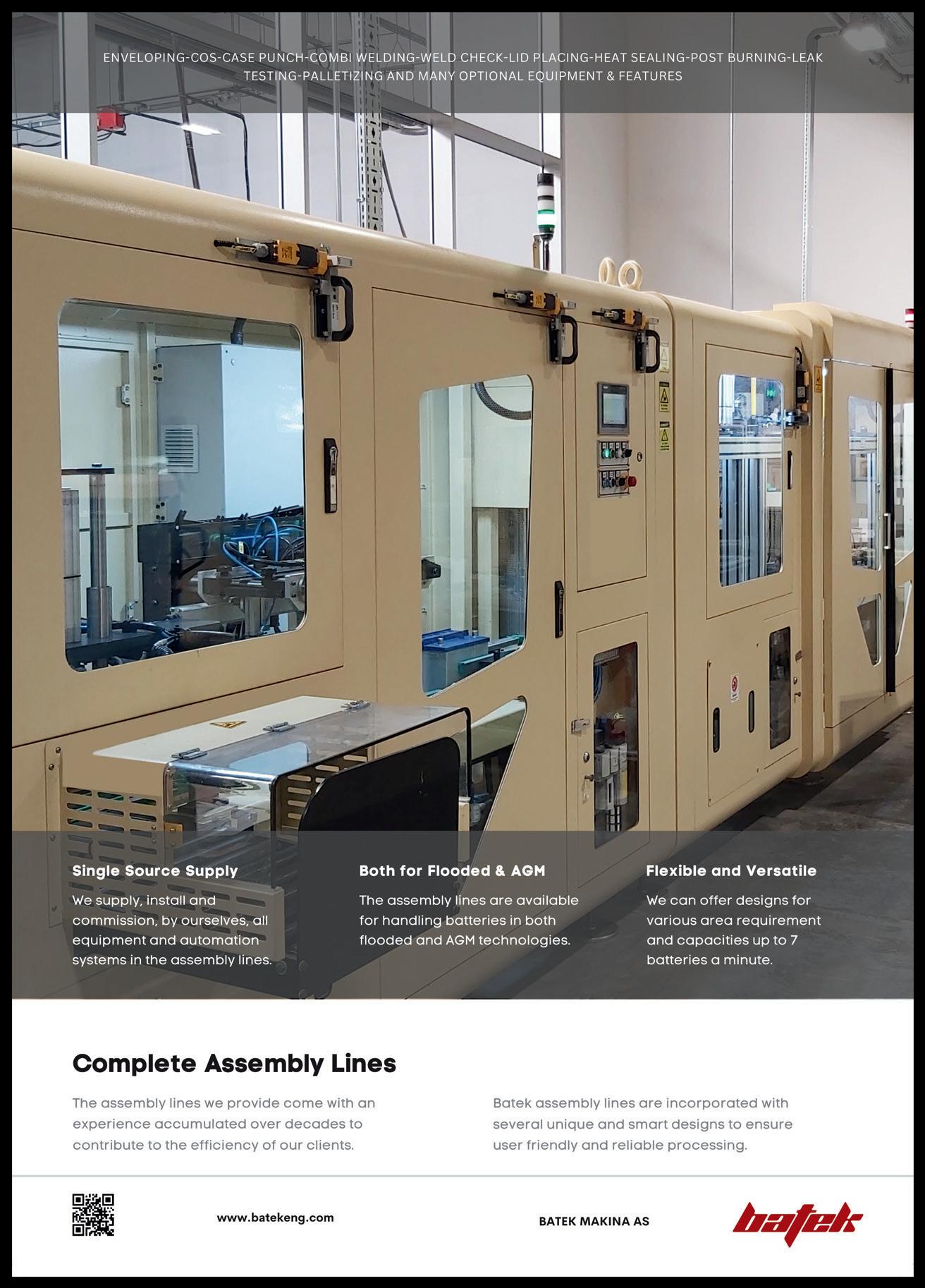
BESS investments in Europe set to surge, says Aurora Energy
Europe is on the brink of a significant surge in gridscale battery energy storage with a sevenfold increase in capacity projected by 2030, according to analysis published on February 13 by Aurora Energy Research.
Great Britain, Italy and the wholesale electricity market for Ireland and Northern Ireland have emerged as the top three sectors for BESS investments in the region.
But Aurora, an energy markets analytics company founded by University of Oxford professors and economists, says Spain and Greece are showing promising signs of “compelling
investment opportunities”.
The third edition of Aurora’s European Battery Markets Attractiveness Report, which examined 24 European countries, says installed grid-scale BESS capacity across the region was 7.1GW in the third quarter of 2023. That is projected to rise to 51GW by 2030 and 98GW by 2050.
These new capacity additions represent a cumulative investment opportunity of €78 billion ($85 billion) up to 2050, Aurora says.
To date, dedicated auctions for standalone or co-located battery storage
in Europe have subsidized at least 1.8GW of batteries in Germany, Greece, and Spain.
Upcoming auctions could procure over 15GW across Europe by 2030, notably 9GW of procurement from Italy’s new storage capacity procurement mechanism, MACSE, which aims to cover both capital and operational costs.
Meanwhile, according to separate analysis released by Wood Mackenzie on February 21, BESS will also play a key role in the energy transition in the Asia Pacific region by 2050.
Wood Mackenzie’s Asia
Pacific Energy Transition Outlook said nearly 50% of the world’s low-carbon technology opportunities will be in that region in the next 25 years.
The report’s base case, low-carbon supply says the current 35% of power generation in the region is set to rise to 75% by 2050. Of that, the share of wind and solar increases to more than 54%.
The rapid growth in variable renewables is projected to be accompanied by adopting energy storage plus hydrogen, small modular nuclear reactors, and geothermal technologies.
Sustainability certification for Birla Carbon, new plants in US, Korea
Carbon additives company
Birla Carbon said on February 8 it had received sustainability certification ISCC PLUS for its manufacturing plants in the US and South Korea.
The International Sustainability and Carbon Certification (ISCC) is a voluntary scheme that helps identify companies providing sustainable and circular raw materials.
The certification for its operations in Hickok (US) and Yeosu (South Korea)
comes after the firm said last May its manufacturing plant in Italy had become Birla’s first to be awarded ISCC PLUS.
Birla Carbon Italy is now certified to produce circular materials such as its Continua 8000 sustainable carbonaceous material. A range of products are covered by the scheme including recycled carbon materials.
Birla president and CEO John Loudermilk said the company has set its sights on gaining ISCC PLUS for
all its plants worldwide — and the certification process is already underway for facilities in Brazil, India, Spain, Egypt and Hungary.
In July 2022, Birla announced it had raised a $50 million loan to refinance part of the capital expenditure incurred for tackling emissions at its North Bend plant in the US.
Separately: Birla Carbon says it is planning two new production sites in Asia to expand its carbon black production capacity by
more than 240,000 tonnes.
The company said on January 22 the new greenfield sites — one in the Indian state of Andhra Pradesh and the other in Rayong, Thailand — would support expected market growth and orders from existing clients.
Investment costs and construction schedules for the new facilities were not disclosed, but Birla said each one would have an initial capacity of 120,000 tonnes operational in 2025 with plans to expand to 240,000 tonnes.
Albania’s Vega Solar Energy has unveiled plans to build a lithium ion battery manufacturing plant in the country in partnership with India’s Sainik Industries.
The companies confirmed on February 27 they had signed a memorandum of understanding for a joint venture project — including developing energy storage systems and inverters.
The agreement was signed in New Delhi on February 23, although details of the proposed partnership, including investment cost and construction timetable for the manufacturing plant, were not disclosed.
Sainik, established in 2005, produces a range of batteries and modules in India under its Getsun Power brand for the BESS, telecoms and solar markets.
Albania’s government said in March 2023 it was ushering in changes to laws to make it easier for renewable energy projects to be sited on agricultural land and other sites.
Prime minister Edi Rama said the government was receiving increasing requests from domestic and foreign investors to support development of renewable energy projects including wind, solar and hydro.
Loudermilk said: “These factories will ensure a secure supply of our products, quality and service, allowing our customers to meet their growth ambitions.”
Previously announced expansions for Hungary and at a post-treatment facility at Patalganga, India, are progressing on plan, the company said.
Birla repurposed more than 70% of its material waste over the past financial year, according to the firm’s 11th sustainability report released last September. .
NEWS 36 • Batteries International • Spring 2024 www.batteriesinternational.com
Vega Solar, Sainik Industries plan Albania batteries joint venture
Tried and tested Improved inside
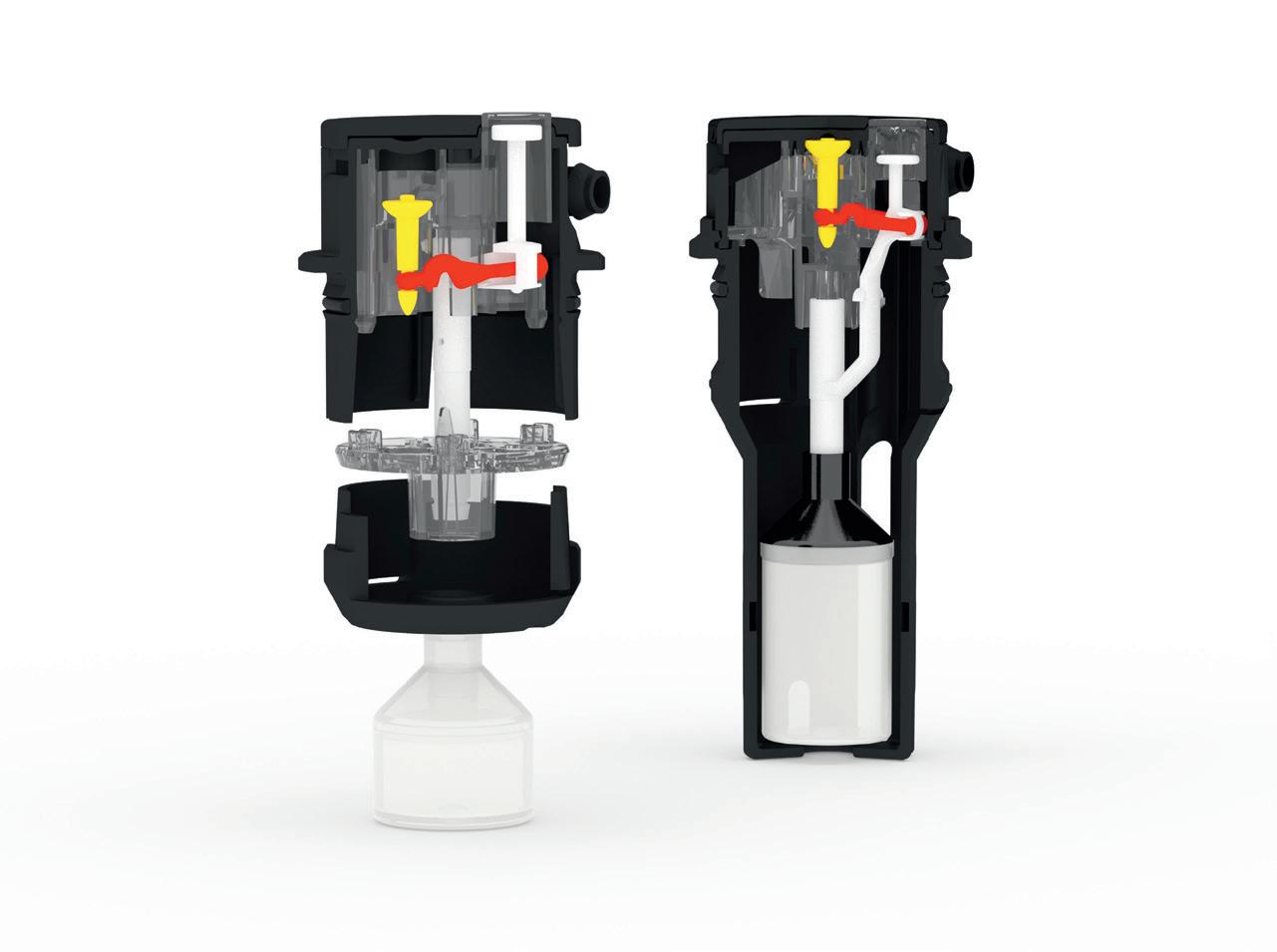
Our genuine system - your first choice
• Highest quality
• Constant improvement
• Excellent performance
• Reliable service
bfs batterie füllungs systeme GmbH info@bfsgmbh.de
Over 40 years of developing and perfecting battery filling products allow us to provide you with the most reliable system focusing on innovation and usability – a valuable contribution to an extended battery lifetime.
Mitterweg 9/11 | 85232 Bergkirchen | Germany bfsgmbh.de | +49 8131 36400
EnerSys picks South Carolina for $500m lithium cells giga-project
EnerSys said on February 14 it had chosen South Carolina as the site to build its planned $500 million lithium ion battery cell gigafactory.
The lead and lithium battery major said it is seeking an incentives package worth around $200 million to support the project — plus potential federal funding including tax benefits under the Inflation Reduction Act.
EnerSys said construction is to start early in 2025 and operations to be online in late 2027.
The 500,000ft2 facility,
with a production capacity of 4GWh annually, will be built on a business park in Greenville. It will produce various form factors of lithium ion cells for commercial, industrial and defence applications.
EnerSys president and CEO David Shaffer said the new plant would benefit a range of customers, including those with specific manufacturing requirements for US-sourced batteries.
The announcement of the project, which is subject to regulatory and other approvals, follows the sign-
ing of a non-binding memorandum of understanding last June with French lithium battery cells developer, Verkor, to consider developing the US gigafactory.
Last October, the European Commission cleared a €659 million ($703 million) French state aid grant for Verkor to support R&D in France into battery cells and modules for the large-scale deployment of EVs.
Verkor laid the foundation stone for its 16GWh per annum lithium gigafactory in Dunkirk in the north of France last November.
Agratas names site for UK gigafactory
Agratas, the Tata Group’s international battery business, confirmed in March the UK location where it will invest more than £4 billion ($5 billion) to build an initial 40GWh battery cell factory.
The Gravity Smart Campus near Bridgwater, Somerset, will host the plant that will eventually create up to 4,000 jobs with thousands more in the supply chain, Agratas said.
Tata chairman Natara-
jan Chandrasekaran said last July the gigafactory would start producing cells in 2026 following a “rapid ramp-up phase” — supplying batteries for EVs and battery storage systems in the UK and mainland Europe.
The UK government, which is reportedly providing hundreds of millions of pounds to support the project, has previously said details will be disclosed at a later date.
According to the UK government, the plant’s initial output will provide nearly half of the battery production that the Faraday Institution estimates the UK will need by 2030.
Tata has said the new plant will deploy innovative technologies and resource efficient processes such as battery recycling to recover and reuse all the original raw materials “to deliver a truly circular economy ecosystem”.
Batteries part of $135bn clean energy investment in 2023, says report
Clean energy tech investment including equipment factories and battery metals production hit a new record of $135 billion in 2023 — up from just $46 billion in 2020, according to new analysis released on January 30.
Clean energy supply chains are split into clean-tech factories making equipment, and battery metal mines and refineries in Bloomberg NEF’s Energy Transition Investment Trends 2024 report.
Combined spending across those areas rose to $135 billion in 2023 and is set to surge, according to the report, with investment plans showing a 66% increase from 2023 to 2024, driven by a bulging pipeline of battery gigafactories.
Meanwhile, overall global investment in the low-carbon energy transition increased 17% in 2023, reaching a record $1.8 trillion.
The report said there was strong growth in emerging areas such as hydrogen (with investment tripling year on year), carbon capture and storage (near-doubling) and energy storage — which increased by 76% to $36 billion.
Celgard said on January 29 it has secured a deal to supply separators required by nickel-zinc batteries developer AEsir.
Under the terms of the agreement, Celgard will supply all battery separators for AEsir’s existing requirements and for its planned US Gigafactory.
The companies will also collaborate on research projects to further develop next-generation nickel-zinc, zinc-air, lithium zinc and sodium-zinc batteries used primarily in aviation, data-
centers, telecoms, energy infrastructure and EV charging applications.
Celgard — a subsidiary of Polypore International, an Asahi Kasei company — says the agreement also paves the way for it to offer separator products to future Ni-Zn and Li-Zn AEsir licensees or joint ventures.
Additionally, Asahi Kasei could support the Ni-Zn supply chain and AEsir will evaluate component supply opportunities for items such as plastic battery packs
and thermal retardant materials.
Celgard’s dry-process coated and uncoated microporous membranes are used as separators in various lithium ion batteries used primarily in electric drive vehicles, energy storage systems and other applications. In February 2023, Celgard said it would step up its partnership with lithium ion tech company C4V as part of a new strategic alliance to develop high-voltage batteries for gigafactories.
BNEF’s head of trade and supply chains Antoine Vagneur-Jones said abundant supply chain investment should continue to reduce equipment prices across most sectors, which is good for the energy transition.
But the “ensuing oversupply heralds an era of squeezed margins for solar and battery manufacturers”.
BNEF deputy CEO Albert Cheung said despite the 17% growth in energy transition investment, the amount needs to grow more than 170% if the world is to get on track for net zero in the coming years.
NEWS 38 • Batteries International • Spring 2024 www.batteriesinternational.com
Celgard, AEsir in Ni-Zn separator supply deal
EnerSys unveils TPPL tech boost for batteries
EnerSys has unveiled details of advances in its thin plate pure lead tech that the company said now offers a major performance boost for batteries.
The optional ‘accelerated throughput package’ (ATP) for select batteries in its NexSys TPPL line was announced on March 5.
EnerSys said the ATP upgrade, available in the EMEA, South America and Asia-Pacific regions, can provide a significant increase in daily energy throughput compared to standard NexSys TPPL batteries — making them ideal for harder-running, higher-reaching class 1 and 2 equipment applications previously
requiring battery changing.
According to the battery maker, the extra energy capability from ATP is achieved through improved thermal management that enables faster, more efficient energy uptake during brief charging periods such as operator breaks, shift changes or any period of non-use.
Senior director of marketing for motive power global, Harold Vanasse, said: “Switching from battery changing to opportunity charging significantly alters battery selection.”
With changing, the battery is removed from equipment and recharged separately, over an extended period of time. This means the crit-
ical factor is overall energy storage capacity — determining how long equipment can work before needing a battery change.
Opportunity charging equipment during breaks and other brief intervals adds energy intake efficiency as a consideration to maintain charge levels, Vanasse said.
EnerSys will be showcasing NexSys TPPL with the new ATP upgrade at upcoming international trade shows.
Batteries International reported last September that EnerSys had secured a new $91.8 million multi-year contract to supply its TPPL batteries to the US Navy as main storage batteries on all four classes of nuclear
ESS starts up long-duration battery
ESS said on January 15 it is using its iron-based flow battery technology to demonstrate how long-duration energy storage could help the US military reduce its consumption of diesel for generators.
An ESS Energy Warehouse system has been coupled with a tactical microgrid at the US Army Corps of Engineers’ Engineer Research and Development Center in Missouri.
The unit replaces a prototype ESS system, installed at the center in 2016.
Gravitricity
Scotland-based gravity storage system start-up Gravitricity said on February 6 it plans to deploy its technology in a prototype project at a disused mine shaft in Finland.
The company has signed an agreement with Callio Pyhajarvi to turn the 530 metre deep shaft at the Pyhäsalmi Mine into a 2MW demonstration project that will connect to the grid and provide balancing services.
ESS said the new system aims to specifically demonstrate the role iron flow battery tech can play in reducing diesel consumption — by as much as 40% — to power generators at remote contingency bases, where the military is needed to respond to conflict and emergency situations.
According to ESS, most contingency bases are powered by diesel generators, but variations in output hampers efficiency. Maintaining generator fuel supplies also increase risks
Gravitricity says its GraviStore system is a gravity-harnessing method of generating electricity by dropping weights in underground areas such as abandoned mines. The company is also working on below-surface green hydrogen storage.
Executive chairman Martin Wright said: “This project will demonstrate at full scale how our technology can offer reliable long-life energy storage
submarines. The company recently said it had chosen South Carolina to build its $500 million lithium ion battery cell gigafactory.
Construction is to start early in 2025 and operations to be online in late 2027.
BMZ adds sodium ion to battery tech range
Germany-based lithium battery systems group BMZ announced on March 11 it is expanding into the sodium ion tech sector.
The company said series production of its new ‘NaTE’ battery cell product range, which will include cylindrical and prismatic cell formats, is to start in mid-2025.
to personnel and ramps up emissions.
The tactical microgrid is additionally being used to test the potential of utilizing solar power and battery storage.
Tom Decker, the center’s operational energy program manager, said: “Flexible, long-duration energy storage, like the ESS system, reduces total runtime on generators while increasing efficiency and allowing generators to last longer at forward operating bases.”
that can capture and store energy during periods of low demand and release it rapidly when required.”
The project announcement comes after Gravitricity secured nearly £829,000 ($1 million) from a crowdfunding raise last May.
A company spokesperson told Batteries International then that it had exceeded its initial goal of £550,000, with 1,085 investors participating.
The first prototypes are already being tested with cell formats 21700 and 46130 and additional cell formats will follow.
BMZ subsidiary TerraE will develop and distribute the NaTE series cells.
BMZ group CEO and founder Sven Bauer said sodium ion technology offered the company and its customers rapidly growing market potential, but said BMZ would not abandon lithium.
“Sodium ion technology is the perfect solution for applications where energy density is not paramount. This includes industrial and home storage systems or industrial trucks, such as forklifts,” he said.
In January BMZ entered the energy storage sector with the launch of its first ESS system — lithium-chemistry based Power Bloxx — for the commercial market.
In February, Shanghai-based Wuxi Lead Intelligent Equipment and France’s Tiamat unveiled proposals for a 5GWh sodium ion battery manufacturing plant in France.
NEWS www.batteriesinternational.com Batteries International • Spring 2024 • 39
plans Finnish mine gravity storage prototype
Dalton Electric announces quality improvements for customers
Dalton Electric Heating, the international split sheath cartridge heater supplier, announced mid-March a series of advances to products and strategies aimed at helping battery manufacturers.
Key to the changes was the hire of George Lantz, vice president of operations & strategy, to oversee Dalton’s transformation, says Chris Stevens, president of Dalton Electric Heating.
“We know unplanned downtime eats into our customers’ throughput,” said Lantz. “So we focused on ways to further minimize their disruptions.” To that end, Lantz has so far led the completion and implementation of improvements in the company’s organization structure, product quality and manufacturing processes. Operational efficiency is what Watt-Flex long life, even heat and superior heat transfer heaters do.
Lantz also led the redesign of Dalton’s organizational structure to improve oversight and quality at each stage of production. “We’ve integrated greater accountability into our process by creating a leadership team to oversee critical areas in our process,” said Lantz. “
New investments to improve coil construction and assembly are two examples of Dalton’s move to “engineer-in quality”.
“These measures ensure coil consistency and verify reliability before they are used in our customers’ equipment,” said Lantz.
Plus Power starts up 185MW Hawaiian BESS
Plus Power said on January 11 it had started operating the 185MW/565MWh Kapolei BESS on the
Hawaiian island of Oahu.
The facility comprises 158 Tesla Megapack 2XL lithium iron phosphate batteries.
Plus Power executive chairman Brandon Keefe said the BESS’s grid balancing capabilities would enable the increased use of renewable power generation on Oahu’s isolated grid and spur a move away from relying on coal and oil.
Keefe said the facility’s virtual inertia systems replicate the power-smoothing function of a spinning turbine, while black start capabilities will support grid recovery in the event of a blackout
The BESS will also act as an electrical ‘shock absorber’ — often provided by combustion-powered peaker plants — “responding in 250 milliseconds rather than the several minutes it takes combustion plants to come online”.
Keefe claimed the company is the first to use batteries “to provide such a diverse range of grid-forming services at this scale”.
Hawaiian Electric senior VP and COO, Jim Alberts, said to date the utility had to regularly curtail or turn off large volumes of existing utility-scale solar and wind to keep the electric system in balance — because solar power fed into the system from homes and businesses has become so abundant, Alberts said.
Stryten ‘Quick Ship’ programs keep supply chain moving
Stryten Energy has launched two ‘Quick Ship’ programs designed to underpin a rapid supply chain for forklift lead batteries and accessories.
Stryten executive VP
Dan Autey told Batteries International on January 30 the move allows its customers to reduce
downtime and keep motive power fleets moving.
The standard Quick Ship lets customers order forklift batteries and accessories to be shipped within three business days.
Now a new ‘Quick Ship 24’ scheme offers shipping within 24 hours on select batteries and accessories.
Stryten says orders placed before midnight Eastern Time (ET) on one day will be processed the following day and scheduled by 10am ET.
A range of Stryten’s M-Series flat-plate batteries and tubular batteries are available through Quick Ship. Both programs are dependent on motive power batteries and accessories being available to be shipped.
Select M-Series chargers are available for the standard Quick Ship, but are not included in Quick Ship 24.
Accessories featured in the programs include kits to ensure watering levels are properly maintained and electrolyte level sensors.
Epsilon finalizes takeover of German LFP cathode tech center Epsilon Advanced Materials said on February 2 it had finalized the acquisition of a lithium ion phosphate cathode active material technology center from Johnson Matthey in Germany.
Mumbai-based Epsilon said the center in Moosburg gives it the potential to help reduce the battery market’s reliance on China.
The center is equipped to produce LFP and lithium manganese iron phosphate cathodes in small laboratory-scale batches.
Additionally, the center has a pilot customer qualification plant (CQP) designed to validate new materials that uses what Epsilon says is a hydrothermal process to provide a
cleaner metal processing solution.
The acquisition follows Epsilon’s announcement of a $1.1 billion investment to set up an anode battery materials manufacturing facility in India — where it is scheduled to break ground this year for a large-scale CQP to be built in 2025.
The plant will scale up to 100,000 tonnes by 2030.
Epsilon said it also plans to build a $650 million graphite anode material manufacturing facility in the US, as well as investing €600 million to develop a graphite processing plant in Finland.
Johnson Matthey said in November 2021 it wanted to sell all, or parts of, its battery materials business.
Solid Power in Korea battery tech cooperation talks
Korea is in talks about cooperation in next-generation battery tech with US-based solid-state developer Solid Power, the country’s deputy minister for trade, industry and energy has announced.
Yang Byeong-nae said he met Solid Power COO Derek Johnson in Seoul on January 18 — after the battery company signed R&D collaboration agreements with Korea-based SK On and organizations including the Korea Electronics Technology Institute and the Korea Evaluation Institute of Industrial Technology.
Deals signed by Solid Power with SK On included a battery cell line installation arrangement and an electrolyte supply agreement.
Yang said the government plans to invest KRW117.2 billion ($88 million) by 2028 into a ‘green mobility high-performance next-generation secondary battery technology development project’ and solid-state was
NEWS IN BRIEF 40 • Batteries International • Spring 2024 www.batteriesinternational.com





Visit www.mac-eng.com to see how we can bring the MAC Advantage to you! ➤ Robotic Load/Unload ➤ Robotic Cell Insertion ➤ Finishing Automation ➤ Reduced Labor ➤ Reduced Lead Exposure ROBOTIC automation trustworthy value customized quality engineering solutions reliable MAC ENGINEERING & EQUIPMENT COMPANY, INC.
a promising contender for support.
He also outlined Korean incentives to encourage foreign investment in the country’s battery sector.
Separately, Solid Power said on January 23 its board had authorized the repurchase of up to $50 million of the company’s shares up to the end of 2025.
Lyten gets $4m grant to boost Li-S battery tech
Graphene materials developer Lyten said on January 30 it had been awarded a $4 million US Department of Energy grant to boost manufacturing of its advanced lithium-sulfur battery technology.
The grant specifically targets Li-S technologies that can alleviate offshore supply chain risk for EV batteries and increase the driving range of EVs.
Lyten says Li-S batteries have the potential to have a greater energy density of their lithium ion counterparts and the firm’s development of 3D graphene material to develop a sulfur-graphene composite cathode has accelerated its progress toward commercialization of the technology.
In June 2023, Lyten opened a semi-automated, Li-S pilot line producing pouch and cylindrical cells at its 145,000ft2campus in Silicon Valley and said it would begin to deliver non-EV battery cells commercially in 2024.
Also last year, Lyten announced it had raised $200 million through a series ‘B’ round, bringing total investment up to $410 million to scale 3D graphene applications and Li-S battery manufacturing.
Lyten investors include auto manufacturer Stellantis.
The battery developer
is working with Stanford University, the University of Texas-Austin and industrial partner Arcadium Lithium
Arcadium was formed by the merger of Allkem and Livent — a deal that was finalized earlier in January.
Hammond says global supply chain helping battery firms navigate trade turmoil
The Hammond Group has urged battery manufacturers to check the reliability of their supply chains as two key global trade arteries are hit by major disruptions.
Escalating attacks on vessels in the Red Sea and persistent Panama Canal shipping delays as a result of drought are causing turmoil for industries and ramping up costs.
In an exclusive article in the latest edition of Batteries International magazine — online now — Hammond says international trade needs to learn a lot from the strong global supply chain it has established to support the lead battery industry.
While delivery prices are rising and firms are being forced to rethink production schedules, Hammond says its facilities across North America, Europe and Asia make it an invaluable and reliable link in the supply chain.
Data analyst firm Sea-Intelligence said on January 18 that shipping disruption in the Red Sea was already more damaging to the supply chain than the early stages of the Covid19 pandemic.
Oil giants Shell and BP have already introduced temporary suspensions of shipments through the Red Sea, along with major shipping companies Maersk, Hapag-Lloyd and COSCO.
Meanwhile, Tesla announced it would largely suspend production of EVs at its new Berlin-Branden-
burg plant in Germany up to February 11 because of a lack of components as a result of supply chain disruptions.
The auto giant cited problems caused by ships under attack in the Red Sea while en route to the Suez Canal and associated shifts in transport routes between Europe and Asia via the Cape of Good Hope.
Meanwhile, the Panama Canal Authority has restricted the number of shipments through the vital trade waterway to 24 daily as of January 16, compared to 36 vessels a day before restrictions introduced in 2023 — the driest year in the region’s history.
Earlier this month, some ships queuing to pass through the canal had to wait 11 days.
Hammond says it want to highlight how its strategically-located plant in Malaysia is helping mitigate supply chain risks for Asian battery manufacturers, while other US producers of material for the lead battery sector remain reliant on the canal.
Hammond’s Kuala Lumpur plant manufactures expanders and its SureCure TTBLS products, serving an extensive Asia Pacific customer base. Asian firms sourcing the Malaysia operation also avoid inter-country regional tariffs, Hammond says.
The company’s UK facility offers an additional link for the battery supply chains into Europe and the Middle East.
Morrow agrees battery cell scrap recycling deal with Stena
Morrow Batteries said on February 27 it had agreed a deal to send production scrap from its Norwegian battery cell factory to be handled by Sweden-based Stena Recycling.
Stena will collect and store production scrap and its new Halmstad battery recycling facility in the south of Sweden for the next 1-1/2 years.
The companies will also consider the potential for establishing a bigger facility in the south of Norway to handle Morrow’s waste.
Stena said its advanced recycling process enables enable battery material to be recovered and used to manufacture new batteries with high recycling rates.
Stena’s product area manager for batteries, Marcus Martinsson, told Batteries International: “Black mass is not one homogenic product, but a great variety of qualities depending on the type of cathode and sometimes also anode properties in the different lithium ion cells being recycled.”
Martinsson said Stena produces “several black mass qualities” which are sent on to various processing partners depending on type.
One of the company’s processing partners is Germany’s BASF, which in common with others uses a hydro-metallurgical refining processes aimed at achieving the smallest possible energy footprint, Martinsson said.
International partners back LFP Project America plan
An agreement to produce LFP cathode active material and battery cells in North America has been signed by Canada’s First Phosphate, the American Battery Factory (ABF) of Utah and Integrals Power of the UK.
The firms said on January 24 that the LFP Project America agreement is to support ABF’s eventual production plan of up to 40,000 tonnes annually by 2028.
Under the agreement, the partners will launch a
NEWS IN BRIEF 42 • Batteries International • Spring 2024 www.batteriesinternational.com
pilot production facility as a first step to creating a domestic production supply chain serving the BESS sector in North America.
First Phosphate said it has access to clean igneous anorthosite phosphate-bearing rock in Quebec that it intends to purify into a large quantity of battery-grade purified phosphoric acid to support LFP Project America.
ABF is building its first LFP battery manufacturing plant in Tuscon and plans several other LFP battery manufacturing facilities across North America, each of which should require a similar amount of LFP cathode active material.
The company broke ground on the 2 million ft2 Tuscon site in October 2023. The first phase of construction is to be completed by 2025.
Powin, HiTHIUM
confirm 5GWh ESS battery cells deal
BESS developer Powin said on January 16 it had finalized plans for the supply of 5GWh of LFP cells from stationary battery firm HiTHIUM over the next three years.
The deal builds on an agreement unveiled in June 2023 for an initial 1.5GWh of 300Ah LFP cells.
HiTHIUM claims the 300Ah cells have an energy efficiency of 95% and an energy density of 170 Wh/ kg.
The China-based manufacturer, which has sites in Germany, the United Arab Emirates and California, claims the cells can operate for more than 12,000 cycles.
HiTHIUM VP Monee Pang said the agreement with US-based Powin represents its largest order to date outside its home market.
Powin says it has more
than 6GWh of energy storage systems deployed or under construction worldwide to date.
Last May, Powin announced the selection of Florida-based Jabil to produce its Stack750E utility-scale energy storage system product in the US.
Jabil was contracted to produce an initial annual capacity of 2GWh, with plans to ramp up to 4GWh per year.
BMZ enters commercial ESS market with Power Bloxx
Germany-based lithium battery systems group BMZ has entered the energy storage sector with the launch of its first ESS system for the commercial market. A BMZ spokesperson told Batteries International on January 8 its Power Bloxx system uses
the company’s proprietary lithium ion battery tech and can support a range of applications including peak shaving and emergency back-up.
The plug-and-play system comes in modular, air-conditioned standard steel containers of about 10ft in length.
Depending on the modules deployed, the ESS can store and use 68-204kWh of electricity
Lower Prices. Better Service.
Using the expertise acquired through more than 25 years, we offer our international customers top quality, excellent service and the lowest prices.
New Equipment
From All Major Manufacturers
Spare Parts
Quality built, reliable replacements keeping your machines up and running Material Supplies
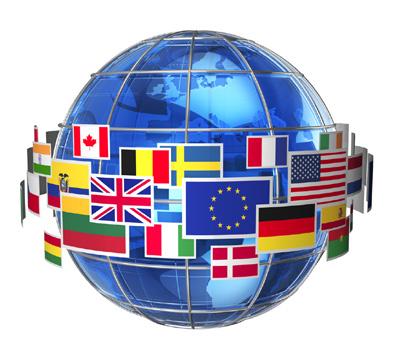
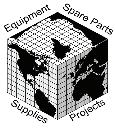
NEWS IN BRIEF www.batteriesinternational.com Batteries International • Spring 2024 • 43
International, Inc.
World’s Price Leader for the Battery Industry
Sasha’s
The
Negative Expander, Fiber Flock, Flux, Cork Powder, Pasting Belts & More Clean-All Heavy Metals®Soap
Global Shipping
offer full air, ocean and courier services at low rates. Or ship with your own carrier. You are in control. LOCATIONS: CONTACT: Miami Beach, FL 33139 U.S.A. TEL: 305-695-8990 Denver, CO 80234 U.S.A. FAX: 305-695-8991 www.sashas.net Email: sashas@sashas.net English · Français · Español · Italiano · Deutsch · български · Pусский C M Y CM MY CY CMY K Final Ad.pdf 1 9/17/2019 3:13:17 PM
The only soap that allows workers to eliminate lead residue from their skin without harsh scrubbing. Keep your workers safe and clean.
We
with power requirements of 50-300 kW.
The ESS can be used to store power from solar power generating units that are increasingly popular with businesses such as farms, small shops, retail outlets and filling stations, BMZ said. Campsites and remote facilities such as ski huts are also target markets.
BMZ said the first madein-Germany iteration of

the ESS has been designed for use with systems operating in European summer and winter weather conditions.
However, the spokesperson said Power Bloxx could easily be adapted for use in other global markets, supported by equipment and technical back-up from BMZ’s production sites beyond Germany — in Poland, North Macedonia, China, the US and Brazil.
Nano One launches new LFP feasibility study
Nano One said on February 27 it had launched a new feasibility study into proposals to build its first commercial lithium iron phosphate cells facility.
The company announced last October that a frontend loading pre-feasibility study (FEL 2) indicated it could add 25,000 tonnes per annum of LFP production at an expanded Candiac

plant in Quebec — boosting the value of its proprietary One-Pot process.
The results of that study will be factored into the new study — FEL 3 — for which the tender has been awarded to Canadian engineering company BBA.
FEL 3 will look into the design of the 25,000 tpa plant and “further refine” capital and operating costs and the construction period required.
However, Nano One said talks with provincial and local governments had identified options for the plant to be built in Quebec and Ontario.
Key requirements before taking a final investment decision to build the plant would include customer offtake and feedstock supply agreements.
Chief operating officer Alex Holmes said the study would also inform proposals to potentially design and build similar facilities under licence or as joint ventures with partners around the world.
Meanwhile, Nano One will file a preliminary shelf prospectus potentially allowing it to make offerings of various financial securities, up to an aggregate total of C$175 million ($130 million), for an effective period of 25 months.
The company said this would help provide the most flexible and efficient access to capital markets, if and when it is needed — but said it had no immediate plans to issue securities.
In February last year, Nano One said it had completed a key milestone in its cathode materials and techno-economic modelling process with an unnamed global auto manufacturer.
Last September, Sumitomo Metal Mining announced a C$17 million investment in Nano One as part of a new battery materials development partnership.
NEWS IN BRIEF 44 • Batteries International • Spring 2024 www.batteriesinternational.com
Watt-Flex® heaters hav e a p a t e n t e d s p l i t - s h e a t h d e s i g n t h a t e l i m i n a t e s c o s t l y B O R E S E I Z U R E . C o n t i n u o u s c o i l t e c h n o l o g y o f f e r s the longest lasting, most even heat used in: - GRID CASTING and FORMATION - COS DIE and LEAD PUMP - COVER SEALING PLATEN It's time you switched to Watt-Flex® cartridge heaters. DaltonElectric.com 978-356-9844
Norway-EU battery materials pact as Morrow secures LMNO boost
Norway and the EU are to cooperate in developing raw materials for Europe’s battery industry, under a memorandum of understanding signed on March 21.
The partnership agreement came just weeks after European Commission batteries supremo Maroš Šefčovič warned that the EU supplies just 1% of its own needs for key battery raw materials — and needs a staggering €4.2 trillion ($4.6 trillion) of new investment by 2030 to achieve green energy ambitions.
The partnership with Norway, which is not an EU member state, aims to reduce supply chain disruptions for vital materials needed by Europe’s expanding network of battery cell gigafactories and boost research and innovation.
In addition, the partnership aims to unlock new investment to support the battery supply chain and ramp up training to build a skilled workforce for the sector.
A business matchmaking event will be held in Germany later this month to kickstart activities under the partnership.
In a separate announcement on March 14, Norway’s Morrow Batteries said it had been awarded NOK 345 million ($32 million) to support R&D of LNMO battery tech.
The funding from Innovation Norway was provided under the Important Projects of Common European Interest (IPCEI) business program.
Morrow has also qualified as an associated partner in the IPCEI European Battery Innovation program.
Norway signed up to a so-called ‘green alliance’
with the EU in April 2023 to cooperate on environmental protection and clean energy initiatives.
According to the government-backed agency Business Norway, Norwegian industry already produces substantial amounts of precursor materials for batteries, chiefly aluminium and silicon, in addition to refining nickel, cobalt, graphite and copper.
Energy Storage Journal reported earlier this month that Morrow Batteries was moving its temporary battery cells customer qualification line in South Korea to Norway — where it will become operational in the second half of this year at the battery developer’s Arendal gigafactory, which is set to start mass production in the fourth quarter of this year.
Last July, Freyr Battery was awarded €100 million ($112 million) from the EU to support its Giga Arctic project in Norway.
Northvolt launches construction of German gigafactory Swedish battery developer Northvolt officially launched construction of its ‘Northvolt Drei’ gigafactory in Germany on March 25 in a ceremony attended by the nation’s political leaders.
Federal chancellor Olaf Scholz and vice chancellor Robert Habeck said the 60GWh EV cells gigafactory in Heide, Schleswig-Holstein, would underpin the country’s importance as a European manufacturing base for the auto industry.
The start of construction comes less than a year after Germany’s federal and state governments said they would give financial backing for the project.
Northvolt said the gigafactory’s operations will use electricity generated by wind power and these are set to start in 2026.
The plant, which will also have an onsite battery recycling facility, will be Northvolt’s third gigafactory, increasing the company’s pipeline of battery manufacturing capacity under development to more than 170GWh.
Northvolt announced the selection of Schleswig-Holstein for the plant in 2022.
The company said then the region was chosen because it benefits from access to a surplus of electricity generated by onshore and offshore wind power, reinforced by clean energy provided through grid interconnections to Denmark and Norway.
Investment firm
Coronation further raises stake in battery and auto group Metair Africa-focused investment firm Coronation Asset Management has again raised its stake in battery and automotive group Metair Investments — to nearly 21%.
The deal was announced on March 19 in a statement via the Johannesburg Stock Exchange.
Coronation last upped its stake in Metair last September, raising the level then to more than 15% from a previous 10%. Neither company has responded to Batteries International requests about the reason for the latest move.
Metair has stated previously it plans to sell off its energy storage division — including Turkey’s Mutlu Akü lead battery business, Romanian lead and lithium company Rombat and South Africa’s First National Battery — when it deems market conditions are right.
Last January, Metair announced that Paul O’Flaherty would be taking over as its next CEO on February 1 on a three-year contract.
He succeeded Sjoerd Douwenga, whose resignation for undisclosed health reasons was announced by Metair at the end of last year.
US air base hosts 3.3GWh BESS plus solar plant
A US Air Force base now hosts a commercially-operational 3.3GWh BESS-plussolar facility, construction and engineering firm Mortenson has announced.
The Edwards & Sanborn Solar + Energy Storage project, said by Mortenson to be the biggest in the country, reached full capacity this January, but completion of the facility has only recently been confirmed.
The project spans more than 4,600 acres on land at the Edwards Air Force Base in California and includes more than 1.9 million First Solar modules with a solar generating capacity of 875MWdc (megawatts of direct current).
According to Mortenson, the project uses batteries from Korean manufacturers LG Chem and Samsung and China-headquartered BYD.
Batteries International reported last month that, under pressure from US legislators, utility Duke Energy was scrapping a BESS supplied with batteries from CATL at a military base amid a national security row — and had pledged to “phasing out” the Chinese battery giant’s tech from its entire supply chain.
Edwards has yet to respond to a request from Batteries International about whether any battery tech being used is under review in light of concerns raised by legislators.
The Edwards facility supplies power to the city of San Jose, Southern California Edison, Pacific Gas & Electric and other companies and agencies.
NEWS IN BRIEF www.batteriesinternational.com Batteries International • Spring 2024 • 45
Monbat mulls sales of three subsidiaries
European lead battery major Monbat is considering plans to sell off three subsidiaries including EAS Batteries — for which a planned deal fell through last year.
Batteries International has learned CEO Viktor Spiriev told an investors meeting on January 22 there was “still a chance” of selling EAS to potential investors that had expressed an interest in the Germany-based lithium-ion subsidiary in recent months.
Spiriev also said Monbat
is considering the possible sale of its Piombifera Italiana lead recycling facility in Italy, which it acquired in 2017, plus its Monbat Batterien lead battery production subsidiary based in Austria.
There were no plans to sell Monbat’s Nour lead battery subsidiary in Tunisia, in which the group acquired a 60% stake in 2022, Spiriev said prospects for that business continued to be very good as the group seeks to expand its
market share across North Africa and the Middle East.
Batteries International asked Monbat to elaborate on its business plans and why it was considering the potential sales, but the company had not responded at the time of going to press.
In January 2023 Monbat’s plans to sell EAS to UK gigafactory developer Britishvolt in a cash and shares deal fell through after Britishvolt collapsed into administration.
Queensland unveils A$570m battery jobs plan
Queensland published plans on February 22 to invest A$570 million ($375 million) to create clean economy jobs in the Australian state based on battery technologies and manufacturing.
Queensland’s battery industry could contribute up to A$1.3 billion to the economy and generate more than 9,000 jobs by 2030, the state government said.
Ministers say the five-year program focuses on developing advanced manufacturing of battery materials,
cells, pack assembly, installation, and recycling.
The program includes establishing an Australian Battery Industrialization Centre in partnership with the federal government.
Queensland premier Steven Miles said: “We have already made great progress in building out our battery industry supply chain, with substantial investment in battery projects right across the state.”
Miles said the state can draw on its ability to mine minerals critical to the
battery industry to underpin its manufacturing program.
In March 2022 Australian renewables and energy storage developer Genex Power announced the financial close of its first agreement in a planned series of major battery projects in the state of Queensland.
In February 2023, flow battery maker Redflow said it would step up its collaboration with partners toward developing new commercial projects in the state of Queensland.
Precursor materials investment boost for Korean battery enterprise zone
Chemicals company Paik
Kwang Industrial is to start building a KRW300 billion ($224 million) precursor materials plant at a new battery enterprise zone in South Korea, the country’s Saemangeum Development and Investment Agency (SIDA) announced on January 12.
Batteries International reported last August that South Korea’s government had designated the Saemangeum Industrial Complex, in the west of the country, as a “future growth engine” for batteries.
SDIA said Paikkwang’s 100,000m2 facility will produce materials including phosphorus trichloride (PCI3) and phosphorus pentachloride (PCI5) — precursors for an electrolyte material used in lithium ion batteries.
Paikkwang’s production of PCI3 and PCI5 will eventually replace most of that imported from China, SDIA said.
SDIA administrator Kim Kyung-ahn said Paikkwang’s project takes total pledged investment at Saemangeum to date
EIB
mulls €500m finance for Vulcan’s zerocarbon lithium project
The European Investment Bank is considering a financing boost of up to €500 million ($542 million) for Vulcan Energy Resources’ Zero Carbon Lithium project in Germany.
Australia-listed Vulcan said on February 23 the proposed financing for the first phase of the project, in Germany’s southwest Upper Rhine Valley, is formally under appraisal by the bank following preliminary due diligence.
Support from the bank, which is the EU’s lending arm, would be a cornerstone to securing other debt funding for which talks are underway with credit agencies and international banks, Vulcan said.
Phase one of Vulcan’s project is targeting the production of 24,000 tonnes per annum of lithium hydroxide, which the company said would equate to supplying batteries for 500,000 EVs.
Vulcan aims to supply key auto and battery makers in the European supply chain, including its second-largest shareholder, Stellantis.
to KRW10 trillion ($7.6 billion).
Saemangeum, built on reclaimed land, is already home to divisions of hightech national and international companies including separators firm Toray and battery tech group Solvay.
Korea pledged in April 2023 to launch a multibillion dollar program to defend and expand its battery industry amid fears that many of the lucrative US tax breaks and incentives are tipping the global battery trade balance stateside.
Cris Moreno, MD and CEO of Vulcan, said the bank’s consideration of financing represented “a strong and tangible signal of confidence at the European level” for the Germany project.
Vulcan announced the completion of a pre-feasibility study for its Germany project in 2021.
The company said its production process is more environmentally friendly because hot salar brine feedstock produces heat for renewable power production in addition to providing lithium.
NEWS — FINANCE 46 • Batteries International • Spring 2024 www.batteriesinternational.com
Trent Capital takes full control of Microporous
Private equity firm Trent Capital Partners said on February 12 it had acquired full control of separator company Microporous.
Trent has been a minority owner of Microporous for the past 10 years and Trent’s founder and MD, Ray Desrocher, has been on the Microporous board since that time.
Microporous CEO John Reeves said Trent’s purchase of full control, for an undisclosed, sum would spur the firm’s growth in lead acid and lithium ion separator markets.
Batteries International reported in January that Microporous had started talks aimed at securing a $100 million US federal grant for the production of
lithium ion battery separators.
Corporate development and innovation VP Brad Reed said the company was told last December it had been selected to negotiate the Department of Energy grant.
That triggered the start of a detailed negotiating period that will take several months after which, “barring any unanticipated eligibility problems”, the grant will be formally awarded and payments can start, Reed said.
The grant talks position Microporous as a key player in strengthening domestic clean energy supply chains, Reed said.
Microporous will make an announcement about where
to build a new separators production plant once the grant application process has been completed.
The company said locations under consideration include Virginia and North Carolina — and the Southern Virginia ‘megasite’ is a top contender.
However, the final decision will be based on the findings of an environmental assessment by the US Department of Energy, which will be required before the grant agreement is signed.
More than 280 jobs will be created as a result of the grant, of which at least 85% of full-time employees will be from local communities, Microporous said.
The lithium battery
Frontier, Mitsubishi agree Ontario lithium joint venture
Frontier Lithium and Mitsubishi Corporation have agreed a joint venture deal to launch a lithium mining and processing operation in Ontario.
Under a definitive agreement signed on March 2, the partners will secure funding to develop the PAK Lithium Project mine and lithium chemicals conversion facility to supply the North American EV battery supply chain.
Mitsubishi will acquire an initial 7.5% stake in the project for C$25 million ($18.4 million) with Fron-
tier holding the remaining shares.
The Japanese firm has an option to increase its stake to 25% following completion of a definitive feasibility study.
The partners said the joint venture has been structured to cover the equity funding for the planned mine and mill while maintaining at least 75% of future off-take.
The joint venture is already providing immediate and near-term financing to “aggressively advance the first fully integrated lithium mining and processing
operation in Ontario”, the companies said.
A pre-feasibility study released in May 2023 confirmed the PAK project could be the continent’s highest quality, largest and lowest-cost producer of lithium hydroxide able to supply the rapidly growing EV industry in North America.
Canada and Japan signed a memorandum of cooperation last October committing the countries to working more closely to establish sustainable and reliable global battery supply chains.
Investor Sosteneo buys into Enel BESS unit for €1.1bn
Enel said on March 1 it had agreed to sell a 49% stake in a subsidiary set up to develop mainly BESS projects in Italy to investor Sosteneo for €1.1 billion ($1.2 billion).
Under the terms of the deal, Sosteneo Fund 1 HoldCo will buy into Enel Libra Flexsys, of which
Enel will continue to have majority control.
The agreement values ELF at around €2.5 billion including debt.
ELF was established to build and operate 23 BESS projects with a combined capacity of 1.7GW and three renovation projects for open cycle gas turbine
separator commercialization project is based on using wet process polyethylene separator film technology similar to the PE lead battery separators produced in the firm’s plants in the US state of Tennessee and Austria.
Addionics invests $400 million to boost EV
battery tech plans
Battery tech developer
Addionics is investing $400 million in the first stage of a multi-factory development plan in the US.
The firm said on February 26 it is in the final stages of site selection for the first in a series of plants that will produce its proprietary ‘smart 3D current collector’ copper foil products for high-performance EV batteries.
Addionics claims its 3D structured foil improves the performance of any battery, regardless of its chemistry.
The product design increases the surface area of the coating, mechanically strengthens the bond between the active material and the foil, and creates a highly porous structure for improved performance, according to the company.
AI software is used to determine the best structure of the foil for application requirements.
Once completed, the new factories will generate 3D copper foils to support 90GWh of battery capacity a year.
plants.
Enel Group CFO Stefano De Angelis said the agreement with Sosteneo will support the speeding up of the group’s BESS development projects.
The sale should close in the first half of this year subject to regulatory approvals.
Addionics was founded in 2017 and has production facilities in the US and Israel plus sites in the UK and Germany.
However, the first of the new plants to be built in the US will be the company’s biggest manufacturing facility to date, CEO and co-founder Moshiel Biton said.
NEWS — FINANCE www.batteriesinternational.com Batteries International • Spring 2024 • 47
Vanevo cash raise boost for flow battery
Redox flow battery components firm Vanevo is to use a fresh funding boost to set up a new cell stacks production line in Germany.
Vanevo CFO and MD Uwe Boegershausen told Batteries International on February 8 the undisclosed capital boost will allow the firm — spun off from the German Aerospace Center in 2018 — to set up the 10MW automated serial production line at a new site in Lower Saxony.
Boegershausen said production capacity will be ramped up to 50MW annually as the firm moves toward full commercialization of its patented stack technology, which it says
avoids fluorinated sealings and uses a single adhesive sealing instead.
As only one seal is required instead of 160, the battery cells are cheaper to produce, more energy-efficient and easier to handle, he said.
Vanevo had already raised €4.7 million ($5 million) in equity, as well as grants from the European Innovation Council, before the latest boost.
The firm said it already has supply agreements with a number of unnamed customers and completed its initial deliveries last month.
Renewables investors Smit Asset Management and Bookjans Asset Manage-
ment took part in the latest capital increase along with Boegershausen, Vanevo founder and CEO Jan grosse Austing and others.
Vanevo says it intends to target the global energy storage market with its standardized stacks and modules for final battery assemblies.
“From our perspective, standardization is the only way to achieve significant cost savings that are crucial for the commercialization of the technology,” Boegershausen said.
A key backer of the company to date is NBank Capital Beteiligungsgesellschaft, a subsidiary of the Investment and
SQM increases Altilium investment to $12m
SQM Lithium Ventures said on February 21 it had made a further investment of $9.5 million in UK-based Altilium.
The cash injection takes the investment by the corporate venture arm of the lithium business of Sociedad Química y Minera de Chile in Altilium to $12 million — the lithium producer’s largest such investment to date.
The financial boost also completes Altilium’s series ‘A’ funding round.
Altilium said the addi-
tional funding will accelerate the scale-up of its UK and European activities to eventually encompass EV battery collection, black mass recycling and chemical refining direct to cathode active material.
Key developments for 2024 include the construction of a small commercial plant in southwest England to process what Altilium said will be significant volumes of battery precursors and cathode active materials for qualification with automakers
and cell manufacturers.
The company also wants to build an EV battery recycling facility in northeast England and launch hydrometallurgical refining by retrofitting an existing industrial plant in eastern Europe, with plans to process 8,000 tonnes of black mass later this year.
Last December, SQM said it had reached a framework deal to give a majority stake in its Chilean brine assets to the country’s state-owned copper corporation Codelco.
TotalEnergies acquires German BESS developer Kyon
TotalEnergies, the French oil giant, said on January 23 it had agreed to take over German BESS developer Kyon Energy. TotalEnergies has signed an agreement to acquire Kyon’s entire share capital from its three founders for an upfront payment of €90 million ($98 million) plus some payments linked to the achievement of development targets.
Kyon has led development of 770MW of
energy storage projects since its launch in 2021, of which 120MW are in operation, 350MW are under construction and 300MW are ready to build.
In addition, Kyon’s portfolio includes a 2GW pipeline of advanced-stage projects.
TotalEnergies, which also owns French battery firm Saft, said it will develop, build, and operate those projects, mainly
Development Bank of the German state of Lower Saxony.
NBank investment manager Marc Löffler said the institution would continue to support Vanevo’s growth after backing the company’s development stage as a seed investor.
“We are impressed by the team’s technical expertise and the technological lead that the company has gained.”
LGES
leads $75m Sion Power capital boost
Lithium metal developer
Sion Power said on January 24 it had raised $75 million backed by LG Energy Solution to expand R&D production capacity for EV batteries.
LGES led the series ‘A’ funding round through its venture capital arm LG Technology Ventures with Bricks Capital Management, supported by Euclidean Capital and including new investment from former Google CEO Eric Schmidt’s Hillspire.
New directors joining Sion’s board as a result of the investment boost include Robert McIntyre, the MD of LG Technology Ventures and the managing partner of Bricks Capital Management, Hansol Kim.
located in the north of Germany.
The Kyon deal, which is subject to regulatory approvals, comes after TotalEnergies was: awarded a maritime concession by German authorities to develop a 3GW offshore wind farm; acquired renewable energy aggregator Quadra Energy; and was awarded a contract to install and operate 1,100 high-power charge points for EVs.
Sion said it will use the new capital to achieve technical and market validation of its Licerion technology, while pushing ahead with plans to build a fully automated manufacturing line for high quality, large format lithium metal cells for testing and market development by automotive OEMs and cell manufacturers.
Sion is expanding its existing 100,000ft2 plant site in Arizona by 11,400ft2 by 2026.
NEWS — FINANCE 48 • Batteries International • Spring 2024 www.batteriesinternational.com
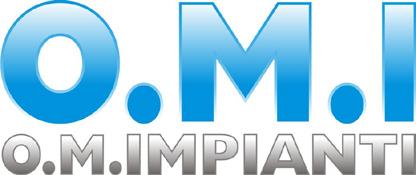
RAISE YOUR PERFORMANCE WITH OMI BATTERY EQUIPMENT!
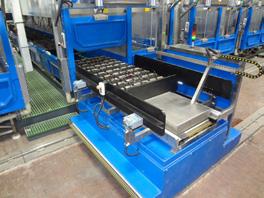
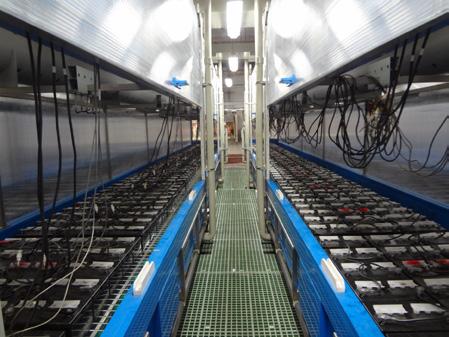
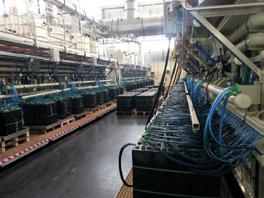

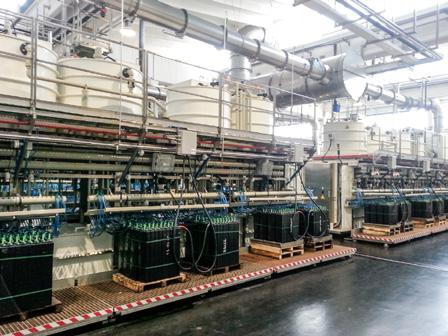
Our solutions for the battery business:
ACID RECIRCULATION
FORMATION: fast formation for your truck and industrial batteries
ADVANCED WATER BATH
FORMATION: improved quality and shorter cycles for your automotive batteries
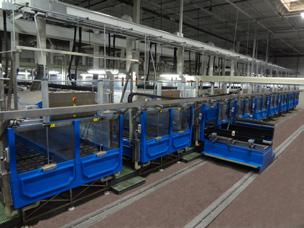
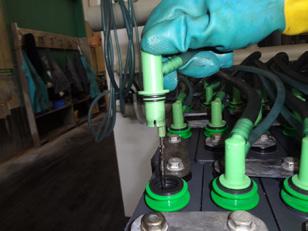
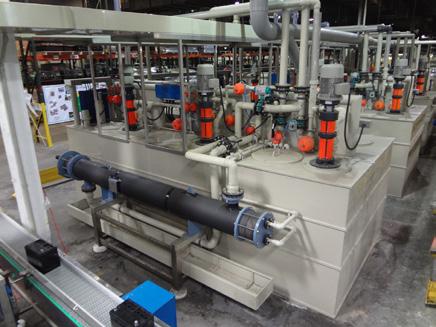
FILLING PROCESS FOR FLOODED & AGM BATTERIES
FINISHING & DISPATCHING EQUIPMENT
ACID PREPARATION, STORAGE AND RECOVERY SYSTEMS
+39 0363.901981
di Lombardia, ITALY
omi-nbe.com info@omi-nbe com Romano
Ecobat, VW finalize UK lithium recycling deal ...
Lead and lithium recycling giant Ecobat said on February 28 it had finalized a new contract to recycle EV batteries for Volkswagen Group UK.
Texas-headquartered Ecobat said VW will be the first to use the firm’s newlyopened UK lithium ion recycling facility.
Financial terms of the deal were not disclosed, but Ecobat said it covers the collection and recycling of VW’s EV batteries and collection of high-voltage batteries from dealers, distributors, and end-oflife recycling centers using Ecobat’s ADR -compliant vehicles.
ADR is a set of guidelines and processes that businesses must follow when transporting dangerous goods by road.
Ecobat has a longstanding relationship with VW UK dating back to 2014 when it started collecting lead acid batteries for TPS — VW’s parts provider to the independent motor trade.
The contract was expanded in 2019, when
Ecobat started working with high-voltage batteries. Since the company opened its Diagnostics and Disassembly Centre in Darlaston, in the West Midlands, it has processed and upgraded thousands of batteries.
Elliott Ethridge, Ecobat’s VP of global sales, said the
firm’s lithium recycling operations can handle scrap, by-products, end-of-life and damaged products.
The UK is home to Ecobat’s third lithium ion recycling facility after those in Germany and Arizona — the commissioning of which was announced last month.
Ethridge said then Ecobat had a long history in lead recycling worldwide, but added:
“It makes sense to go into lithium now, but we don’t see lead diminishing. We see lithium coming on to augment a lot of spaces that lead doesn’t serve.”
... and new US lithium plant commissioned
Separately Ecobat confirmed on January 18 that it had commissioned its first lithium recycling plant in the US.
The new Casa Grande facility in Arizona, announced in February 2023, has a capacity of around 10,000 tonnes of recycled material a year with the ability to expand capacity.
Lithium sales VP Elliott Ethridge said the new plant will sort, shred and separate battery materials to produce black mass.
Ecobat already has a lithium battery recycling plant online in Germany and another is being prepared for start-up in the UK, Ethridge said.
Technology in use at Ecobat’s facilities can process everything from portable small format batteries to EV batteries, he said.
The company has a long history in lead recycling worldwide. It said: “It makes sense to go into lithium now but we don’t see lead diminishing. We see lithium coming on to augment a lot of spaces that lead doesn’t serve.”
Former Ecobat CEO Jimmy Herring told Batteries International in December 2021 that the company aspired to bring all kinds of chemistries under its wing to become the biggest all-round recycler in the
world.
Last November, Ecobat announced it had sold its Zimco Group businesses in South Africa including lead manufacturing, recycling and chemicals firms to AutoX.
Ecobat CEO Marcus Randolph said that sale would allow the group to focus on its “core business” of battery recycling in North America and Europe.
The move followed the sale, announced in 2022, of Ecobat Resources Stolberg to commodities firm Trafigura. The sale included the Stolberg multi-metals processing plant in Germany.
Taiwan’s ACME Metals installs ACE Green’s systems module after testing
Taiwanese lead refiner
ACME Metal Enterprise has installed its first modular lead battery recycling equipment supplied by ACE Green Recycling.
ACE’s VP for global strategy and business development Farid Ahmed told Batteries International on January 15 the first of three equipment delivery phases was completed last month.
The move follows initial testing of ACE’s technology in 2023 for the treatment of lead oxide drosses from ACME’s refinery in Keelung City.
Under the first delivery phase, ACE handed over
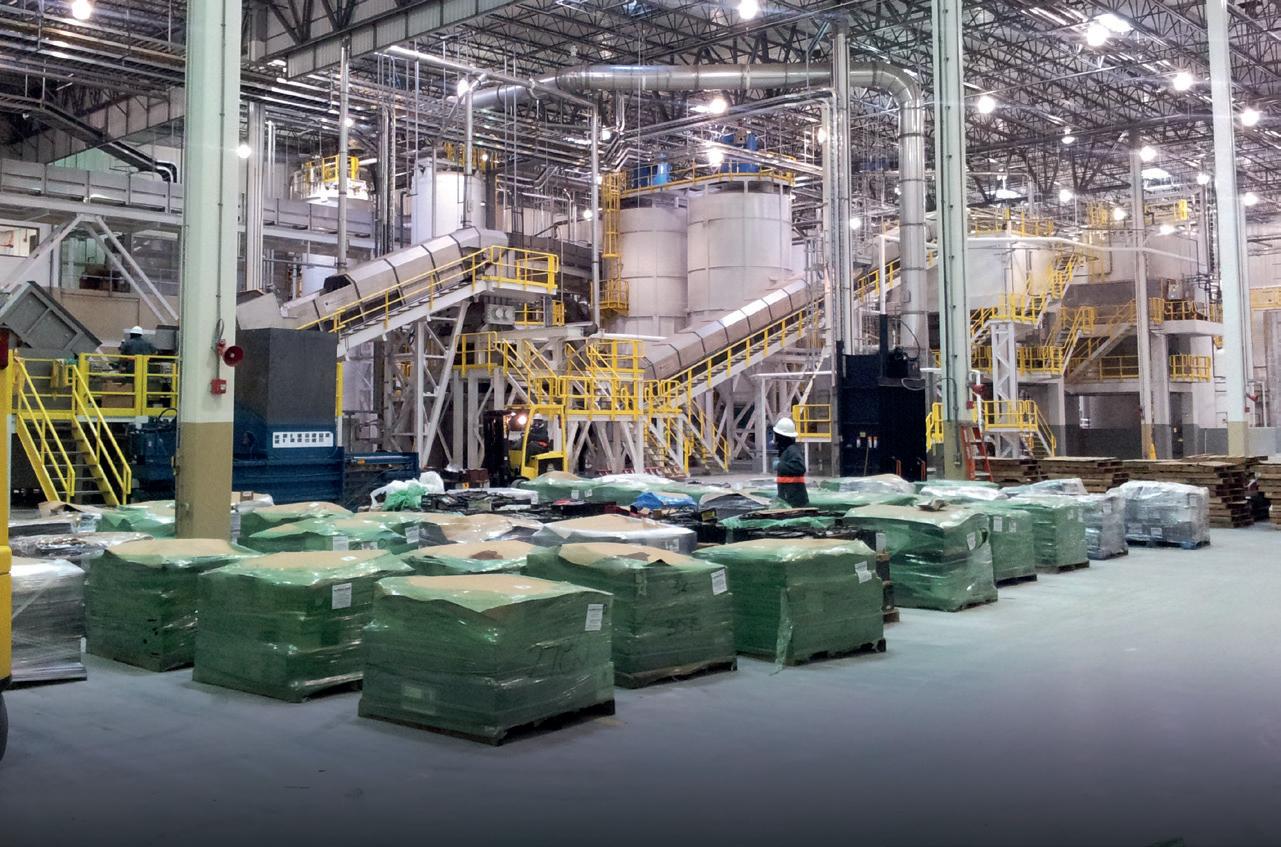
equipment with a 2,400tonne per annum recycling capacity. Completion of the third phase will expand this capacity to 20,000-tonne per annum, giving ACME the ability to produce around 12,000 tonnes of what it calls ‘GreenLead’ annually, which is worth over $25 million a year to the refiner, Ahmed said.
Over the 10-year duration of the contract, ACME will acquire the capacity to recycle more than 14 million scrap batteries, which ACE says will prevent the emission of nearly 120 million kilograms of carbon dioxide equivalent, stop 18 million
kg of solid waste from going into landfill and enable recycling of more than 14 million kg of plastics.
The lead recycled by ACME will be sold into markets in Taiwan and Japan including battery OEMs across Asia, ACE said.
ACE claims its technology replaces the smelting furnace, operates at room temperature, runs on electricity and has zero Scope 1 greenhouse gas emissions (direct GHG emissions such as those made while running boilers and vehicles) and reduces solid waste by more than 85%.
ACE’s CEO Nishchay
Chadha said: “It is our goal as a battery recycling technology platform to provide all players in the ecosystem a way to meet not just their commercial goals but their environmental ones as well.”
ACE Green unveiled plans in 2022 to build and operate what it claimed would be an “emission-free” lead and lithium batteries recycling facility in Texas.
The firm has since signed several deals — including an equipment supply and licensing agreement last June with Hakurnas Lead Works, to set up battery recycling facilities in Israel and Romania.
NEWS — RECYCLING 50 • Batteries International • Spring 2024 www.batteriesinternational.com

MASTER IN CIRCULAR ECONOMY
Gravita endorsement by MCX, expands capacity to 291,000tpa, Suez disruptions
Gravita India said on March 11 the endorsement of pure lead products from its Mundra plant by the Multi Commodity Exchange of India (MCX) will boost its trading position on the domestic market.
Gravita said the lead produced at the plant in Gujurat had been assessed as an approved lead brand deliverable against MCX lead futures contracts.
The announcement follows similar MCX endorsements of pure lead produced at Gravita’s Chittoor and Phagi plants in India.
MCX, which started operations in November 2003, is a commodity derivatives exchange that supports online trading.
Gravita company secretary Nitin Gupta said MCX’s endorsements give the company an additional platform for hedging, better inventory management and price transparency in the domestic market.
The company announced in April 2023 that lead recycling capacity at Mundra had been increased by 40,500 tonnes per annum to 60,000 tpa.
Batteries International reported on March 7 that Gravita’s overall lead recycling capacity stands at almost 291,000 tpa, after
the group’s Tanzania facility increased its capacity by 5,000 tpa to 12,000 tpa.
Gravita said on March 6 it had expanded lead battery recycling at its plant in Tanzania by 5,000 tonnes per annum to 12,000 tpa.
The Indian lead producer and recycler said the increase at its Tanzanian subsidiary takes the total recycling capacity of the Gravita group to almost 291,000 tpa — keeping the firm on course to achieve
its overall target of 425,000 tpa by fiscal 2026.
The announcement followed the commercial launch of lead battery recycling last year at Gravita’s plant in the West African nation of Togo — with a 6,000 tpa capacity.
Lead battery recycling at the firm’s Chittoor plant also expanded in India last year to 64,640 tpa — as it also did at Mundra to 40,500 tpa.
Commercial lead battery
recycling by Gravita in Tanzania started in April 2019, with a then projected 3,000 tpa.
Last December, the company said it had also started commercial production of recycled polypropylene granules in Tanzania. PP has a wide range of uses and is one of the most common plastics used in the manufacturing of lead battery cases and the recycling of the material is commonplace.
Red Sea attacks add pressure, disrupt business
The CEO of Gravita warned on January 29 that attacks on vessels in the Red Sea risk disrupting business.
The warning by Yogesh Malhotra came a week after the Hammond Group highlighted increasing pressure on battery supply chains as a result of major disruptions involving two global trade arteries.
Malhotra told analysts in an earnings call that some exports from the group’s Mundra recycling plant in Gujarat have already been disrupted to avoid attacks in the Red Sea.
He said Gravita is look-
ing at alternative ways of selling products from Mundra and also importing some materials.
This will hit revenue for some time ahead but has not had a major impact on the bottom line to date, Malhotra said.
Meanwhile, Malhotra revealed Gravita has technical teams in China discussing partnership options to build a lithium ion battery recycling plant in India.
He said the company
may be able to demonstrate “some action” on such a project by the first quarter of next year. However, he said it could be another five or six years before Gravita starts commercial lithium ion recycling operations. Batteries International reported last year that Gravita was in talks with potential lithium ion recycling tech partners in Europe, Japan and Israel to build the pilot facility at its Mundra plant.
Yogesh Malhotra said it could be another five or six years before Gravita starts commercial lithium ion recycling operations
StarSun to invest in lead battery recycling plant in Oman
India-based StarSun Sohar said on February 18 it had signed a land lease deal to set up a lead battery recycling plant in Oman’s Sohar Freezone.
StarSun said it plans to invest $3 million in the project to recycling around 1,000 tonnes of batteries from the domestic market every month on a 7,000m2 site.
The company has not disclosed the technology
it will deploy, but said it intends to also export lead ingots, lead oxide and red lead oxide from the facility to markets including India, China South Korea and several European countries and trade its products on the London Metal Exchange.
The port and freezone is managed by the Sohar Industrial Port Company — a 50-50 joint venture between the Port of Rotter-
dam and the Sultanate of Oman.
Port and freezone CEO Omar bin Mahmood Al Mahrizi said the new plant would be the third recycling facility in the freezone. The first two manage and process various hazardous industrial wastes.
Batteries International reported in August 2022 that Royal Gulf Industries, a subsidiary of India-headquartered Hyderabad Cast-
ings, was investing around $17 million to build a lead batteries recycling centre in the United Arab Emirates. The project announcement came five months after Dubatt Battery Recycling — a joint venture between Dubai-based Regency Group and Seashore Group — broke ground for a combined lead acid battery manufacturing plant and recycling facility in the UAE.
NEWS — RECYCLING 52 • Batteries International • Spring 2024 www.batteriesinternational.com
Sunlight to acquire full control of Ubatt
The Sunlight Group said on February 7 it had signed a binding agreement to acquire the remaining 50% stake in its German lead battery recycling subsidiary Ubatt.
The deal, for an undisclosed sum, will be finalized by the group’s Sunlight Recycling subsidiary and is subject to the approval of
competition authorities.
Sunlight Group CEO Lampros Bisalas said Ubatt, which also started collecting lithium batteries for recycling a few years ago, handles a combined total of 58,000 tonnes of batteries annually.
Bisalas said the acquisition will strengthen the group’s position in the battery recy-
cling market for lead and lithium chemistries.
Sunlight Recycling was set up after being given the go-ahead at an extraordinary meeting of the Greece-based group’s shareholders last October.
In November, Sunlight said it was spinning off its lead recycling operations into the new subsidiary to guarantee
raw material supplies for lead battery production.
Bisalas said then that the move would create one of the largest secondary lead producers in the world, help to expand the group’s collection of used batteries in Europe and America and make its lead battery production operations more competitive.
Li-Cycle gets liquidity boost from Glencore, Germany grants approval for new plant
Li-Cycle said on March 12 it had received an extra $75 million investment from mining group Glencore would boost its liquidity.
The month before it won approval for a €6.4 million ($7 million) grant for its new lithium ion recycling plant in Germany.
Pressure has been mounting on Li-Cycle after it suspended construction of its Rochester lithium battery recycling hub in New York last October over escalating costs.
The suspension came after Li-Cycle said the estimated cost could double to up to $1 billion.
Li-Cycle has since formed a special committee “composed solely of
independent and disinterested members” of its board to work with investment bank, Moelis & Company, on a review of the Rochester project and “to evaluate potential financial and strategic alternatives”, co-founder and CEO Ajay Kochhar revealed on March 12.
Glencore originally invested $200 million in Li-Cycle in 2022.
Kochhar said the latest Glencore investment represented an interim step in Li-Cycle’s funding strategy. “We also continue to work closely with the US Department of Energy (DOE) on the conditional commitment for a loan of up to $375 million.”
Key Republican members of the House of Representatives have called on the DOE’s Loan Programs Office to give details of the proposed loan — saying they were concerned about the government making possible “reckless investments”.
Separately, at least two law firms have announced the filing of class action lawsuits against Li-Cycle, relating to statements made by the firm about Rochester’s costs.
German grant
The firm said the grant approval for its Magdeburg ‘spoke’ facility in Saxony-Anhalt was given by the state’s government.
Regenerate Technology to launch lead ‘upcycling’ plant by the summer in Bologna, Italy, says CTO Athan Fox
Regenerate Technology
Global, an Anglo-American lead battery recycling firm said on February 13 it had secured a longterm lease of a former lead battery manufacturing plant in Italy where it will launch a lead recycling operation.
Regenerate co-founder and CTO Athan Fox said the company, which also has an option to buy the plant, is renovating the
125,000 ft2 facility in Bologna and plans to start “upcycling” of lead acid batteries by this summer.
Fox claimed operations at the site will mark a “significant leap in commercial-scale, upcycled leady oxides production”.
Regenerate’s CEO is David Batstone, founder of US-based social impact investments company Just Business. Batstone was an early investor and former
board member of the American Battery Technology Company.
Batstone is also a former CEO of Blackstone Technology — the German 3D printed batteries tech development subsidiary of Swiss holding company Blackstone Resources.
The general manager of Regenerate’s EU and UK operations is Miles Freeman who has worked with Fox for years,
Spoke facilities are where all types of lithium ion batteries are transformed from a charged state to what Li-Cycle describes as an inert product.
The resulting black mass is then transferred to a hub, where cathode and anode materials are processed into battery grade end-products for reuse in battery production or other applications.
Li-Cycle said last year that black mass produced at Magdeburg would be processed at a hub operated under a proposed European joint venture with Glencore.
However, the future of that joint venture project is unclear and the partners have yet to respond to repeated questions from Batteries International about the status of the project.
Magdeburg spans more than 20,000m2 with 10,000m2 warehouse capacity.
Li-Cycle said the facility can process full EV and energy storage battery packs without the need for disassembly, discharging, or thermal processes.
Magdeburg has an annual lithium ion battery processing capacity of up to 10,000 tonnes, with potential to expand up to 30,000 tonnes annually.
NEWS — RECYCLING www.batteriesinternational.com Batteries International • Spring 2024 • 53
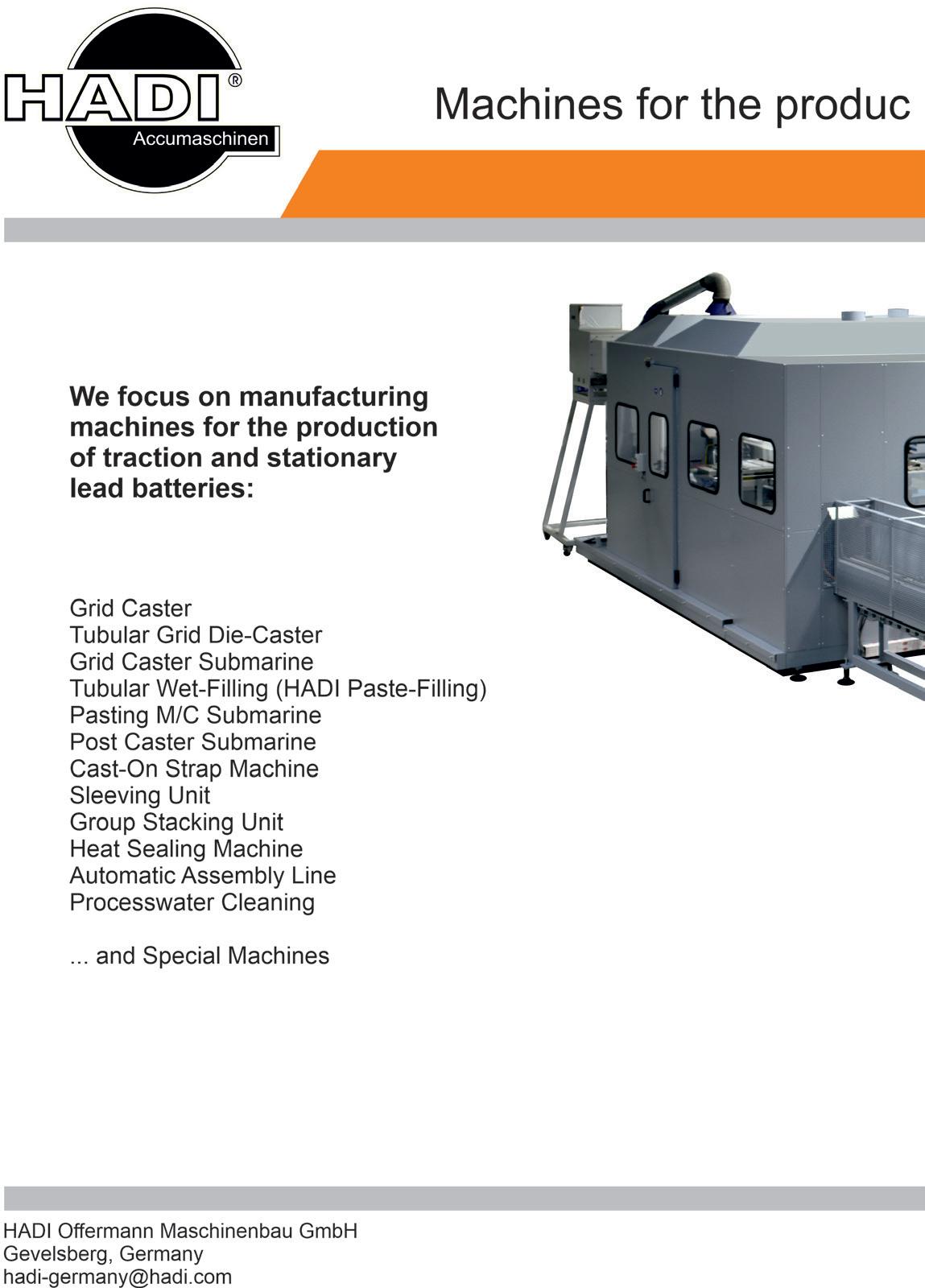
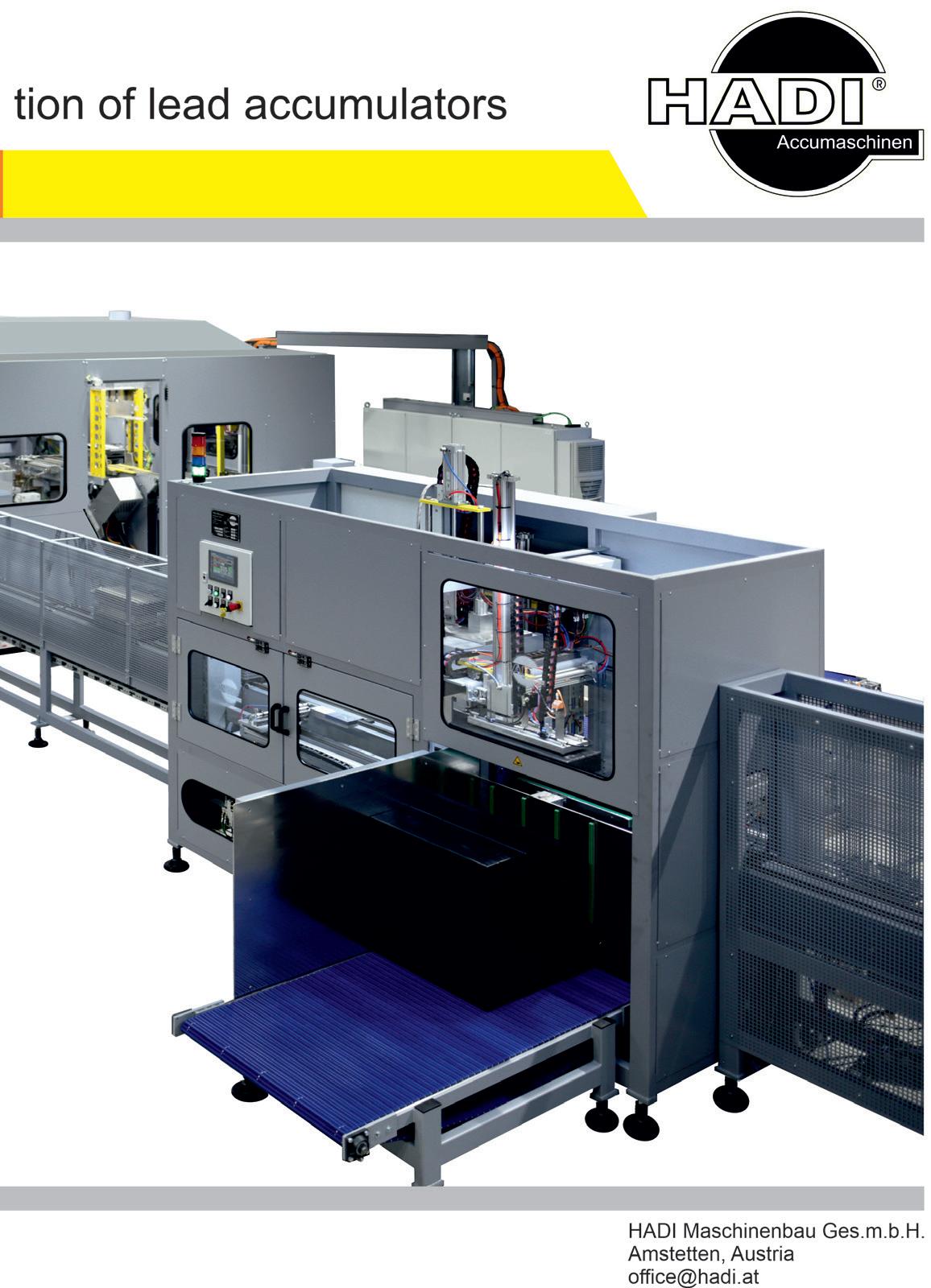
New Basel guidelines on lead recycling set for agreement in 2025, focus shifts to lithium waste
Updated technical guidelines under the Basel Convention for environmentally sound recycling of lead batteries are expected to be agreed next year, ILA senior regulatory affairs director Steve Binks has revealed.
Binks has been in Geneva working with the UN and other industry experts to develop the updated Basel technical guidelines — which he said today are expected to be agreed at the Conference of the Parties to the Basel Convention in 2025.
In a report of his meeting passed to Batteries International, Binks revealed dele-
gates also discussed new guidelines that, for the first time, will provide advice for environmentally sound recycling of lithium ion, still in its infancy, and other battery technologies.
Work on the guidelines is designed to help developing countries in particular to introduce legislation for managing battery recycling responsibly, Binks said.
“The ILA has been an important stakeholder in providing technical input since Basel guidelines were first introduced in 2003.”
The existing guidelines are more than 20 years old and are in desperate
need of updating to reflect current best environmental, health and safety practices employed in lead battery recycling and changes in international laws.
UN technical guidelines produced under the Basel Convention that controls transboundary shipments and disposal of hazardous waste are one of the most respected resources that policymakers and governments use to develop national laws, Binks said.
The Basel technical guidelines on lead and other battery chemistries will help governments, regulators and businesses make
the most of the opportunities to build successful recycling operations. They said: “To deliver a low carbon future the world needs more battery energy storage and lead batteries have an important role to play in applications from transport to mobile phone networks, uninterruptable power supplies and the microgrids that are essential for affordable energy in low and middle-income countries.”
In October 2022, the LeadBattery360° initiative was formally launched by trade associations representing the lead and lead battery industries.
Lead battery industry expertise backing Nigeria recycling program
German non-profit the Oeko-Institut has launched a new program aimed at improving battery recycling in Nigeria in cooperation with international partners including the lead battery industry.
Oeko-Institut said on March 5 the project will work to raise labor and environmental standards in Nigeria and help the country establish sustainable trade in battery raw materials.
Germany’s economic cooperation and develop-
ment ministry is funding the initiative, which is also supported by the country’s international development agency GIZ.
Oeko-Institut researcher on circular economy and recycling Frederick Adjei told Batteries International on March 11 members of the international ‘LeadBattery360°’ initiative had been contacted for their expertise.
LeadBattery360° was formally launched in October 2022 and is backed by global trade organizations
the ILA, BCI, EUROBAT and the Association of Battery Recyclers.
ILA senior regulatory affairs director Steve Binks told Batteries International: “We are actively supporting the project by providing them with technical guidelines to help assess the environmentally sound management of recyclers in Nigeria.”
Adjei said 10 lead battery recycling facilities in Nigeria are being invited to take part in the new Germany-led
Northvolt in $5bn green loan boost for batteries, recycling
Northvolt has secured a $5 billion loan to expand operations at its Northvolt Ett gigafactory in Sweden, the lithium battery developer said on January 16. The non-recourse loan — provided by a group of 23 commercial banks as well as the European Investment Bank and the Nordic Investment Bank — is the first to be raised through Northvolt’s green finance framework, created in 2023.
The loan includes refinancing of a previous $1.6 billion debt package raised in July 2020
Northvolt said the new financing had been raised on the back of long-term offtake contracts amounting to over $55 billion with partners including BMW, Scania, Volvo Cars and Volkswagen Group.
In addition to expanding cathode production and cell manufacturing, the loan will enable the
expansion of an adjacent recycling plant, Revolt Ett, which is nearing commissioning and will ultimately process 125,000 tonnes of end-of-life batteries and battery production waste annually.
Northvolt said in April 2023 it had received the highest rating attainable (‘dark green’) for its green finance framework. To date, Northvolt has secured more than $13 billion in equity and debt.
program, although it will be up to Nigerian authorities to decide if the participation should be mandatory.
Under the proposals, participating plants will be assessed and offered plans to improve operations and practices where necessary.
Specific training will also be provided as well linking up Nigerian companies and regulatory officials with international experts in the lead battery sector.
According to the Oeko-Institut, there are various estimates on the amount of end-of-life lead batteries in Nigeria annually ranging from 100,000 tonnes to 200,000 tonnes.
The organization estimates that more than 90% of the lead is exported. Adjei said the downstream use of this lead is widely unknown because export networks are opaque.
“But as 85% of the world’s lead market is tied to lead acid batteries, it must be assumed that much of the recycled lead from Nigeria somehow ends up in this sector again.”
NEWS — RECYCLING 56 • Batteries International • Spring 2024 www.batteriesinternational.com
The lead deficiency found in the electrochemically-produced alpha form of lead dioxide indicates that the hydrogen content necessary to achieve charge-balance must be of the order of 50 atom% writes Pat Moseley.
The continuing story of lead dioxide — stoichiometry of the alpha form
In the last issue of Batteries Interna tional [1] we pointed out that the properties of the tetragonal form of lead dioxide (β-PbO2) depend mark edly on its method of preparation. β-PbO2 prepared electrochemically in a cell with an acid electrolyte (as in the positive plate of a lead–acid battery) is Pb-deficient and contains hydrogen. But the material is O-deficient (with no hydrogen) when it is prepared by a purely chemical method.
For a better appreciation of the chemistry (and electrochemistry) of lead dioxide however it is appropriate here to note the significance of the properties of α- as well as β-PbO2.
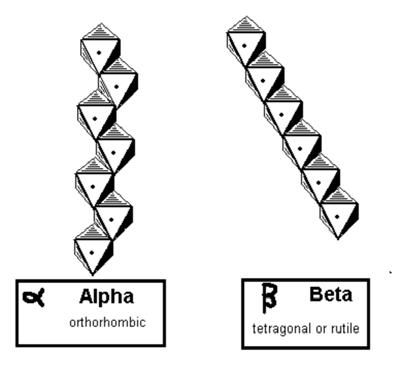
The structures of the two crystallographic forms of lead dioxide are closely related. Both contain strings of PbO6 octahedra linked together by the sharing of octahedral edges and they only differ in the sequence of the linkage of the octahedra in the respective strings. As shown in Figure 1, the string in α-PbO2 forms a zig-zag string while the sequence in β-PbO2 is straight.
Since the two structures are so closely related it is perhaps not surprising to find that samples of lead dioxide can crystallise with the two forms inter-grown epitaxially as shown in Figure 2. The material imaged here was prepared by introducing PbO into a fused mixture of sodium nitrate and sodium perchlorate [2].
α-PbO2 can also be prepared electrochemically. However, in contrast to the electrochemical preparation of β-PbO2, for which an acid electrolyte is used, the electrochemical prepara-
tion of α-PbO2 requires an alkaline electrolyte[3].
There are at least two substantial differences between the electrochemically-produced alpha- and beta- forms of lead dioxide.
First, refinement of the crystal structure of the alpha form to the best fit with neutron powder diffraction data leads to the conclusion [4] that the electrochemically prepared form of α-PbO2 can sustain a far greater degree of lead-deficiency than can the beta form (see Table on following page).
Secondly, if the positive charge shortfall that would be implied by this Pb-deficiency is made good by the
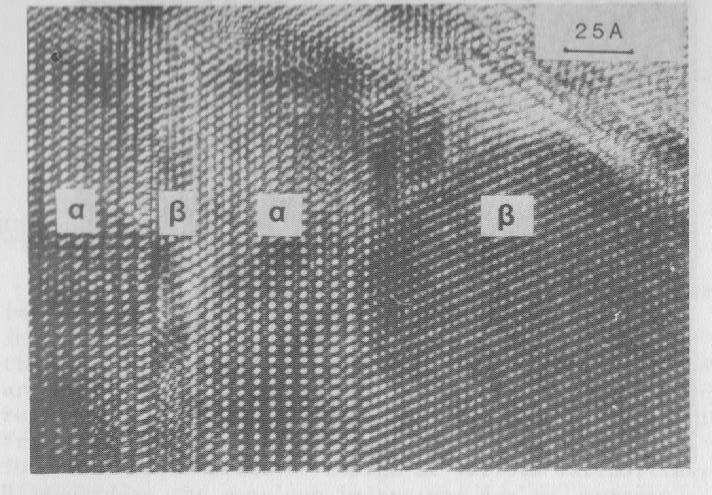
Since the two structures are so closely related it is perhaps not surprising to find that samples of lead dioxide can crystallise with the two forms inter-grown epitaxially
LEAD CRYSTALLOGRAPHY www.batteriesinternational.com Batteries International • Spring 2024 • 57
Figure 1: The stacking sequences of PbO6 octahedra in α- and β-PbO2
Figure 2: High-resolution transmission electron micrograph of a composite crystal of α - and ββ-PbO2 that was prepared by a chemical method [2].
α Alpha orthohombic
β Beta tetraganol or rutile
Form Pb deficiency (%) [H] needed to Measured [H] balance charge
α Alkaline 17
β Acid 3 - 5 0.12 - 0.20
- 0.20
Table: Lead atom deficiencies (obtained from refined site occupancies [4], [5], [6]) and hydrogen content for electrochemically-prepared α- and β-PbO2
The values in the Measured [H] column were obtained from neutron scattering experiments [3], [5].
presence of protons within the structure, as appears to be the case with β-PbO2, then the hydrogen content of the alpha form must be very high — in the region of 0.5 H atom per Pb atom.
The discrepancy between the hydro-
References:
gen content implied by the Pb-deficiency and the measured value may not be significant as the two values are taken from different research programmes and therefore were not obtained from the same specimen.
Chemically-prepared α-PbO2 does
[1] Batteries International Winter 2023/2024 pp 68 - 70.
[2] P. T. Moseley, J. L. Hutchison, M. A. M. Bourke, J. Electrochem. Soc.129 (1982) 876.
not exhibit the same high Pb-deficiency as is shown by the electrochemically-prepared material.
The possibility that α-PbO2 can accommodate a substantial amount of hydrogen in at least one of its preparative forms needs to be confirmed. Ideally this should be through neutron diffraction on samples in which protium (H) has been replaced with deuterium, which has a greater scattering length.
The following questions remain:
• Is the Pb-deficiency a reliable indicator of hydrogen content (in both structures)?
• How does the presence of hydrogen affect the electrical properties of the materials?
• How can the amount of hydrogen in the structures be controlled?
[3] P. T. Moseley, J. L. Hutchison, C. J. Wright, M. A. M. Bourke, R. I. Hill and V. S. Rainey J. Electrochem. Soc.130 (1983) 829.
[4] R. J. Hill Mat. Res. Bull., Vol. 17 (1982) 769-784.
[5] J. D. Jorgensen, R. Varma,* F. J. Rotella, G. Cook,* and N. P. Yao J. Electrochem. Soc. 129 (1982) 1678.
[6] I. M. Steele, J. J. Pluth and J. W. Richardson Jr. J. Power Sources 95 (2001) 79.







LEAD CRYSTALLOGRAPHY 58 • Batteries International • Spring 2024 www.batteriesinternational.com
0.68 0.4
0.16
Antony Parselle, page designer Juanita Anderson, business development manager Kevin Desmond, historian Shona Sibary, deputy editor Mike Halls, editor Karen Hampton, publisher Jade Beevor, advertising director Meet the team Bringing the industry together www.batteriesinternational.com PUBLISHER EDITOR DIGITAL MEDIA OPPORTUNITIES Karen Hampton Mike Halls Jade Beevor Tel: +44 (0) 7792 852 337 +44 (0) 7977 016 918 +44 (0)1243 782 275 karen@batteriesinternational.com editor@batteriesinternational.com jade@batteriesinternational.com

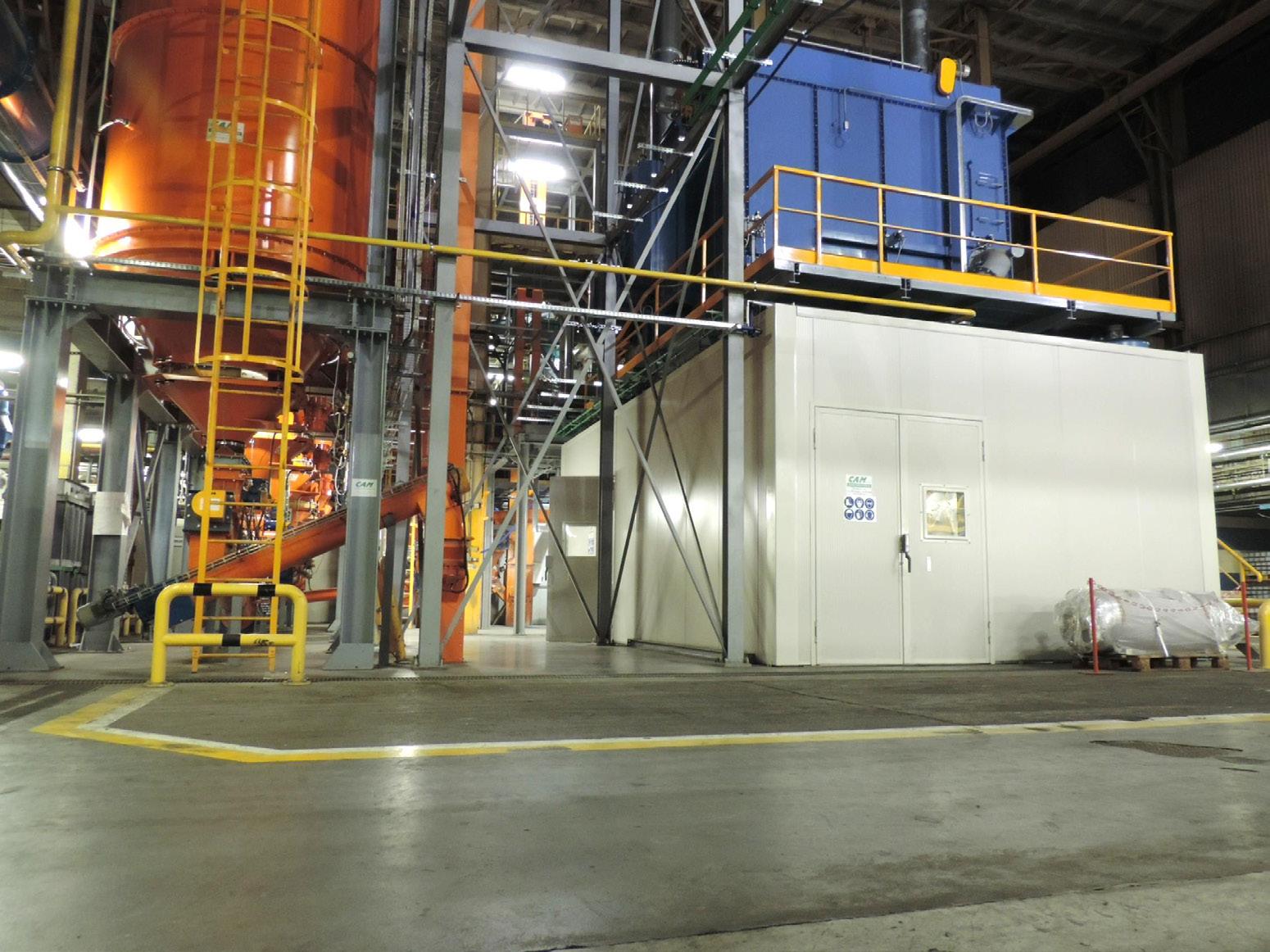
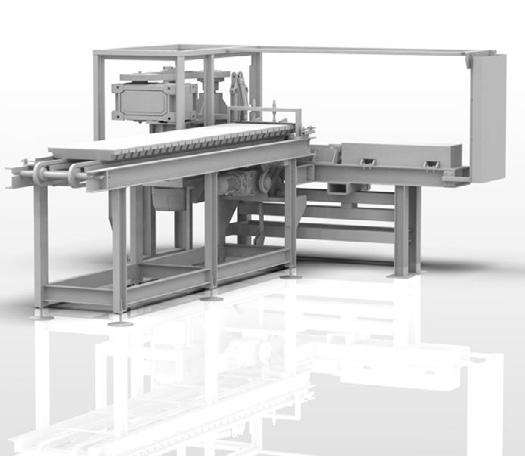

LEAD OXIDE IS THE CORE Find out more! Write Us: info@cam-srl.com Via Pedemontana 13, 66022, Fossacesia (CH) - ITALY Web: www.cam-srl.com Phone: +39 087257724 IMPROVE BATTERY PERFORMANCE WITH THE MOP MILL ONLY tet - PbO thanks to the MOP: The Real Oxide Mill
will have
SCAN ME TO RECEIVE THE CAM BOX
Start producing lead oxide with only a tetrabasic structure and you
a homogeneous plate, with a very strong bond. With a MOP mill you will have: • consistent oxidation • controlled production • ease of production • energy saving
Lithium’s burning, fire, fire!

(But that’s not the complete story.)
The dramatic growth in the use of lithium batteries from small-scale usage to electric vehicles — and now even large size BESS — is being accompanied by a surge in electrical fires. That’s the bad news headline, reports Sara Verbruggen, but let’s not forget that greater safety protocols and technologies are being developed and eagle-eyed insurance companies scrutinizing their progress.
Ten years ago, almost to the month, Sony had to recall some 26,000 laptops around the world warning that its Vaio Fit 11A containing Panasonic batteries was in danger of catching alight — although, to be fair, in fact only three models had overheated.
The trouble then was that this wasn’t the first time it had happened.
Go back almost another decade and you’ll find that in 2006, the company initiated a $360 million global recall
of its own battery packs, affecting Toshiba, Dell, Fujitsu, Lenovo, and Hewlett-Packard users. There had been high-profile fires at conferences and even onboard a plane at LA International. Just two years later some 100,000 Sony computer battery packs were also recalled. This wasn’t just a Sony or Panasonic problem. Fast forward from 2006, 2008 and 2014 to 2024 and similar fears still plague the laptop industry. In the UK, London Fire
Brigade recently urged people not to use their laptops in bed! (to avoid risk of their batteries overheating and catching the bedding alight. The issue isn’t with Sony or Sony’s battery suppliers. Nor is it confined to laptops. It’s generic to lithium batteries and their applications.
Across the world fire chiefs and safety experts have warned, or are warning, of the very real dangers of lithium battery fires. As this magazine was going to press the
COVER STORY: MANAGING LITHIUM SAFETY RISK 60 • Batteries International • Spring 2024 www.batteriesinternational.com
Australian Competition & Consumer Commission had issued a proposed recall notice for some 5000 LG solar batteries after 13 household fires, including one serious enough to burn it to the ground.
In New York the fire authorities are clamping down further on the way that e-bikes can be charged in apartment blocks — lithium battery energy storage systems have been banned in basements of residential and commercial buildings for at least a decade.
Over the past five years in the US alone the cost of lithium battery recalls for EVs can be calculated in the high single figure billions of dollars. And back in Australia to add insult to injury the use of disposable vapes (e-cigarette batteries) has caused a series of rubbish trucks to catch fire — one has even been named Phoenix having caught fire on several occasions!
And in January 2022 Norwegian shipping company, Havila Kystruten announced it was banning electric cars, hybrids and hydrogen vehicles on its ferries because of a potential fire hazard. This follows a risk analysis conducted by Proactima, a Norwegian risk management advisory consultancy, according to chief executive Bent Martini.
The review followed the fire and subsequent sinking of the container ship the Felicity Ace, carrying $400 million of top range electric vehicles.
Exceptions not headlines
But is it fair to paint such a grim picture when accidents are just part of life?
Not really has to be the answer.
As a proportion of the sheer number of lithium ion batteries in circulation, fires are unusual. On a per-motor vehicle basis, ICE fires are far more likely to catch fire that EVs.
That said, EV fires are more difficult to put out. They require a considerably larger amount of water to extinguish. While a burning petrol or diesel vehicle may need 1,600 to 2,000 litres of water to be put out, a fire in an EV often requires as much as 11,000 litres, mainly to cool down the burning battery.
Moreover, the safety protocols put in place means that the regulations are tight as evidenced by some of the huge recalls have demonstrated.
But here lies two problems.
The first is the fact that though lithium fires are relatively rare, the
LiFePO₄, THE INSURERS’ FAVOURITE
GCube advises developers to take into account that insurers prefer to underwrite LFP batteries over NMC batteries or consider other non-lithium options, due to their lower fire risk and higher safety. “LFP has a wider operation
devastation that they create is usually a couple of orders of magnitude greater than regular conflagrations.
Lithium ion cells are prone to thermal runaway, a sometimes explosive chemical reaction caused by a number of factors, such as an internal short circuit, overheating through overcharging or due to external damage, from the cell being pierced or torn.
The second problem is how to ensure safety concerns are addressed as the battery chemistry becomes ever more ubiquitous. It is here that the balance between assessing the risks and insurance possible comes into play.
The ability of lithium ion cells to deliver high power quickly while storing lot of energy, along with their rapid commodification, has underpinned the growth in wireless mobile gadgets, appliances and tools and, more recently, personal mobility devices. Fire suppressant goods supplier Battery Fire Safety says, “Lithium-ion batteries are small and lightweight but are capable of storing a large amount of energy. They are volatile under stress. If damaged or incorrectly charged they can be a fire risk.”
International insurance firm Allianz has issued advice following what it describes as a significant increase in property fire claims caused by lithium ion batteries. It states that the highest risk of a fire occurring is when a battery:
• is being charged.
• is being transported, therefore at increased risk of damage has been damaged previously, as thermal
range than NMC, making it less thermally volatile. It’s also easier to remove pollutants and contaminants from the soil if a fire involved LFP batteries, compared with NMC,” says GCube’s Zeeshan Junedi.
runaway can occur hours, days or weeks later.
• has been abused from over-charging or continual charging and discharging.
EV FireSafe, which is funded by the Australian Department of Defence to research EV battery fires and emergency response, has produced a matrix to show what types of lithium ion battery fire risks can be found in daily use.
• Road registered electric vehicles (EVs, electric motorbikes): very low risk
• Battery energy storage systems, including home and commercial: very low risk
• Smaller devices (laptops, smartphones): moderate risk
• Utility task electric vehicles (vans, carts): moderate risk
• Personal mobility devices (electric scooters, bikes, skateboards): high risk
It also details how long, roughly fires for each category last: five to 30 minutes for a personal mobility device versus hours up to a few days for BESS fires.
Despite these differences in duration of fires, in terms of risk to life or property personal mobility devices and utility task electric vehicles are high risk, while smaller devices and road registered EVs have a moderate risk and battery energy storage systems have very low risk, according to EV FireSafe’s matrix.
EVFireSafe states that BESS installations carry the lowest fire risk
In New York the fire authorities are clamping down further on the way that e-bikes can be charged in apartment blocks — lithium battery energy storage systems have been banned in basements of residential and commercial buildings for at least a decade.
COVER STORY: MANAGING LITHIUM SAFETY RISK www.batteriesinternational.com Batteries International • Spring 2024 • 61
compared with other applications, thanks in part to their use of high quality (so-called tier one) batteries and other components. But when fires have occurred some have had serious consequences.
One event in Arizona, US, in 2019 hospitalized eight firefighters, some with chemical burns, while in 2021 two died trying to put out an energy storage fire in Beijing, China. Other notable blazes of BESS included
the Neoen-VBB fire in Australia in August 2021 when the fire at a Tesla Megapack installation set alarms about the speed of scaleups.
But it is also worth remembering most of these can be regarded as teething problems.
The container fire at a 20MW BESS blaze in Liverpool in November 2019 was Danish power company Ørsted’s first standalone grid-connected battery project, built using
storage system equipment supplied by the now-defunct Energy Solutions division of NEC Corporation, housed in three containers.
Similarly too, the ENGIE fire in November 2017 took place at an experimental site in Drogenbos (near Brussels) of a 20MW facility that took half a day to extinguish.
Perhaps the biggest headline came from a series of ESS fires in South Korea between 2017 and 2019
ONE IN THREE ELECTRICAL VEHICLE FIRES OCCUR IN PARKED VEHICLES ... WITH ‘NO OBVIOUS CAUSE’

One in three electric vehicles fires has occurred with ‘no obvious cause’ while the car was parked, according to a 2021 report by research consultancy IdTechEx.
The startling figures show that 17% of EV fires occur in regular driving and a quarter occur when charging.
More predictably, 20% of fires occur in a crash situation or 4% when immersed in water when the reactive lithium is exposed to the air or water.
IdTechEx’s report —Thermal Management for Electric Vehicles 2021-2031 — also points out that the cost of recalls to solve problems continues to be hugely expensive and sometimes intractable to solve.
GM’s first recall of the Bolt in 2020, for example, entailed a call back of 69,000 cars produced between 2017-2019 for potential battery fires.
“The ‘solution’ was a software update limiting the battery capacity to 90% and an inspection of the battery,” says the report. “In 2021, two more Bolts have caught fire,
both of which had the recall.
“Continued investigation between GM and LG Chem has determined the cause is the ‘presence of two rare manufacturing defects in the same cell’. This has prompted another recall by GM to replace the battery modules.
“This recall is said to have cost GM around $11,000 per vehicle, totalling nearly $800 million.”
Other carmakers have faced similar bills. Hyundai, for example, recalled 82,000 EVs due to battery fire risk at an estimated $900 million. Much of this was paid for by LG Chem, the report says.
“Ford’s Kuga plug-in hybrid also faced issues with cells supplied by Samsung, resulting in a recall of 33,000 cars costing Ford approximately $400 million,” it says.
The effects of EV fires are typically far more severe than fires in conventional ICE vehicles. A Tesla Model S fire required nearly 30,000 gallons of water to extinguish it because “it kept reigniting, burning continuously
for over four hours,” says one media report. By comparison, a typical car fire involving a ICE can be extinguished with about 300 gallons.
One effect of these high-profile fires and their severity is their press coverage, which runs contrary to the desire of governments and OEMs that have recently been setting out bold decarbonization targets based on energy storage for fossil-free renewables.
The reports concludes: “We expect EVs to continually improve in safety, there will always be the risk of a battery fire due to many potential causes. This presents an opportunity for those material suppliers making thermal interface materials, flame-retardant materials, or fire protection materials. These materials can help with the thermal management of EV batteries making it less likely they will overheat.
“Fire-retardant construction materials and fire protection materials are beneficial to enclose a fire or prolong the time between a thermal runaway event and the fire exiting the battery pack.”
Regulations are also evolving in the UK. China implemented new EV fire safety regulations at the start of the year, which include a five-minute warning between a thermal event and fire or smoke exiting the battery pack.
The EU also has various draft regulations with a similar focus.
IDTechEx expects regulations in this field to become more stringent, presenting greater opportunities for material suppliers.
COVER STORY: MANAGING LITHIUM SAFETY RISK 62 • Batteries International • Spring 2024 www.batteriesinternational.com

“A holistic solution includes not just fire suppression for lithium ion batteries but this other equipment as well”
— Brian Cashion, Firetrace International
where some 21 separate events resulted in the temporary shutdown of 584 facilities.
Compared with other renewable energy sectors, such as wind power and solar photovoltaics, the BESS industry is less mature. The last few years have been focussed on getting these assets built and connected to the grid.
Now data is emerging underscoring that more can be done to reduce failures and fire risks.
A study published by Clean Energy Associates (CEA) this February found that 26% of inspected energy storage systems had quality issues related to the fire detection and suppression system while 18% of inspected systems had quality issues related to the thermal management system.
Brian Cashion, an engineer at fire suppression systems provider Firetrace International, says: “As well as addressing lithium ion fires there is other equipment in the BESS that poses a fire risk, such as some of the power conversion equipment, chiller equipment and so on. A holistic solution includes not just fire suppression for lithium ion batteries but this other equipment as well.”
Firetrace is targeting US based and international players selling battery storage systems in the US. Maintaining proper exposures is crucial to
prevent any BESS fire from spreading to other containers or other nearby buildings or structures, Cashion says.
“It is also important to look at how batteries and ancillary components within the container are arranged and connected, such as spacing between modules, to prevent fire from happening or spreading.”
He says OEMs and systems integrators should be performing risk analyses looking at the design of the battery and the battery module, the unit as a whole and also the installation as a whole and doing hazard analysis to determine where risks are.
“We are seeing variations in requirements and standards, based on where BESS will be installed, not only within North America but internationally. It reflects the infancy of this market and lessons are being learned from events that have happened. As a result, codes and standards are being updated as the industry learns more so it is important to keep up with these as they change and in terms of what local authorities require,” says Cashion.
Thermal runaway and other failures are also more frequent in their early years of operation. More than half of BESS failures happen within the first two years of operation, according to fresh analysis published by renewable energy projects insurance underwriter GCube.
BESS projects are vulnerable to mechanical breakdown and serial defects. Adding a new dimension to risk management for the BESS industry is the threat of thermal runaway fire and off-gassing, says its report, Batteries not excluded — Getting the insurance market on board with BESS.
REASONS TO BE CAREFUL (PART 1)
The failure of lithium-ion batteries and the consequent risk of overheating and thermal runaway can be caused, among other things, by:
• Internal design or manufacturing defects, such as, for example, material defects (electrode, separator, electrolyte), contamination, assembly, or construction faults
• Physical damage during construction, assembly into finished products, shipping, handling, waste disposal or during use; whether accidental or malicious
• Physical damage with mechanical effects, such as crushing, excessive vibration, impact
• Rapid degradation of batteries over time
• Undetected ageing and subsequent internal short circuit
• Effect of use:
— Rapid charging
— Discharging the device faster than necessary
• Use or storage in wet environments
• Thermal effect:
• Exposure to high temperatures
• Exposure to flames
• Heat from adjacent or nearby cells
• Low temperatures, mainly during charging
• Electrical effect:
— Excessive overcharging or over-discharging
— Short circuits
“From extensive discussions with the industry, involving companies that specialize in condition monitoring of BESS, the likelihood of thermal runaway is highest at first power/commissioning phase and then during the initial operation of the system, within that first two years. This is likely due to the changes in battery cells being picked up via the BMS and monitoring software,” says Mohammed Zeeshan, an underwriter at GCube.
GCube’s analysis draws upon
Compared with other renewable energy sectors, such as wind power and solar photovoltaics, the BESS industry is less mature. The last few years have been focussed on getting these assets built and connected to the grid. Now data is emerging underscoring that more can be done to reduce failures and fire risks.
COVER STORY: MANAGING LITHIUM SAFETY RISK www.batteriesinternational.com Batteries International • Spring 2024 • 63
a decade of public data sourced from the US-based Electric Power Research Institute’s BESS Failure Event Database, which reveals that the market now sees around 10 failures reported on average each year — a 10-fold increase compared with 2016.
Failures, including those resulting in fires, are likely to continue to increase but this will be due to more BESS installations in operation than at any other time.
Critical design considerations
When designing the BESS layout, ample spacing between battery modules, racks, containers, or buildings can mitigate fire and explosion risks. Anything less 2.5 metres between containers or clusters significantly affects insurers’ exposure.
Measures that mitigate fire risks in BESS design mean insurers look on them more favourably and that can also be relevant to battery safety management plans, which developers should submit as part of their planning applications.
These might be elevation of the BESS in case of flood risk, vegetation management, especially during the summer to reduce fire hazards, and ensuring that the local fire department has good access so that a truck can come in so that the fire can be managed if not put out. Seismic considerations are now also being taken into account.
Maintaining proper exposures is crucial to prevent any BESS fire from spreading to other containers or other nearby buildings or structures, Cashion says, “It is also important to look at how batteries and ancillary components within the container are arranged and connected, such as spacing between modules, to prevent fire from happening or spreading.”
OEMs and systems integrators should be performing risk analyses looking at the design of the battery and the battery module, the unit as a whole and also the installation as a whole and doing hazard analysis to determine where risks are.
In the event of project failures, the least likely cause is cell failure, while a higher probability is linked to BMS failure and the non-cell related infrastructure such as cabling or where connections are terminated, says Zeeshan. “As the containerized BESS space and projects are quite new, it will be over a year to 18 months or more till we have sufficient data to establish accurate trends on why failures, including fires, occur,” he says.
Looking to the future, he believes one area with lots of potential to improve the safety of BESS assets is the use of software. “The BMS has attracted a keen focus and is where we believe investment should be made. But it is also promising to see companies that have developed condition monitoring software.”
This can process data from multiple individual BMS in each container across various projects and sites, to generate comparative analysis. “This means that you are not only flagging an event, such as cells in a rack in a container crossing a temperature threshold, but also the action that needs to be taken,” Zeeshan says.
One of the worst things you can do to a lithium ion battery cell is crush it, pierce it or tear it. In a lithium ion cell, the cathode and anode electrodes are physically separated by the separator. Any defects or damage, from an external force that compromises the separator’s integrity can cause an internal short circuit leading to thermal runaway.
While batteries are manufactured with controls for protecting against this happening, in certain environments where these controls are not incorporated or are damaged such as during processing of waste for example, chances of thermal runaway are increased.
Waste fires too
Worldwide evidence is mounting that lithium waste fires are on the rise. Exact up-to-date data, that is standardized is hard to find but in 2021 the UK-based Environmental Services
We are seeing variations in requirements and standards, based on where BESS will be installed, not only within North America but internationally. It reflects the infancy of this market and lessons are being learned from events that have happened

“In the event of project failures, the least likely cause is cell failure, while a higher probability is linked to BMS failure and the non-cell related infrastructure”
— Mohammed Zeeshan, G Cube
Association (ESA) and Eunomia published a report suggesting that lithium ion batteries cause 201 waste fires, equating to 48% of all waste fires occurring in the UK each year, at a cost of around £158 million annually, up from 25% in 2016.
The ESA told this magazine that although an update to this figure was being updated, the clear trend was that this was on the increase. In many ways this is to be expected given the greater number of lithium batteries in circulation.
Battery Council International has been campaigning for almost a decade about better labelling and standardization of lithium batteries given that greater numbers are entering lead recycling battery streams across North America over the past years.
It says there are genuine concerns that explosions and runaway fires in lead battery processing facilities will maim or kill employees.
According to ESA executive director Jacob Hayler, carelessly discarded batteries are responsible for at least one significant fire at a recycling and waste management facility in the UK every day.
COVER STORY: MANAGING LITHIUM SAFETY RISK 64 • Batteries International • Spring 2024 www.batteriesinternational.com


A
the benefits and
advantage your company can experience from our TPPL
by calling +1.810.987.7600 or emailing sales@wirtzusa.com. www.wirtzusa.com INNOVATIVE | RELIABLE | PERFORMANCE The Wirtz Group of Companies THIN PLATE PURE LEAD your one source solution
OVER
DECADE OF TECHNOLOGIES AND PROCESSES SPECIFICALLY DESIGNED FOR TPPL PRODUCTION: CONTINUOUS GRID CASTING PRECISION PASTING SORTING - STACKING OFF LOADING - PALLETIZING Discover
market
processes
User generated content — endorsements and validations from the internet — looks set to be the way forward for marketing and battery businesses large or small.
Marketing in the brave new world of UGC

Battery industry marketers looking for a way to discover, curate and re-share all the positive comments that are surfacing on social media about their brand now have a solution.
These platforms deploy User Generated Content — better known as UGC — and provide services are designed to discover brand-affirming content on social media about a battery business. It curates it and then automatically re-share it as authentic endorsement from the people who actually use the products and services.
Plus, most of the platforms also enable company marketers to automatically find positive sentiment —
and then place a hold on that content until company marketers decide where-and-when they’d like the kudos re-posted, if at all.
Kyle Wong, chief strategy officer, Emplifi, a digital marketing firm, says: “Using social media as a vehicle to
Some 83% of consumers are more likely to buy from a brand that uses UGC content — rather than traditional advertising
source user-generated content from customers is a scalable and powerful solution for brands.”
For many battery industry marketers, re-sharing authentic customer endorsements that crop-up on social media seems like a no-brainer. Jimmy Stewart, vice president, sales and marketing, MAC Engineering says: “An automated way of searching out the information to re-share on our site would be a benefit. At present we have to manually search.”
Simon Engelke, founder of Battery Associates — whose company makes a point of manually seeking out, curating and re-posting positive testimonials about Battery Associates on
SOCIAL MEDIA: KEY TO BATTERY FUTURES 66 • Batteries International • Spring 2024 www.batteriesinternational.com
social media — agrees: “It would be helpful if we could automate collecting such testimonials and share them on the web site.”
Either way, re-sharing positive social media sentiment — via a manual or automated system — has some powerful numbers affirming the practice. A 2023 study from EnTribe, for example, found that 86% of consumers are more likely to trust a brand that uses content from actual customers — rather than paid influencers (https://www.entribe.com/ resource/the-state-of-ugc-2023).
The same study found that 83% of consumers are more likely to buy from a brand that uses UGC content — rather than traditional advertising.
Meanwhile, a study from Harris Poll found that 58% of consumers place a high value on product pictures or videos from customers who have already purchased the product or service.
Equally eye-opening is that same 58% said endorsements from those existing customers were more important to them than product price, shipping costs or company return policies.
Richard Jonach, business unit and sales directory, Battery Machines says: “Positive word-of-mouth marketing is always good and important. It keeps you in the loop of upcoming new investments — and reminds those companies to ask for a quote.”
Plus, social networks also enable Battery Machines to “keep the industry up to date about what’s going on in our company,” he says.
William Foreman, director of corporate communications and government affairs, Orion SA, reports that his company has had its best success with social media on LinkedIn: “It’s an excellent platform to engage with customers and industry leaders.”
Geoffrey May, director, FOCUS Consulting, has also found the best result comes from LinkedIn. It “provides better contacts than others,” May says.
While some battery industry marketers are already leveraging UGC by inviting, closely helping develop and then publishing one of the most popular forms of positive sentiment — video testimonials — on their web sites and across social media, UGC platforms primary focus on already existing videos that simply need to be discovered.
Many in the industry have already seen these videos on YouTube and similar services. Some are impromptu
video reviews by customers that offer the pros and cons of a product or service. Others are so-called ‘unboxing’ videos that give the basic facts about what to expect when you buy a particular product.
Still others offer detailed demonstration videos by satisfied customers that offer helpful tips on how to use a product — or how to use a product most effectively.
In addition, UGC platforms go beyond video to discover and repurpose other formats of UGC, including text-based social media posts, text-based reviews, text-based comments in online forums, Tweets, podcast content — and virtually any other form of content found on social media.
Granted, battery industry marketers can search manually for all this free promotional content that’s just waiting to be used. Essentially, there’s nothing stopping them from spending hours each day visiting the scores of social networks that are most likely showcasing such endorsements.
But fortunately, UGC platforms are designed to relieve battery industry marketers of this busy work. They use hashtags, keywords, key-phrases and similar search variables to automatically scan for UGC promotional content on all the social media hangouts that marketers monitor.
Besides using UGC platforms to mine social media for already existing positive content generated at the grassroots, many of these services also help marketers prime-the-pump with tools that are designed to encourage everyday customers to produce positive UGC.
These tools include templates marketers can use to orchestrate giveaways, awards, contests, or exclusive access to special deals in exchange for positive UGC.
Given that there are a wide variety of UGC platforms vying for the social media needs of battery industry marketers, most will likely want to go for a best-of-breed solution. These services go beyond simply helping one discover, curate and re-share UGC content that sings that company’s praises.

“The insights you gain from personally engaging with your community are often priceless. Thus, having everything automated might be a step away from that and should be thoroughly evaluated before implementing” — Gudim Lilleeidet, Borregard
Instead, they also offer tools that enable one to secure media rights — when necessary — from the creators of UGC one might like to use to promote one’s battery business. And they also enable one to auto-integrate UGC favorable to the brand into one’s ecommerce store.
For example: many of these platforms enable one to automatically integrate images of a number of positive Tweets about a specific product into the description you have of a product or service in your online shop.
They can also do the same with positive comments found on other social networks by auto-posting those comments into the description one has of a product or service in one’s online shop.
Plus, top UGC platforms also offer analytics and reports detailing how well the UGC you find-and-use is
A 2023 study from EnTribe found that 86% of consumers are more likely to trust a brand that uses content from actual customers — rather than paid influencers
SOCIAL MEDIA: KEY TO BATTERY FUTURES www.batteriesinternational.com Batteries International • Spring 2024 • 67

performing on your web site, in your ecommerce store — and across social media.
Of course, despite all the advantages offered by the automated re-posting of positive social media comments, some battery industry businesses believe the tech should be used judiciously.
Gudim Lilleeidet, digital marketing specialist, Borregaard, for example, indicates he’s more inclined to use of a mix of automated re-posting of positive comments — along with human-to-human interaction on social media.
He says, “the insights you gain from personally engaging with your community are often priceless. Thus, having everything automated might be a step away from that and should be thoroughly evaluated before implementing.”
Lana Mercer, senior marketing manager, Event Partners — organizers of the Battery Cells & Systems Expo 2024, takes this further: “Automation can ensure that positive comments are shared consistently across different social media platforms. However, it’s important to note that while automation can streamline this process, the input of our marketing team is still crucial.
“Automated systems may not always capture the nuances of sentiment or context accurately — and there will always be instances where the intervention of our team is necessary.”
“Automated systems may not always capture the nuances of sentiment or context accurately — and there will always be instances where the intervention of our team is necessary”
— Lana Mercer, Event Partners
Klass Nilsson, director group communications, Boliden, is even more cautious, noting that many of the interactions the company engages in on social media are often in-depth, chats. The “questions are often complex and in many cases require thoughtful consideration,” Nilsson says.
Again, most UGC platforms already anticipate that many marketers prefer to decide in advance the kinds of
UGC PLATFORMS
positive sentiment that can be automatically re-posted — and the kinds of content that needs to be held and curated before it’s judiciously re-posted.
The bottom line is that UGC platforms are at least worth a serious investigation from any battery industry marketer looking to easily find and re-purpose all the positive UGC about their brand that’s scattered across social media ecosystem.
Here’s a representative sampling of the kinds of UGC platforms available
EmbedSocial* www.embedsocial.com
This UGC platform specializes in gathering positive UGC from across social media, helping users curate it — and then re-publishing the content on a company’s web site.
The service features five tools: Embed Album, which embeds positive UGC photos on your web site using a widget. Then there’s EmbedReviews, which embeds Google and Yelp reviews on your site. And EmbedFeed, which replicates content from a specific social media network on a ‘brand wall’ on your web site.
*EmbedSocial also offers EmbedForms, which you can use to create and solicit customer satisfaction surveys. And there’s EmbedStories, a widget that collects and publishes Instagram stories on your web site.
Tagembed www.tagembed.com
Tagembed scans 21+ social media networks for UGC that’s positive about your battery business, including Instagram, Facebook, Twitter, YouTube, TikTok, Google Reviews and Airbnb. It also helps you curate the content you find and then embeds the UGC you’d like to use on a so-called ‘wall’ on your web site using a widget.
Taggbox Widget www.taggbox.com/widget
Taggbox relentlessly searches 20+ social media networks for UGC content that you can use on your web site with their presentation widget. Formats that are easily handled by the widget include social media feeds, videos, reviews and hashtag content.
Flowbox www.getflowbox.com
Endorsements from existing customers were more important to them than product price, shipping costs or company return policies
StoryStream www.storystream.ai
StoryStream integrates user generated video into ecommerce stores. The resulting promotional UGC includes the content itself as well as a link to a bio.
Battery industry marketers can use Flowbox to collect UGC and paid promotional content — and then re-share that content on a web site, ecommerce store or across a number of social media networks.
SOCIAL MEDIA: KEY TO BATTERY FUTURES 68 • Batteries International • Spring 2024 www.batteriesinternational.com
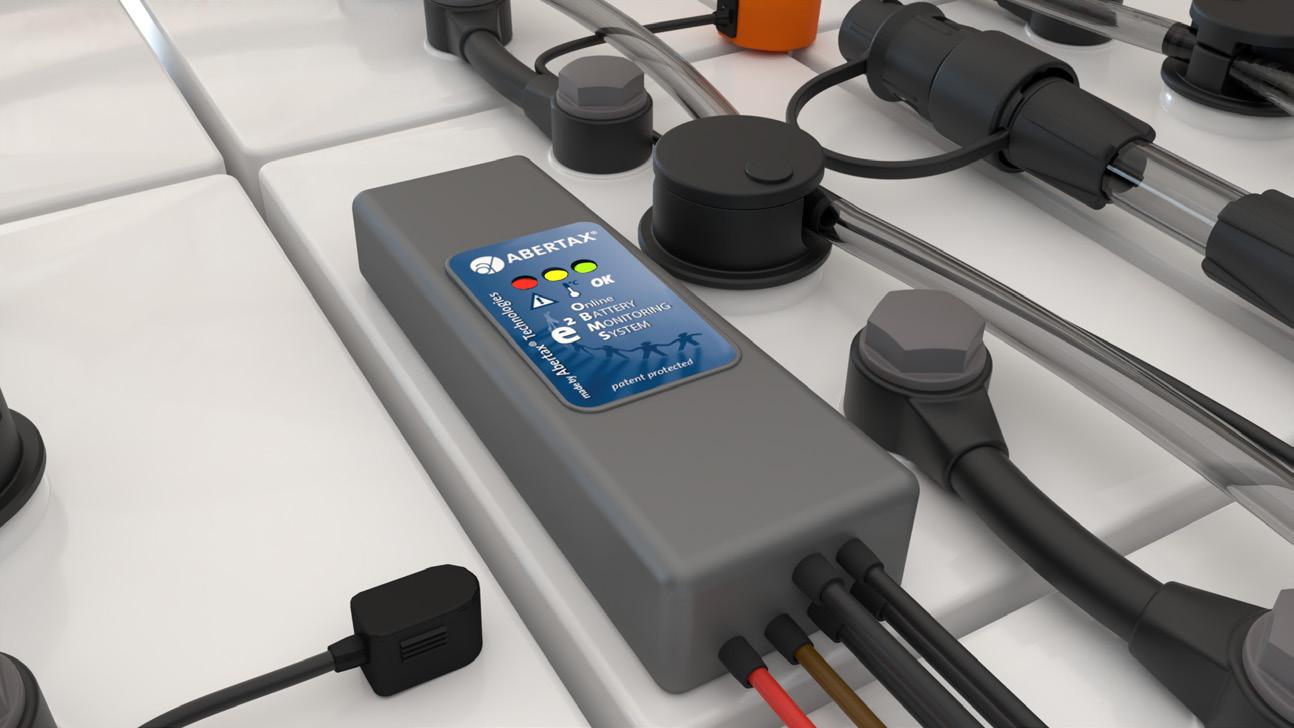









ABERTAX® WIRELESS BATTERY MONITORING SYSTEM The e2BMS is a state-of-the-art wireless technology Battery Monitoring System. Wireless

Energy efficiency has become a critical topic for the European battery industry, especially given the energy price increase scenarios since 2022. Micha Kirchgessner, R&D laboratory manager for PENOX, shows that the use of red lead is a key factor for higher efficiency in the formation of lead-acid batteries.
Cost savings from the use of red lead in battery formation
PENOX has investigated the impact of different contents of an industrial grade of red lead in combination with Barton oxide on the formation energy needed to form a cell completely. The Barton oxide had a free lead content of 25% to 27% with a d50 particle size of about 3μm, and the red lead had a lead dioxide (PbO2) content of 25% to 27% and a d50 particle size of about 4.5μm.
The benefits of using red lead in formation have been studied in depth, and this first article is focused on the effects of using red lead in PAM on formation efficiency and duration.
Reference system and test cell
The tested cell group is a 2V flooded cell with one positive and two negative plates. The positive and negative plates are based on gravity-cast L3 size grids thickness 1.35 mm). The positive plate is enveloped and has a nominal C20 capacity of 12.5Ah. The cell design used for this study was chosen for single plate testing of the positive plate under controlled conditions, ensuring that the positive plate limits the test cell’s performance.
For capacity and cycle life testing, 300 g of diluted sulfuric acid electrolyte with a density of 1.28g/cm3 (±0.005g/cm3) at 20°C to 22°C was used. Please note that this amount of electrolyte is sufficient for a capacity of 13Ah. The density at a full discharge of 13Ah reaches 1.18g/cm3. The theoretical limit at which acid limitation is reported is at a density of 1.2g/cm3. [1]
The negative plates used for this study were produced by a European manufacturer of automotive batteries. The positive plates were pasted
in the laboratory of PENOX, and the pastes were based on Barton oxide and red lead. Different PAM paste recipes were used, and the mixes were prepared in an Eirich R01 mixer. Percentages for the content of any compounds in this study are stated in weight-% (%).
Formation profile
The formation was carried out in an electrolyte with a density of 1.15g/ cm3 at a controlled temperature. The latter was systematically varied between 25°C, 35°C, and 45°C for different tests. The same basic forma-
tion profile was used for all investigations, and the formation factor (FF) was systematically varied by modularly adjusting the number of formation steps at the end of the formation profile — see figure below.
The formation factor represents the coulombic efficiency of formation and is calculated by dividing the charge capacity used to form the cell or battery by its nominal capacity. A more accurate comparison would, of course, be to refer to the real capacity.
However, in battery manufacturing, the standard nominal capacity is used. It is thus based on capacity
Up to a red lead addition of around 30% in the leady oxide mix, the required minimum formation factor for complete formation is reduced nearly linearly with an increasing content of red lead
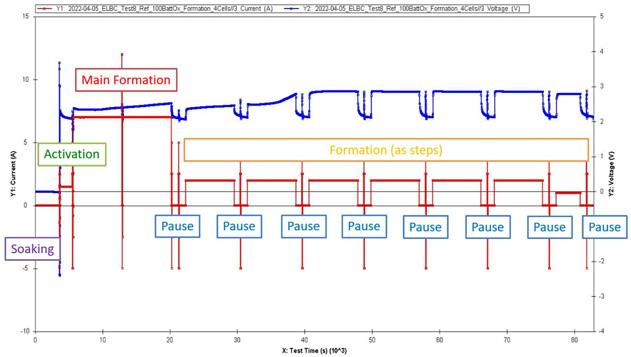
CONFERENCE IN PRINT: PENOX, RED LEAD 70 • Batteries International • Spring 2024 www.batteriesinternational.com
Figure 1: Basic formation profile used, with the different formation steps marked to show the distinct parts of the formation process.

values measured in Ah. In contrast, the energy efficiency in formation is based on the amount of energy in Wh required to form a battery completely. The formation energy includes the cell or battery voltage during formation.
The resulting PbO2 content was analysed in the positive plates. A ‘two-shot formation’ process was used in this study. This simple process means that the electrolyte was changed after the formation was completed.
The diluted sulfuric acid electrolyte used for further testing had a density of 1.28g/cm3. The formation process used in this study is described in Figure 1 (facing).
While the formation factor was systematically varied by applying a different number of formation steps with reduced current, the current densities and other conditions were kept constant. The latter is important to keep all mass transport-related parameters constant, allowing a better comparison of the results.
After formation, a structural investigation of the cured plates was performed, and the PbO2 content of the positive formed plates was determined using a standard titration process, with a PbO2 content target of 85% ±3%.
Thus, in this study, >88% PbO2 represents an over- formation, and <82% PbO2 represents an under-formation.
Aside from the structural analysis, electrical testing of the initial C5 capacity and capacity evolution was carried out, and the impact of the negative plate was also investigated.
This study follows the strict principle of forming the positive active mass to ideally 85% of PbO2 with only a low tolerance of the PbO2 content. PENOX recommends this to avoid overcharging, as this damages the positive plate.
Furthermore, an undercharged PAM does not have a fully developed formed structure of the positive electrode. The remaining lead sulfates within the active masses are transformed into sulfuric acid during the operation of the battery in the respective applications. Therefore, depending on the battery technology, there is a second target concerning the maximum lead sulfate content of the positive and the negative plate. This value differs depending on the battery manufacturer.
Lead sulfate still contained within
Red lead added to the leady oxide mix of the positive active mass (PAM) allows for a significant formation factor reduction. The effect of red lead addition is not linear. Thus, an optimum content can be observed depending on the plate technology, the plate group design, and the respective battery technology.
Even a small addition of 10% red lead to PAM already enables a formation factor reduction from 3.7 (reference) to 3.1 in this study, representing a significant reduction in coulombic formation efficiency of more than 15%.
An increase of the red lead content in PAM to 25% allows for a further formation factor reduction to 2.0, which equals a substantial increase in formation efficiency of almost 50% versus the reference cells without red lead.
When the red lead content in PAM is increased to 50%, an even lower formation factor of 1.5 can be achieved. This equals a reduction of 60% versus the reference cells without red lead. In PENOX’s experience, such high red lead content is used primarily in thicker industrial grids and for industrial tubular technology. For automotive technologies, the red lead content of interest is well below 50% and typically between 10% and 20%.
Note that 100% red lead content does not allow for a welldeveloped 4BS structure, and
Even a small addition of 10% red lead to PAM already enables a formation factor reduction from 3.7 (reference) to 3.1 in this study, representing a significant reduction in coulombic formation efficiency of more than 15%
PENOX does not recommend using such high content of red lead, as this, in terms of energy efficiency, is not the optimum solution. In this study, we observed a slight increase in the formation factor resulting from mono-basic lead sulfate (1BS) in the cured active mass structure. Also note the experimental data indicates that adding a minimum of 10% up to 30% red lead significantly improves formation efficiency. PENOX considers this range to be optimum in terms of formation efficiency and optimal to reduce the carbon dioxide footprint.
The economic optimum is harder to analyse, as several factors differ by region and are essential for the result. In general, red lead is increasingly attractive with higher electricity prices, and an additional driver is the ability to reduce the process time.
The experimental data indicates that adding a minimum of 10% up to 30% red lead significantly improves formation efficiency. PENOX considers this range to be optimum in terms of formation efficiency and optimal to reduce the carbon dioxide footprint
the plates after formation will slowly be charged in regular battery operation. The latter increases the acid density of the cell or battery. As the content of lead sulfate tends to vary more for a lower state of formation (ie, for underformed plates), this can cause inhomogeneous electrolyte densities in different cells. Such variation of the electrode density impacts
the open circuit voltage and, thus, the overvoltage controlling the charging process.
Impact of red lead on formation factor (Coulombic efficiency)
Red lead is typically mixed with a ‘grey oxide’, such as Barton or mill oxide. As well known and reported in literature [2], red lead is higher oxidized
CONFERENCE IN PRINT: PENOX, RED LEAD www.batteriesinternational.com Batteries International • Spring 2024 • 71
PUTTING IT ALL TOGETHER

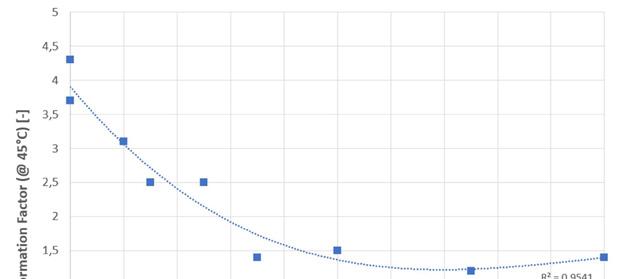

and will release PbO2 by contact with sulfuric acid. At the beginning of the formation process, PbO2 is already formed during the soaking step and thus is available depending on the type and content of the red lead.
As expected, the initial PbO2content in PAM significantly affects the formation efficiency. A shorter formation time leads to a reduced overall charge capacity in Ah. In addition to this, PAM conductivity is increased directly at the beginning of formation when PbO2 from red lead is present. Lead dioxide introduced by red lead can also act as a growth template for the porous PbO2 structure of the PAM, which is created during the formation process. Higher conduc-
tivity and lower overvoltage result in a lower average cell or battery voltage during formation, which equals lower charge energy in units of Wh.
The formation efficiency is higher when the same average PbO2 content in the formed positive plate is achieved with a lower formation charge. Figure 2 shows the results of this study concerning the impact of the red lead content in PAM on formation efficiency. The Coulombic formation efficiency is represented as the minimum formation factor (FF) on the y-axis for the respective Red Lead content in the PAM shown on the x-axis. (Please note that the Coulombic efficiency’s explicit value is the formation factor’s inverse.)
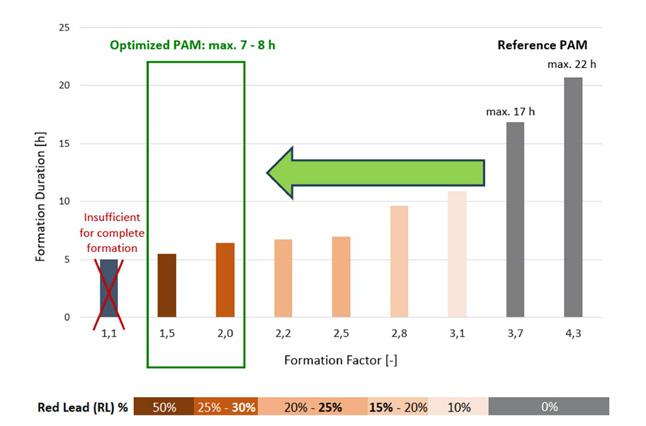
For instance, a formation factor of 4 means that four times more electric charge in Ah is used in the formation process that can be discharged after the formation. Thus, in this case, the efficiency of storing electrical charge (Ah) in chemical form within the active masses during formation is 25%.
Due to the PbO2 content of red lead in the leady oxide mix of the cured plates, these plates have an improved intrinsic electric conductivity that increases with a higher PbO2 content.
The conductivity of the semiconductor type of PbO2 is high and overall in the range of 105 S/m (metallic lead has a conductivity of 4.8 x 10⁶ S/m). The different crystallographic forms, mainly the alpha- and beta-PbO2, have slightly different conductivity. [3]
The experimental results in Figure 1 show that:
• up to a red lead addition of around 30% in the leady oxide mix, the required minimum formation factor for complete formation is reduced nearly linearly with an increasing content of red lead.
• For a ca. 30%-50% red lead dosage, there is still an additional benefit regarding a formation factor (FF) reduction.
• Red lead addition rates beyond 50% will not further improve Coulombic formation efficiency.
A content of 100% red lead in PAM requires a higher FF for complete formation than a content of 75% red lead, as it does not support 4BS curing and instead results in a mixed 1BS/3BS structure.
The content of mono-basic lead sulfate (1BS) is attributed to a negative impact on the formation process. Please note that 100% of red lead is used in a traditional process that, in the experience of PENOX, is still maintained for submarine batteries and some Motive Power (i.e., traction) applications.
Impact of red lead on formation duration
The impact of the red lead content in PAM on formation time, running the formation profiles similar to Figure 1, was analysed, and Figure 3 gives an overview of the findings. It shows the formation duration for each formation factor used in this study.
Reducing the formation factor from about 3.7 for the reference cells to about 2 is made possible by the use of red lead. The modular formation
CONFERENCE IN PRINT: PENOX, RED LEAD 72 • Batteries International • Spring 2024 www.batteriesinternational.com
Figure 2: Impact of the red lead content in unformed PAM on formation efficiency: Minimum required formation factor for different red lead contents required to achieve a complete formation, i.e., a PbO2 content of ≥ 85%.
Figure 3: Impact of red lead on formation time. Formation duration per formation factor (PENOX – flooded LA Technology).
program used for this study allows for a significant formation time reduction from about 17h to a maximum of 7h or more than 50%.
Even with the optimised test cells, a formation factor of 1.1 is insufficient to achieve the target of 85% PbO2 for a complete formation. This is unsurprising, as this formation factor would be in the same range as a standard charging factor (CF) for cells or batteries based on flooded technology (e.g., 2V PzS Motive Power after 70% DoD, using an IUIa charging profile).
The discharged positive active mass (PAM) of such motive power cells contains about 20% of PbO2 at 80% DoD. Furthermore, the negative plate contains a minimum of 10 to 15% spongy elemental lead.
In contrast, an unformed cell, even with 50% red lead (PENOX industrial grade), contains only about 13% of PbO2
Furthermore, the unformed negative plate contains less than 3%
elemental lead (free lead) without a conductive network of spongy lead. Thus, it is understandable that the formation process runs at a lower efficiency than charging a discharged battery from 20% SoC to 100% SoC.
Impact of red lead on CO₂ emissions
The impact of red lead on carbon dioxide emissions was also investigated as part of this study, and the associated calculations were done with data based on the German energy mix with about 400g of carbon dioxide per kWh of electricity. [4]
It was found that even an addition of 10% of red lead already leads to a significant reduction of around 20% in total CO2 emissions. Increasing the red lead content from 10% to 25% reduces CO2 emissions significantly.
At 25% red lead content, total CO2 emissions per plate are reduced by almost 50% versus the reference without red lead.
At 50% and higher red lead addition

rates, there is no further relevant decrease in the total CO2 emissions per plate.
REFERENCES:
[1] D. Pavlov, Lead-acid Batteries: Science and Technology; A Handbook of Lead-acid Battery Technology and its Influence on the Product, Bulgarian Academy of Sciences, Elsevier, P. 129ff, 2011
[2] Bode, Lead-acid Batteries, John Wiley & Sons, Inc., P. 17, 1977
[3] D. Pavlov, Lead-acid Batteries: Science and Technology; A Handbook of Lead-acid Battery Technology and its Influence on the Product, Bulgarian Academy of Sciences, Elsevier, P. 353ff, 2011
[4] Statista, https://www.statista.com/ statistics/1290224/carbonintensity- power-sector-germany/, Value for 2022
PENOX EXPANDERS
PENOX EXANDERS
Improved Battery Performance
↗ High current charge acceptance
↗ Dynamic charge acceptance
↗ Life time
↗ Cold cranking
↘ Water consumption
All Battery Applications
EFB: In combination with TBLS+® for negative AM
EFB expander formulations

CONFERENCE IN PRINT: PENOX, RED LEAD www.batteriesinternational.com Batteries International • Spring 2024 • 73
EXTEND YOUR BATTERY’S LIFE
NEW
Brian Wilson, a former safety and risk consultant dealing with secondary lead recycling working with the ILA and United Nations health programs, details ways of handling risk and return using hedging techniques.
Mitigating the financial risks when operating a secondary lead plant
Operating a secondary lead recycling business involves various financial risks, particularly when sourcing used batteries from both domestic and overseas markets.
This article analyses the potential financial risks associated with this, especially given the average period between purchasing the used batteries and recovering the lead and associated biproducts for sale to be between four to six weeks.
The risks considered include supply chain management, stock and working capital controls, market volatility and hedging, currency exchange rates, transportation costs, quality control, payment and credit controls protocols, and the impact of international regulations. Understanding and mitigating these risks is crucial for business owners to implement effective risk management strategies and maintain financial viability.
The secondary lead industry plays a pivotal role in sustainable global resource management. Metallic lead is the most recycled commodity worldwide and yet the sector receives no government subsidies, tax relief or financial assistance. The industry must operate commercially outside of the public purse. Indeed, any secondary lead business must take all the financial risks. So, identifying, understanding, and mitigating the financial risks is a fundamental business survival strategy.
First and foremost, in any recycling business is the supply of sufficient feedstock.
Secondary lead recycling plants depend on a constant reliable supply of used batteries to maintain operational efficiency. Any shortfall in supply limits or disrupts the production process, leading to underutilization of resources, idle machinery, and increased operational costs relative to the output and possibly missed sales contract commitments.
As simple and convincing as the mathematics appears to be for hedging refined lead and currencies, hedging should be assigned to professional organizations that understand the LME rules and regulations for hedging metals on the futures market
Furthermore, a recycling business relies on a continuous flow of used batteries to recycle and generate revenue. Any interruption in the supply chain will inevitably create a cashflow problem, where operational expenses continue, but revenue generation is hampered, leading to financial strains and even a banking crisis.
It is essential, therefore, to mitigate supply chain uncertainties as far as possible and there are several strategies to consider.
One of the most effective is reverse logistics.
This involves the collection of used batteries from retail outlets and garages as and when new batteries are delivered.
This exchange program means partnering battery manufacturers, battery importers, wholesalers, and retailers, to provide a commercial rate for the used batteries collected and delivered to the recycling plant, but also a guarantee of environmentally sound disposal by the recycler.
In many countries informal scrap dealers often play a significant role in the collection of used batteries and entering into formal price and environmental standards agreements with scrap dealers, provides an additional supply route to source used batteries.
Government agencies across the globe are some of the biggest consumers of lead batteries and hence generate corresponding amounts of used batteries. Power supply companies generating renewable energy are also becoming substantial consumers of lead batteries, particularly for localized community-based units.
Government agencies and commercial enterprises have a duty of care to dispose of used batteries responsibly. So, commercial agreements initiated by secondary lead recycling plants can secure supply chain contracts that provide government agencies and solar energy companies a regulated and environmentally responsible means of disposal for the used batteries.
This is a win-win, because such supply chain opportunities not only address operational and cashflow challenges but also align the recycling process with environmental responsibility and regulatory compliance.
Managing price volatility and currency fluctuations
Fluctuations in lead prices on the London Metal Exchange (LME) can — and usually do — significantly impact the supply and demand dynamics for secondary lead recycling plants. In markets characterized by backwardation or contango, recycling plants can face distinct adverse operational and financial implications.
RISK MANAGEMENT: HEDGING 74 • Batteries International • Spring 2024 www.batteriesinternational.com
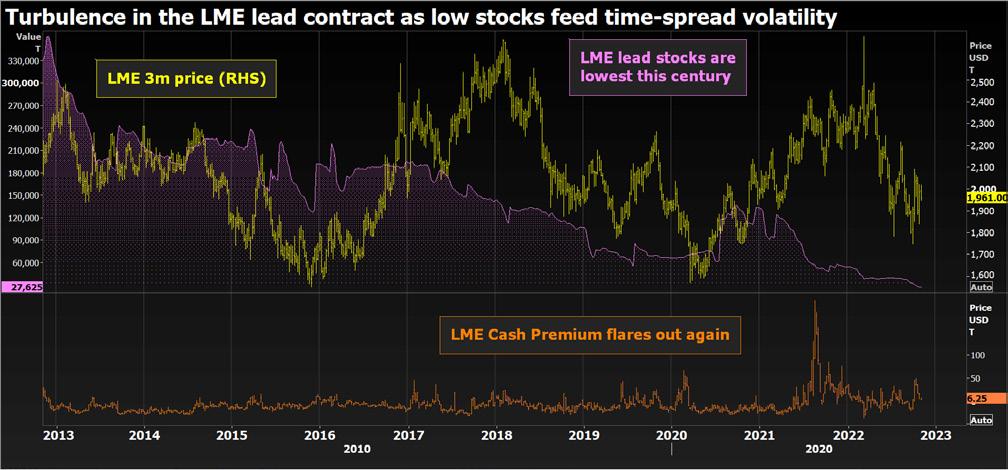
With backwardation, recycling plants may face reduced profit margins, or even a financial loss, as the cost of acquiring used batteries for recycling is higher than the expected future sales price for the recycled lead.
In a contango market, future LME lead prices are higher than near-term or spot prices and so it would appear that secondary lead recycling plants might benefit as the cost of acquiring used batteries is lower than the expected future prices.
The problem is that suppliers of used batteries, particularly scrap dealers, are often unwilling to sell used batteries at a low price in a contango market and hold on to the used batteries in anticipation that the price will rise.
Hedging strategies, including futures and options contracts, offer effective tools to mitigate market volatility risks, providing stability in costs and pricing, and safeguarding recycling plant feedstock and sustainability.
So, how does hedging provide price stability in backwardation and a contango markets?
In an ideal world without any LME price fluctuations the financial scenario would look something like this with an assumption that the lead price in August is $2,000 per tonne and does not change when the refined recycled lead is sold.
100 tonnes of used batteries (ULAB) with a lead content of 60% are bought at 50% of the LME lead price for $60,000.
August: LME Pb price is $2,000/tonne
Buy 100 tonne ULAB @ 50% LME = $60 k
Sell 60 tonne
Pb @ $2,000 = $120k
Purchase cost = $60k
Operating costs = $40k
Total = $100 k
Profit (margin) = $20k
• After recycling the ULAB 60 tonnes of refined lead is sold for $120,000.
• Purchase and operating costs amount to $100,000.
• Therefore, the profit or operating margin is $20,000.
In a backwardation market where the LME price has fallen from $2,000 per tonne in August to $1,700 per
tonne in September, the same ULAB purchase and refined lead sales scenario without hedging is very different.
August: LME Pb price is $2,000/tonne
Buy 100 tonne ULAB @ 50% LME = $60 k
Sell 60 tonne
Pb @ $1,700 = $102k
Purchase cost = $60k
Operating costs = $40k
Total = $100 k
Profit (margin) = $2k
• After recycling the ULAB, 60 tonne of refined lead is sold for $102,000.
• Purchase and operating costs are unchanged and amount to $100,000.
• Therefore, the profit or operating margin is only $2,000. But if the ULAB had been hedged when purchased:
• When the 100 tonne of ULAB are purchased at $2,000 per tonne – 60 tonne of refined lead is sold on the futures market – say for example September - at the prevailing price of $2,000 per tonne.
THE TERMINOLOGY
Spot price
The spot price is the current price in the marketplace which can be bought or sold for immediate delivery.
Future price
A price you can agree on buying or selling with delivery at a future date.
Backwardation
Spot prices for lead are higher than the future prices.
Cotango Spot prices for lead are lower than the future prices.
Futures option
One can choose whether you want to buy or not-buy (or sell or not-sell) at a set price on a certain date. You pay to buy the option to do this.
RISK MANAGEMENT: HEDGING www.batteriesinternational.com Batteries International • Spring 2024 • 75
Courtesy: Reuters
MINIMIZING WORKING CAPITAL AND BANK OVERDRAFTS
Minimizing and managing working capital is crucial for the efficient operation of a lead battery recycling plant and demands a holistic approach encompassing supply chain efficiency, contractual agreements, and strategic partnerships.
The interplay of these strategies not only ensures economic viability but also positions the plant for longterm success in the competitive recycling industry.
Continuous operation of any secondary lead plant is essential to its financial viability, so a constant supply of used batteries is vital, but a focus on a just-in-time feedstock inventory can reduce working capital by some hundreds of millions of dollars.
Every effort should be made to have a feedstock inventory of two weeks or less with scheduled used battery deliveries from suppliers set up to top up the inventory in a managed program and not on an ad hoc impromptu basis. Used battery suppliers traditionally demand payment on delivery, and payment should only be made on the day of delivery to minimize working capital.
Of course, the shorter the time between the used batteries arriving at the recycling plant and the sale of the recycled refined lead the lower will be the working capital burden.
But this is where a holistic approach is required because it is incumbent on the sales team to ensure that the sales contracts keep the refined recycled lead inventory to an absolute minimum.
Should the sales team fail to sell all the refined recycled lead under contract, subject to LME membership and sales criteria, it may be possible to sell any surplus production into an LME warehouse and at least maintain cashflow as well as reducing working capital.
It should be noted by recyclers that lead delivered to an LME warehouse must meet specified quality standards and the metal usually needs to be inspected to ensure it conforms to LME specifications, a procedure that results in a warrant if the metal meets the quality standards.
Once a warrant is issued, a sale to the LME can then proceed. However, such transactions while generating cashflow can also incur charges for storage and insurance.
If used batteries are sourced through a reverse logistics agreement with one or more lead battery manufacturing companies, it may be possible to enter into a tolling agreement, such that the recycled refined lead recovered from the used batteries is returned to the battery manufacturer in return for treatment charge payment for recycling the batteries.
The only working capital requirement is the treatment charge incurred to recycle the used batteries. It is essential that the treatment charge more than covers the costs associated with recycling the batteries and the invoicing and credit control department secure settlement in the shortest possible time, indeed even the same day the refined lead is delivered to the battery manufacturer.
Hedging strategies contribute to better risk management by removing the uncertainties associated with fluctuating metal prices, and offering improved financial budgeting — fiscal plans are based on the operating margin and not an unknown metal price
• The ULAB are recycled and 60 tonne of recycled refined lead is sold in September at $1,700 per tonne
• At the same time 60 tonnes of refined lead is purchased from the LME at $1,700 per tonne.
August: LME Pb price is $2,000/tonne
Buy 100 tonne ULAB @ 50% LME = $60k
Recycle the ULAB – 60 tonne of Refined Pb
Sept. - LME Pb price is $1,700/tonne
Sell 60 tonne of ULAB @ $1,700 = $102k
Loss on sale = $18k
August: Sept Futures Price $2,000
Sell 60 tonne Pb @ $2,000 = $120k
Buy 60 tonne Pb @ $1,700 = $102k
Profit on sale = $18k
• The loss on the sale of 60 tonne of refined recycled lead is $18,000.
• But there is a profit of $18,000 for the transactions in the futures market. So, collating the final financial analysis with hedging:
Final sales income with hedging Sale of 60 tonne of ULAB @ $1,700 = $102k Plus
Profit on the purchase and sale of hedged Pb = $18k
Total income = $120k
Less operating and purchase costs = $100k
Profit = $20k
• Combining the income from the recycled refined lead sale and the profit from the hedging operation gives a total income of $120,000.
• If operating and purchasing costs of $100,00 are deducted from the income of $120,00, then the profit or operating margin is $20,000 – The same as the ideal scenario.
So how does hedging work in a contango market where the LME price has risen from $2,000 per tonne in August to $2,300 per tonne in September?
• When the 100 tonne of ULAB are purchased at $2,000
RISK MANAGEMENT: HEDGING 76 • Batteries International • Spring 2024 www.batteriesinternational.com
A recycling business relies on a continuous flow of used batteries to recycle and generate revenue. Any interruption in the supply chain will inevitably create a cashflow problem, where operational expenses continue, but revenue generation is hampered, leading to financial strains
per tonne – 60 tonne of refined lead is sold on the futures market – say for example for September - at the prevailing price of $2,000 per tonne.
• The ULABs are recycled and 60 tonne of recycled refined lead is sold in September at $2,300 per tonne for $138,000. An additional profit of $18,000.
• At the same time 60 tonne of refined lead is purchased from the LME at $2,300 per tonne, an $18,000 trading loss on the futures trading market.
August: LME Pb price is $2,000/tonne
Buy 100 tonne ULAB @ 50% LME = $60 k
Recycle the ULAB – 60 tonne of Refined Pb
Sept. - LME Pb price is $2,300/tonne
Sell 60 tonne of ULAB @ $2,300 = $138k
Additional profit on sale = $18k
August: Sept Futures Price $2,000
Sell 60 tonne Pb @ $2,000 = $120 k
THE BASIC RULES OF ENGAGEMENT: INVOICING AND CREDIT CONTROL
Buy 60 tonne Pb @ $2,300 = $138 k
Loss on sale = -18k
So, collating the final financial analysis with in the contango market with hedging:
Final sales income with hedging
Sale of 60 tonne of ULAB @ $2,300 = $138k
Plus
Profit on the purchase and sale of hedged Pb = -$18k
Total income = $120k
Less operating and purchase costs = $100k
Profit (margin) = $20k
Combining the income from the recycled refined lead sale and the loss from the hedging operation gives a total income of $120,000.
If operating and purchasing costs of $100,00 are deducted from the income of $120,00, then the profit or operating margin is once again $20,000 — the same as the ideal scenario and the same as if there was a backwardation market.
Cotango security
Now it could be argued that in a contango market there is no need to hedge the lead content of the used batteries, but in the intervening period between buying the used batteries and selling the recycled refined lead, the market can easily change to a backwardation state, and what was once a profitable recycling scenario is now a loss making deal.

Whether it is the purchase of used batteries or the sale of refined lead, in the secondary lead world, where financial transactions involve substantial sums and operational efficiency is paramount, effective management of invoicing, payments, and credit control becomes the linchpin for financial wellbeing.
Ensure all invoices are not just issued on time, preferably on the day of delivery, but are also accurate, providing a meticulous breakdown of the refined lead or alloys delivered, including details of product quality and quantity, and the terms and payment procedure for settlement.
If possible, set up digital invoicing and payment systems with customers to enhance efficiency, reduce errors, and speed up settlements. In this context, it might be possible to offer prompt payment discounts to encourage clients to agree to a digital settlement process.
Before extending settlement terms or offering credit, conduct thorough credit checks on new clients and even existing customers. Assess their creditworthiness, financial stability, and payment history to minimize the risk of a default.
As soon as the credit report is available set an appropriate credit limit and timeline based on the client’s creditworthiness and the recycling business’s financial risk tolerance. It is important to stay vigilant. Regularly monitor clients’ payment behaviours and be proactive in reassessing credit limits if and when necessary. Swift action can pre-empt a financial meltdown.
Be firm with customers who are late making settlement payments and do not deliver more lead until all outstanding invoices have been paid in full.
RISK MANAGEMENT: HEDGING www.batteriesinternational.com Batteries International • Spring 2024 • 77
Hedging strategies, including futures and options contracts, offer effective tools to mitigate market volatility risks, providing stability in costs and pricing, and safeguarding recycling plant feedstock and sustainability
Hedging strategies contribute to better risk management by removing the uncertainties associated with fluctuating metal prices, and offering improved financial budgeting because fiscal plans are based on the operating margin and not an unknown metal price. Improved financial budgeting also leads to enhanced competitiveness in what is a dynamic metal recycling industry.
Hedging strategies can also be applied in a similar manner when a secondary lead operation invests in a new plant, or expensive equipment, especially when acquiring the equipment from an overseas supplier and final settlement is not in the native currency.
Once again, as with lead, currency hedging emerges as a crucial risk management tool. It protects against the uncertainties of exchange rate fluctuations, especially where delivery times are extended, ensures budgeted cost certainty, and contributes to the overall financial stability and success of any metal recycling project.
THE PRICE BENCHMARK, THE LME
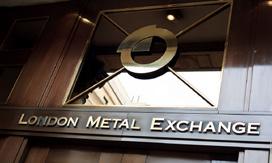
The London Metal Exchange is a futures and forwards exchange in London, with the world’s largest market in standardized forward contracts, futures contracts and options on base metals.
The company also allows for cash trading. It offers hedging, worldwide reference pricing, and the option of physical delivery to settle contracts.
Implementing robust currency hedging strategies is not merely a financial precaution, but a strategic necessity for the sustainable growth and competitiveness of secondary lead recycling plants operating in the global market.
The benefits to secondary lead operations of hedging refined lead and currencies are well documented, but as simple and convincing as the mathematics appears to be, hedging should be assigned to professional organizations that understand the LME rules and regulations for hedging metals on the futures market.

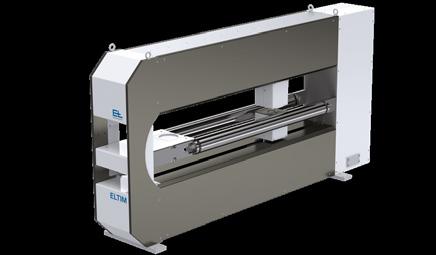
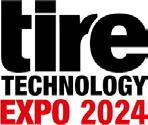

RISK MANAGEMENT: HEDGING 78 • Batteries International • Spring 2024 www.batteriesinternational.com
Basis weight measuring system Discover our solutions – WE KNOW BATTERY PRODUCTION. HOW TO INCREASE PRODUCTION QUALITY NO DANGER FROM RADIATION JOIN OUR EXPERTS AT Booth 8E20 | Hall 8 June 18 - 20, 2024 Stuttgart, Germany
Electrochemical impedance spectroscopy continues to offer further insights into the heart and performance of batteries, writes Isidor Buchmann, CEO and founder of Cadex Electronics.
EIS and Nyquist plotting analysis opens up inner battery dynamics
New technologies often lead to innovative blind spots, and this is happening with electrification in batteries.
Lithium-ion batteries, for example, are a winning chemistry to store electrical energy in many ways but there is fear of failure that often starts in a faulty cell that propagates and engulfs the battery in fire. Such incidents are becoming well known with e-bike batteries and other devices.
Cadex is developing a technology that reads the electrochemical evidence of a battery with a frequency scan and displays the results in a Nyquist plot.
Figure 1 demonstrates Nyquist plots taken from 100 high-quality 8650 Li-ion cells with Spectro Explorer.
The Spectro Explorer services Li-ion and lead acid batteries from 3V to 48V with capacities of up to 300Ah. The test is minimally-invasive with a frequency scan from 2,000Hz down to 0.1Hz that takes about 30 seconds; longer for large batteries.
Applications for the Explorer are quality control in manufacturing, examining uniformity of incoming batteries, and battery validation before shipment. Best results are achieved with preparations such as a prior full charge, followed by a short rest.
Dormant lead acid batteries develop sulfation, a deficiency that can be removed with battery exercise if the sulfation is soft. Hard sulfation that occurs during long dormancy at low charge can be permanent.
Primary lithium batteries also develop passivation while in storage. The passivation layer is removable with a brief discharge. These are added services that a Nyquist scan can discover.
What is a Nyquist plot?
A Nyquist plot consists of a resistive reading (Real Z) that is positioned on the horizontal axis, and a reactive analysis placed on the vertical axis. The resulting signature reflecting battery characteristics is divided into migration at high frequency on the left of the scale; charge transfer in mid-range; and diffusion at low frequencies on the right.
Figure 2 illustrates a Nyquist plot serving as “golden sample” with adjustable pass/fail envelopes to set
Dormant lead acid batteries develop sulfation, a deficiency that can be removed with battery exercise if the sulfation is soft. Hard sulfation that occurs during long dormancy at low charge can be permanent

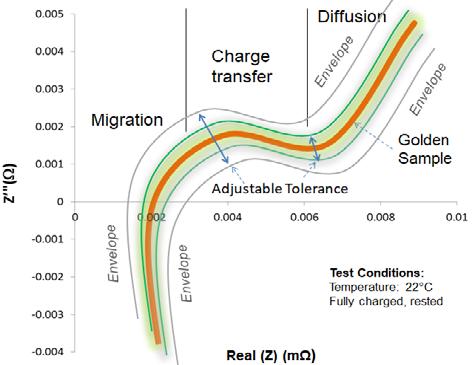
tolerances
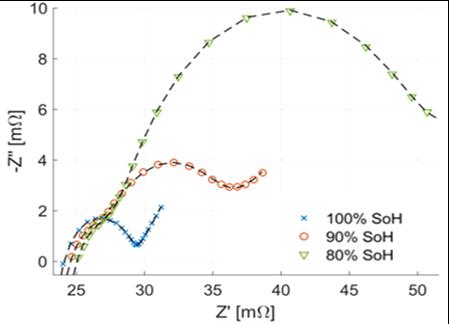
BATTERY TESTING: EIS www.batteriesinternational.com Batteries International • Spring 2024 • 79
Figure 1: Nyquist plots of 100 18650 cells for quality control. The test was done in a controlled environment
Figure 2: Nyquist serves as golden sample with acceptance
Figure 3: Nyquist showing Li-ion with diverse capacities
Lead acid batteries stored for six months or longer develop sulfation; a dormancy effect that reduces performance but is reversible by exercise if done in time
acceptance levels for quality control in manufacturing and performance check before deployment.
Figures 3 compares Nyquist plots with different battery performances, Figure 4 overlays a Nyquist plot of a good battery with one of low capacity and Figure 5 illustrates a battery with dendrite growth. Figure 6 compares a Nyquist signature of aged lead acid batteries with sulfated packs. Unless otherwise noted all readings were taken at the Cadex labs in Canada and Germany.
PUTTING IT ALL TOGETHER
Testing batteries by EIS is not new, but scientists predict that future battery diagnostics rests in EIS analysis. Evaluation by Nyquist using the Spectro Explorer has the potential of becoming a household name, led by versatility, ease of use and low cost. Using these technologies will reduce innovative blind spots to maintain safety as the world electrifies with batteries.
Typical EIS applications include:
• Research labs: checks cathode and anode materials with additives.
• Manufacturing: evaluates consistency between battery batches.
Lead acid batteries stored for six months or longer develop sulfation; a dormancy effect that reduces perfor mance but is reversible by exercise if done in time.
Figure 7 shows the Nyquist plots of a lead acid battery that had a low charge transfer with a capacity read ing of 75% when first serviced. After exercise with a charge/discharge cycle, charge acceptance improved and the capacity increased to 92%. Other lead acid

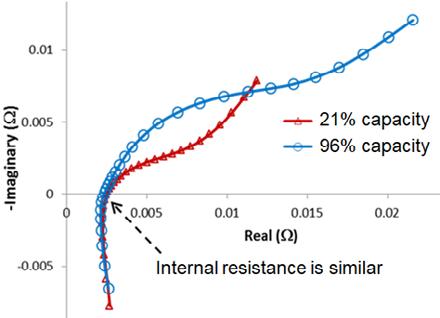
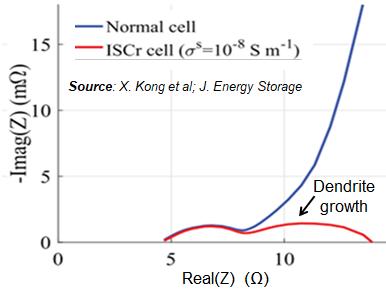
• Quality control: verifies incoming batteries and warranty claims.
• Environmental: Tests battery aging under extreme temperatures.
• Stress test: observes capacity-loss under abusive load conditions.
• Safety: detects dendrites and lithium plating in an integrity check
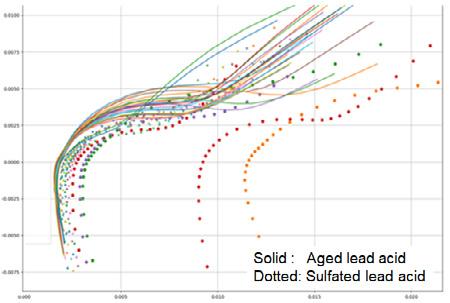
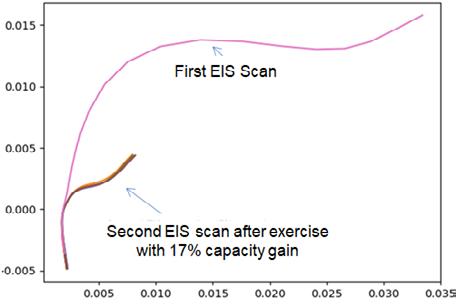
BATTERY TESTING: EIS 80 • Batteries International • Spring 2024 www.batteriesinternational.com
Figure 4: Li-ion in red has an anomaly
Figure 5: Cell in red has dendrite
Figure 6: Nyquist plots of sulfated and aged lead acid
Figure 7: Exercise improved capacity from 75% to 92%
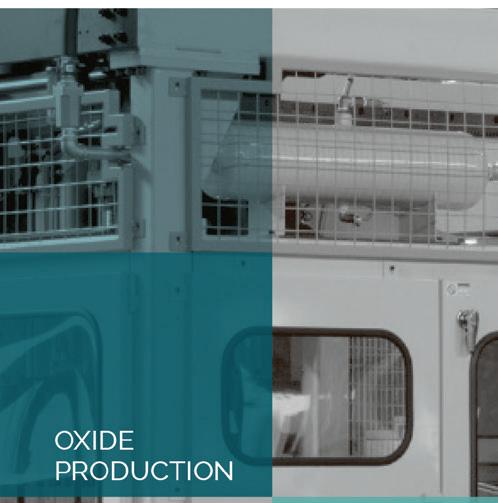


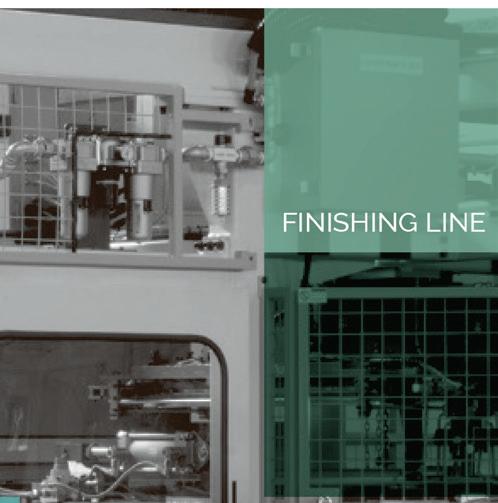
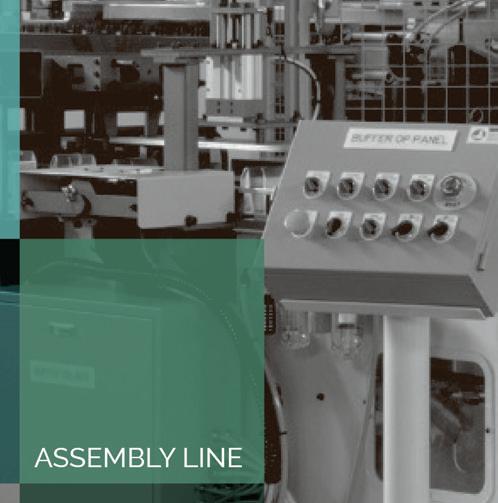


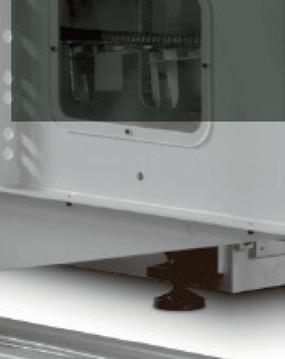

LOOKING FOR NEW EQUIPMENT? WE SPECIALISE IN HVIDSVAERMERVEJ 135 · DK-2610 ROEDOVRE · DENMARK · TEL +45 4453 4546 · E-MAIL:ACCURATE@ACCURATE.DK WWW.ACCURATE.DK MANUFACTURING We manufacture Machinery and Parts TECHNICAL TRADING Contracts, Logistics and Customerization CONSULTING We love to help with our expertise Supplier of first class equipment and services to the Lead Acid Battery Industry since 1950
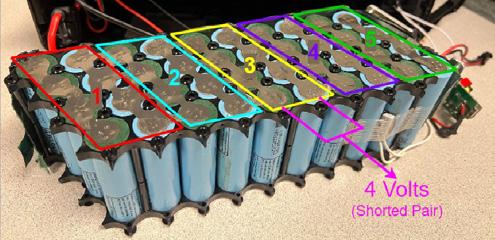
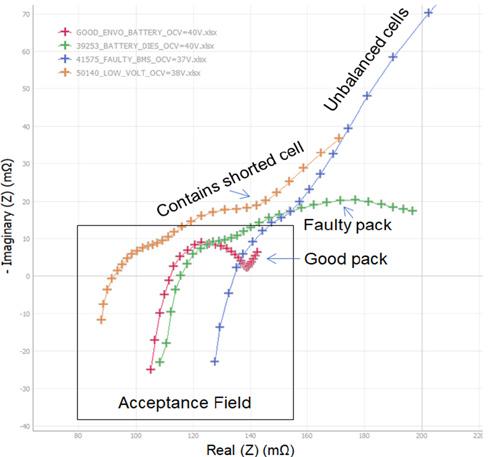
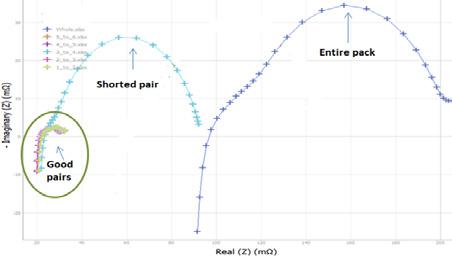
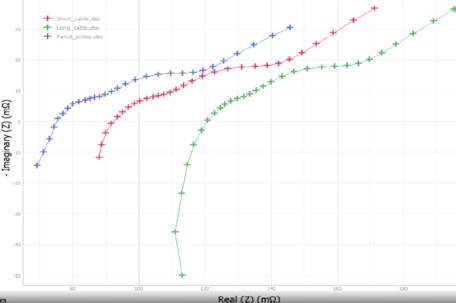
batteries tested with various dormancy effects had similar improvements. More studies are needed in how the Nyquist can identify sulfation that lead to restoration
Testing E-bike batteries
E-bike batteries are failing and in some cases catching fire. However, handled correctly, Li-ion is safe but the chemistry is less forgiving than lead acid and nickel-based chemistries.
We now scan batteries with the Explorer in an entire pack, as well as in parallel pairs. Figure 8 shows an open e-bike battery; Figures 9, 10 and 11 show the test results.
With acquired knowledge, a Nyquist plot can easily be deciphered by technical staff. The task is simplified by comparing a faulty pack with a good one, knows as golden sample.
As Figure 9 illustrates, a normal pack has a small footprint that is contained in the user-adjustable Acceptance Field, while a faulty battery steps outside set limits. The shapes of the “cat tails” may one day lead to identifying the nature of defect
Figure 10 shows an entire pack with one cell shorted. The graph also does a comparison with a parallel pair in which all cells are good as shown in the small oval. Adding one bad apple changes the order.
Protection circuit and series connections add non-reactive resistance that shift the Nyquist plot of the pack to the right.
Mixing non-reactive resistance with the reactive component of a battery is further exemplified in Figure 11. Here the protection circuit and long cables move the Nyquist plot to the right while retaining the signature of the Nyquist plot. The shift reflects the pure resistive part of the battery that will also assist in troubleshooting.
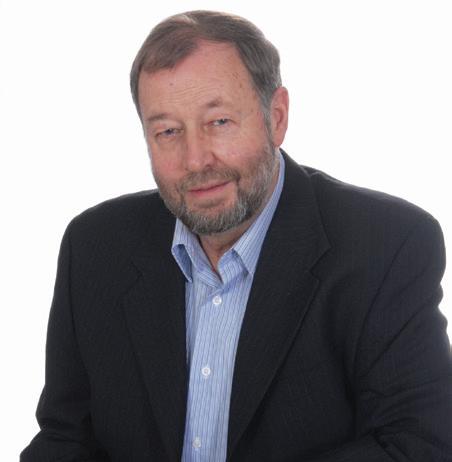
Isidor Buchmann is the founder and CEO of Cadex Electronics. For three decades, Buchmann has studied the behavior of rechargeable batteries in practical, everyday applications, has written award-winning articles including the best-selling book Batteries in a Portable World, now in its fourth edition.
BATTERY TESTING: EIS 82 • Batteries International • Spring 2024 www.batteriesinternational.com
Figure 9
Figure 10
Figure 11
Figure 8: EIS test on an e-bike battery. The 40V pack has 4 cells in parallel and 10 pairs in series
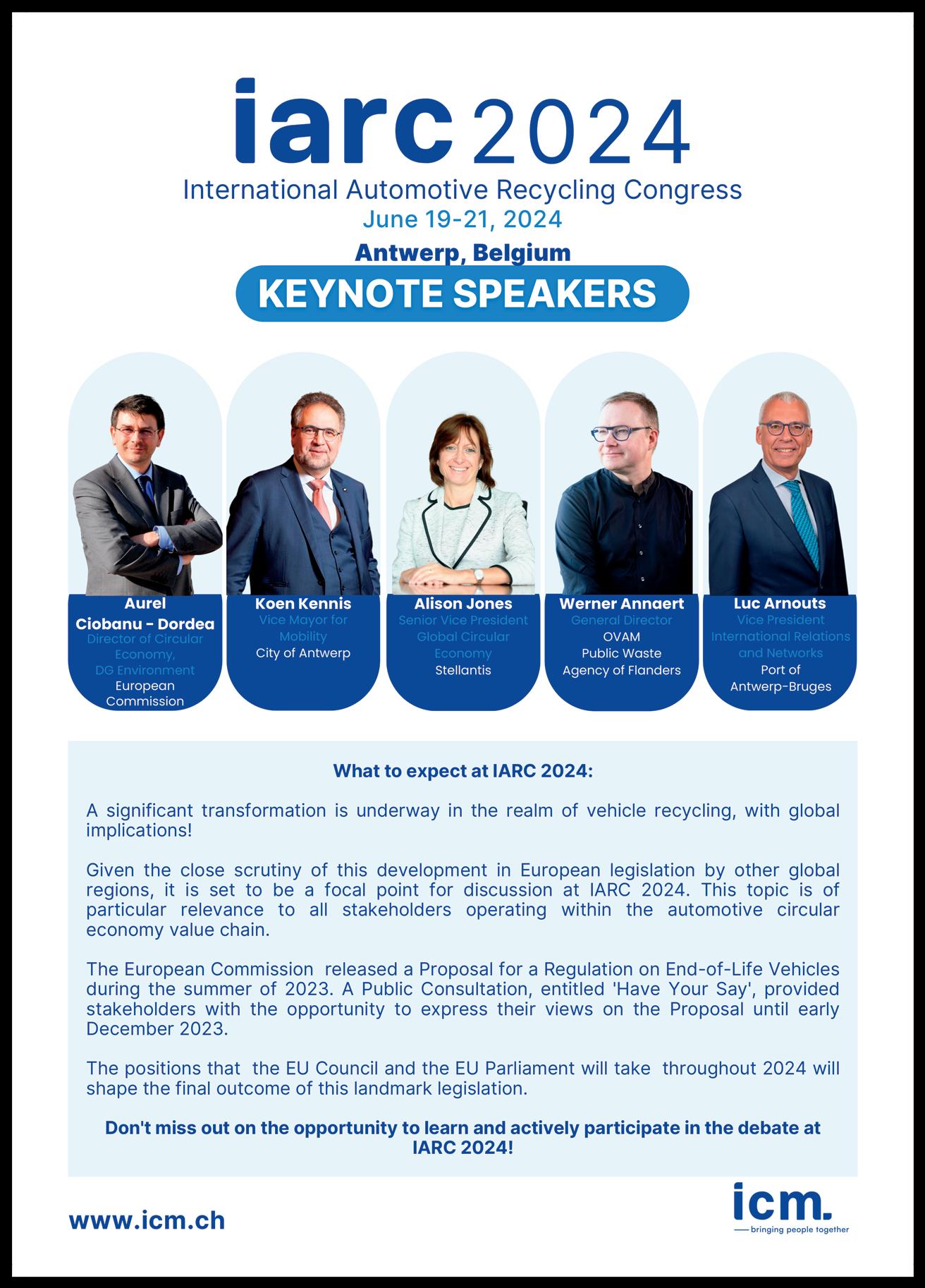
BTF China
April 1 – 3
Shanghai, China
BTF China 2024, The 13th Shanghai International New Energy Lithium Battery Technology Fair will take place from April 1 – 3, 2024 at Shanghai New International Expo Centre and is expected to attract more than 800 exhibitors and 65,000 incoming buyers to the fair.
Topics to cover:
Power batteries • Energy storage batteries • Raw materials • Battery manufacturing equipment • Battery testing • Battery recycling, etc
Contact
Qiyang Exhibition Service (Shanghai) Co., Ltd
www.btfchina.com.cn/en/
International Advanced Battery Power Conference
April 9 – 11
Munster, Germany
The Advanced Battery Power Conference offers an excellent platform for companies, research institutes, universities and individuals to present their work and results in the field of battery technology to a broad specialist audience.
Interested parties who are not be able to attend in Münster will have the opportunity to participate online via the Digital Campus hdt+.
Contact Haus Der Technik — HDT E: hdt@hdt.de www.hdt.de
Energy Tech Summit
April 10 – 11
Bilbao, Spain
Join Europe’s premier climate tech event, now with a sharper focus on enabling resources for the clean energy transition. Recognized at the #1 industry conference, Energy Tech Summit connects impactful investors, disruptors, and government leaders.
In 2024, we’re bringing the summit Bilbao, the heart of innovation. Get ready for a dynamic new format designed to inspire, connect and amplify your impact. This is your chance to be part of the solution, explore markets and leave with business ideas that make a difference
in the fight against climate change. Join us for an unforgettable event and be part of a movement pushing boundaries in the enrgy industry.
Contact Future Events, UAB
E: info@energytechsummit.com www.energytechsummit.com
Intersolar & ees Middle East
April 16 – 18
Dubai, United Arab Emirates
Take your chance to join the most powerful platform in the MENA region Middle East Energy (MEE), Intersolar, and ees, the leading energy exhibitions are joining hands to co-deliver an outstanding renewables and energy storage event at Middle East Energy.
Renewables and energy storage at MEE is the largest gathering of solar and renewable energy industry professionals in the Middle East & Africa, offering the most effective trade focused platform to international manufacturers and distributors looking to meet regional buyers.
Contact
Solar Promotion International
E: stunz@solarpromotion.com
www.intersolar.ae/home

World Future Energy Summit
April 16 – 18
Abu Dhabi, UAE
WFES (World Future Energy Summit) is a global industry platform connecting business and innovation in energy, clean technology and efficiency for a sustainable future. WFES Expo hosts over 850 exhibiting companies from more than 40 countries; The Future Summit; the unique WFES Forums, covering everything from disruptive technologies to future cities; a set of ground-breaking WFES Initiatives; and WFES Hosted Events, where individual growth markets come under the spotlight.
Contact
RX Global
E: worldfuturenergysummit@rxglobal.com
www.worldfutureenergysummit.com

FORTHCOMING EVENTS 84 • Batteries International • Spring 2024 www.batteriesinternational.com
Dubai
Abu Dhabi
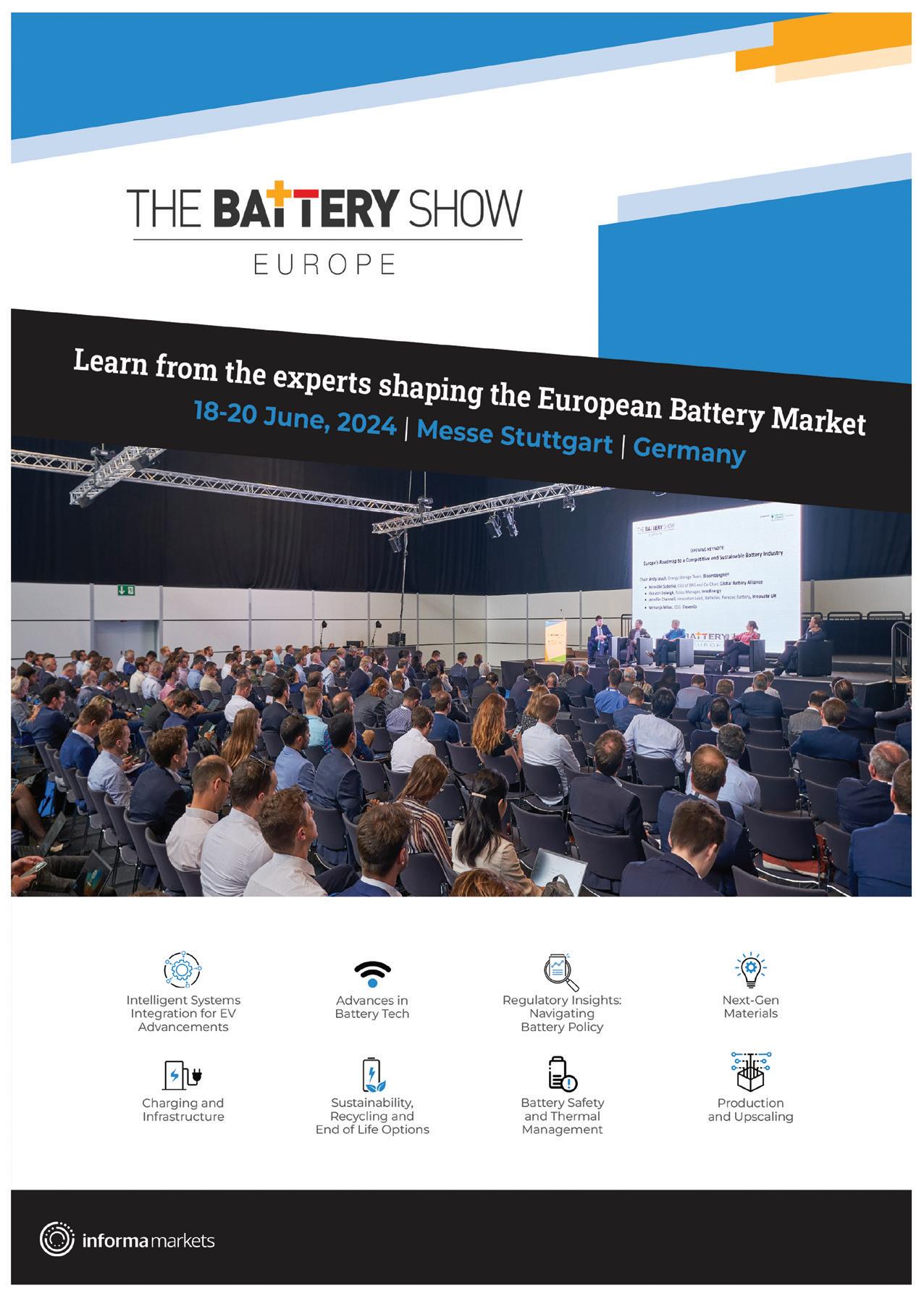


BCI 2024 Convention and Power Mart Expo
April 21 – 24
Fort Lauderdale, Florida, USA
BCI brings together the leading battery manufacturers and recyclers in North America and around the world, and establishes technical standards for battery manufacturing and actively promotes workable environmental, health and safety standards for the industry.
Each year hundreds of lead battery industry executives gather at the industry’s premier event, the BCI Convention + Power Mart Expo, for three days of networking and exposure to valuable industry knowledge. Past convention presentations have included global regulatory and legislative updates, lead markets analysis, the BCI Failure Mode Study, and industrial and transportation batteries outlooks.
The 2024 event will be an electrifying experience like no other – with stimulation speakers, dynamic panel discussions, exciting industry forecasts and numerous networking opportunities – culminating in a grand Centennial Celebration.
Contact Battery Council International — BCI E: info@batterycouncil.org www.convention.batterycouncil.org
Battery Tech Expo
April 25
Silverstone, UK
The Battery industry is on the cusp of a power revolution with big technology companies investing heavily in the next generation of battery development and energy storage.
The Battery Tech Expo will provide a unique opportunity to showcase the latest products, technologies and services covering the Battery Management Systems, EV Battery, Battery Storage, Battery Development/ Discovery, Commercial and Mobile Power Device sectors.
Contact
10fourmedia
David Reeks
E: david.reeks@10fourmedia.co.uk www.batterytechexpo.co.uk
China International Battery Fair
April 27 – 29
ChongQing, China
China International Battery Fair (CIBF) is an international meeting and one of the biggest exhibitions in terms of activity in the battery industry, which is sponsored by China Industrial Association of Power Sources.
It includes activities such as exhibition, technical seminar, information meeting, trade fair and is considered an important bridge and platform for the Chinese battery industry chain enterprises to connect with the global industry.
Contact
China Industrial Association of Power Sources — CIAPS www.en.cibf.org.cn
3rd V2G Business, Policy and Technology Forum
April 30 – May 2
San Diego, CA. USA
The 3rd edition of the V2G Business, Policy & Technology Forum 2024 in San Diego brings together top industry players, working groups, utility professionals and others focused on the development and implementation of vehicle-to-grid in the US.
Building on the success of the two previous editions held in 2023, the Forum offers a neutral venue in which different V2G stakeholders can come together to work on accelerating V2G standardization and adoption in North America.
The goal is to examine obstacles and challenges to effectively achieving the potential of V2G, and to identify appropriate solutions and implementation success strategies for grid operators and other stakeholders across market verticals.
Contact
Smart Grid Observer
Daniel Coran, Editor
E: dcoran@smartgridobserver.com
www.v2gforum.com
RE Battery
May 7 - 8
Bologna, Italy
RE-BATTERY 2024 is Southern Europe’s largest international trade fair for battery producers, recycling companies, raw material suppliers and the entire battery supply chain: on collecting, sorting, processing and reusing batteries, electric vehicles, e-mobility systems and e-waste.
Main topics discussed will include recycling technologies, materials recovery solutions, green electronics, sustainable materials, non-toxic substitutes and end-of-life / reuse strategies, as well as regulatory and business models to help reduce the environmental impact.
RE-BATTERY 2024 will focus on lithium-ion batteries from e-mobility transportation, stationary applications, electric vehicles and mobile and charging products, but also lead-acid batteries and e-waste from electronics.
Contact
A151 srl
E: events@e-tech.show
www.re-battery.show
FORTHCOMING EVENTS 86 • Batteries International • Spring 2024 www.batteriesinternational.com
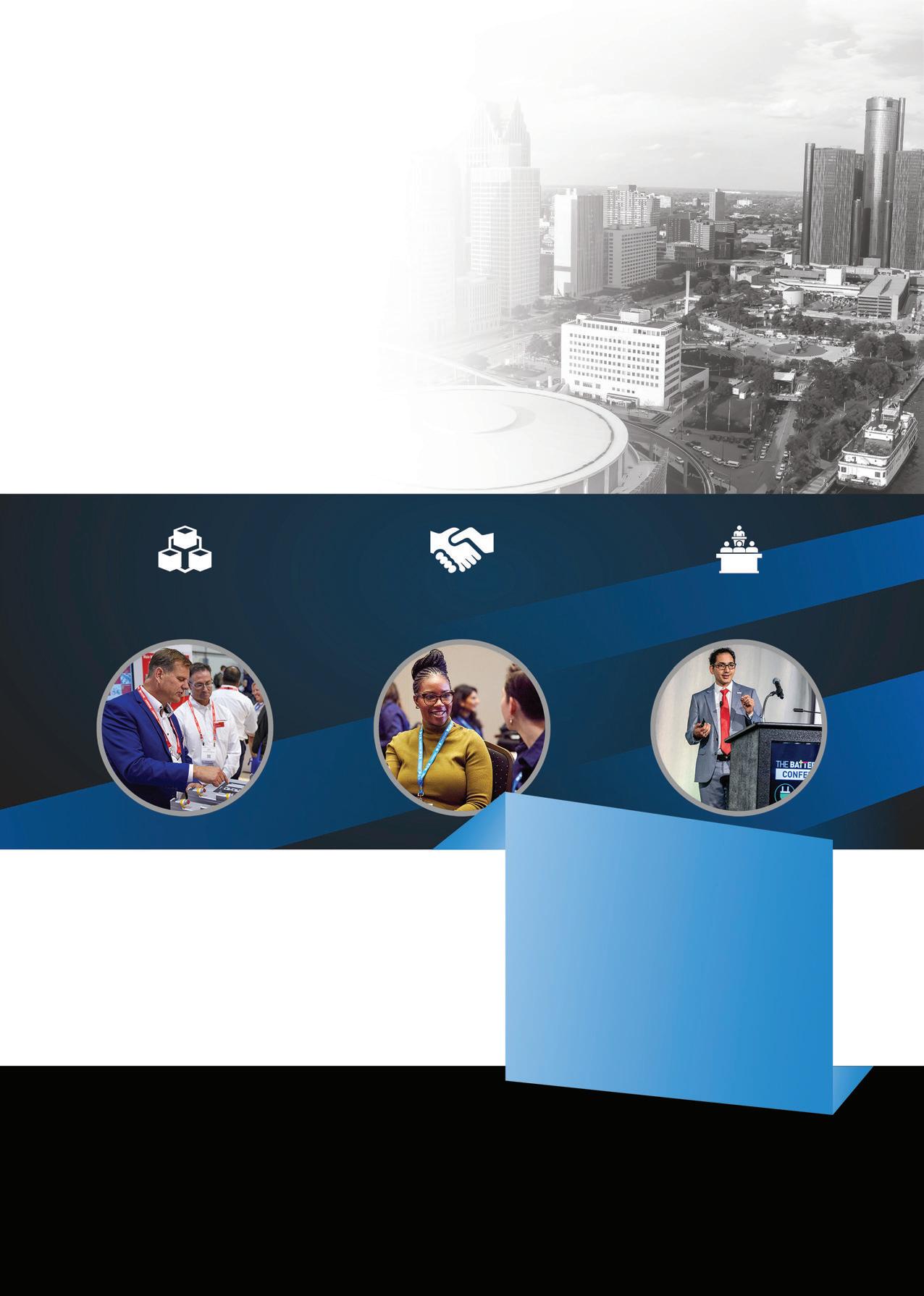
NORTH AMERICA’S LARGEST ADVANCED BATTERY EVENT Register your inquiry to attend at: register.thebatteryshow.com/batteriesinternational Huntington Place SOURCING NETWORKING EDUCATION October 7-10, 2024 Workshops, Conference & Expo IS MOVING TO DOWNTOWN SAVE THE DATE DETROIT! NORTH AMERICA 2 0 24 2024 • EXPANDED EXPO FLOOR • MORE EXHIBITORS • EXPERTLY CURATED FIVE-TRACK CONFERENCE • IN THE HEART OF DOWNTOWN DETROIT 1308614431_BAT_NA24

EV Charging Infrastructure Conference and Exhibition
May 13 - 14
Long Beach, California, USA
As the world is pacing through the e-mobility sector, the importance of an accessible segment of Electric Vehicle Charging Infrastructure is enabling a robust environment for EVs.
The recognition is getting bigger than ever. It’s the latest revolution in mobility and the charging infrastructure can be known as the backbone that is leading through this transformative revolution.
In order to take your business further, you can rely on our influential voices and key players from the EV industry, that will take you to the depth of this stream.
The conference will provide an exquisite opportunity for EV enthusiasts to behold all the latest and greatest the EV industry has to offer. From electric scooters to electric bikes to electric cars and buses, everything will be on a display to give you the best and niche experience in the EV spectrum.
Contact
MetaTech
E: info@metatechevents.com
www.evcharginginfrastructureconference.com
Advanced Automotive Battery Conference — AABC Europe
May 13 – 16
Strausbourg, France
Take part in this game-changing event where battery technologists from leading automotive OEMs and their key suppliers explore development trends and breakthrough technologies shaping the future of vehicle electrification.
As more European nations and international automotive OEMs invest in their commitment to vehicle electrification and eMobility, the 2024 AABC Europe event propels that momentum forward, presenting unparalleled coverage of the research and development that helps drive outcomes and supports the next generation of electric vehicle batteries.
Contact
Dave Mello
Cambridge Enertech
E: dmello@cambridgeinnovationinstitute.com www.advancedautobat.com/europe
Battcon
May 14 – 17
Miami, Florida, USA
The Consortium for Battery Innovation has been appointed to manage the prestigious Battcon energy storage conference in the United States.
Battcon is an annual stationary storage battery conference showcasing developments in all battery chemistries which has been held in Florida for more than 25 years.
The event, which attracts more than 400 delegates plus exhibitors, acts as a professional development and networking opportunity for the design, selection, and application of stationary, utility and energy storage battery systems.
Contact
Consortium for Battery Innovation
E: battcon@batteryinnovation.org www.battcon.com
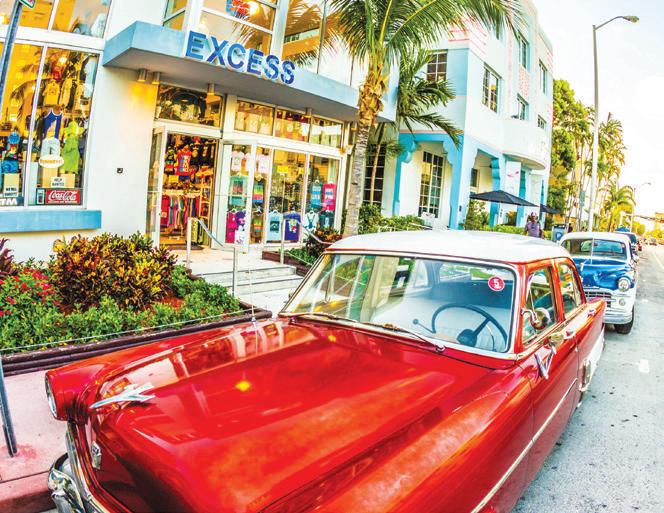
FORTHCOMING EVENTS 88 • Batteries International • Spring 2024 www.batteriesinternational.com
Long Beach, California
Miami, Florida
16-19 September
Milan, Italy 2024


Registration now open
Early bird rates available until 22 May 2024.
ELBC the Global Lead Battery Technical Conference of 2024
1000+ attendees
50+ expert presentations
120+ exhibitors

Join us in Milan, Italy, Monday 16 - Thursday 19 September 2024 for the latest in lead battery research, technical innovation and market insight.
MONDAY 16 - THURSDAY 19 SEPTEMBER 2024
VISIT WWW.ELBCEXPO.ORG VISIT WWW.ELBCEXPO.ORG
co-organised by GOLD CONFERENCE SPONSOR
Battery Cells and Systems Expo and Conference
May 15 – 16
Birmingham, UK
Battery Cells & Systems Expo is a free to attend exhibition and conference showcasing international manufacturers, users and the entire supply chain working to increase battery performance, cost and safety.
The show will bring together automotive OEM’s, electric utilities, battery cell manufacturers, system manufacturers and integrators along with the entire manufacturing supply chain.
Co-located with Vehicle Electrification Expo, the show will benefit from the rapid growth in the manufacturing of electric and hybrid vehicles in the UK along with the significant investments being made in domestic battery manufacture and research.
Featuring a global list of exhibitors and speakers, the entire world of battery manufacturing and integration will gather in the heart of UK manufacturing, Birmingham.
Contact Lana Mercer, Event Partners E: lana.mercer@event-partners.com www.batterysystemsexpo.com
Future Energy Asia
May 15 – 17
Bangkok, Thailand
Future Energy Asia is the region’s leading energy transition event, providing a business platform that brings together Asia’s natural gas, LNG, renewable and power generation industries to identify solutions and strategies to foster a secure, affordable and low-carbon energy mix for the continent.
Contact
DMG Events & Ministry of Energy www.futureenergyasia.com
Automotive Europe 2024
May 22 – 23
München, Germany
Automotive Europe 2024 will address the biggest disruptions in the industry across two stages: Automotive Tech and Electrification. Where there is disruption, there is opportunity. Through panel discussions, interactive workshops, and roundtable discussions, this event will lay out

the automotive agenda in Europe for the years to come through sharing of knowledge and collaboration.
Contact Reuters Events www.events.reutersevents.com/ automotive/automotive-europe
EUROBAT Forum
June 4 – 5
Brussels, Belgium
The EUROBAT Forum is the annual event of the association of European automotive and industrial battery producers, bringing together more than 100 key European automotive and industry stakeholders, including senior company executives, policy-makers, association and NGO representatives and more.
In 2024, the two-day event will take place on June 4 and 5 in Madrid at the Hotel Melia Princesa.
Contact Gert Meylemans, General Manager E: gmeylemans@eurobat.org www.eurobat.org
Battery and Critical Metals Recycling Conference
June 17 – 18
Atlanta, Georgia, USA
Immerse yourself in the battery and critical metals conference agenda, which is brimming with sessions designed to provide you with valuable insights, innovative concepts, and actionable strategies that can be directly applied to your operations.
Contact
GIE Media & Recycling Today Events
E: conference@gie.net
www.batteryrecyclingconference.com
The Battery Show Europe
June 18 – 20
Stuttgart, Germany
The Battery Show Europe provides attendees the chance to explore the latest products and solutions at the largest trade fair in Europe. The only place to find all your supply chain contacts in one place — from raw materials to battery recycling.
Join Peers at the Leading Meeting Place for the Advanced Battery and H/EV Technology Community and meet manufacturers, suppliers, engineers, thought leaders and decision-makers for a conference and trade fair focused on the latest developments in the advanced battery and automotive industries.
Contact
Informa Markets
E: thebatteryshowcs@informa.com
www.thebatteryshow.eu
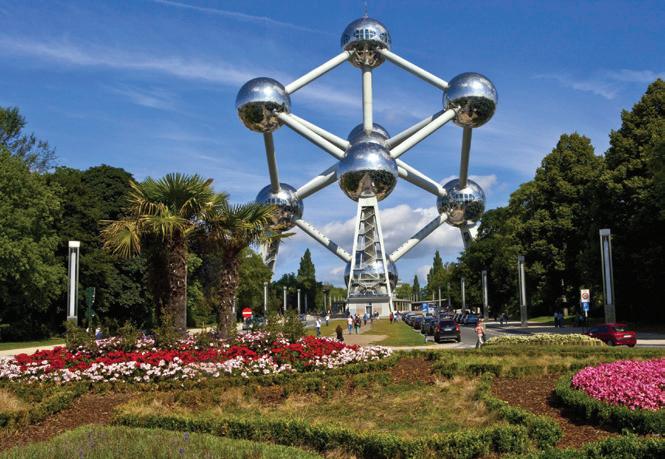
FORTHCOMING EVENTS 90 • Batteries International • Spring 2024 www.batteriesinternational.com
Munich, Germany
Brussels, Belgium
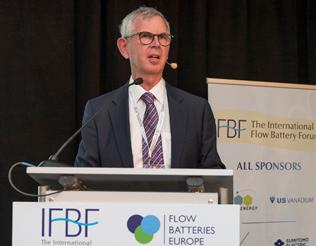
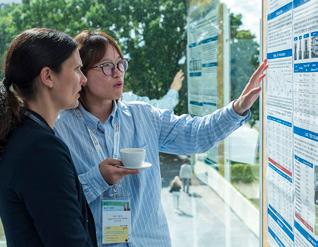


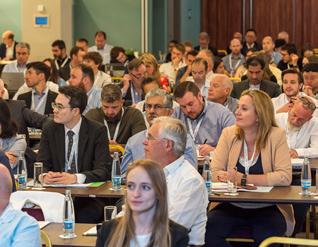
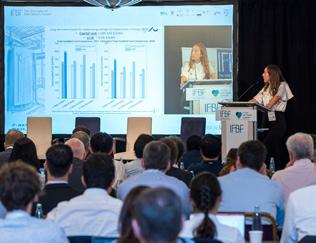


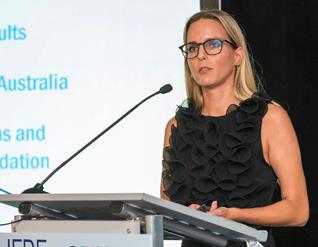


International Automotive Recycling Congress — IARC
June 19 – 21
Antwerp, Belgium
Calling all automotive recycling industry specialists! IARC 2024 gives you the unique opportunity to hear and exchange with industry leaders and pioneers in a privileged business environment.
IARC is the international platform for discussing the latest developments and challenges in circular economy and automotive recycling.
We bring together up to 300 decision-makers from the automotive and recycling sectors –car manufacturers, metal suppliers, traders, recyclers, shredder operators, and policy-makers.
Contact
ICM AG
E: info@icm.ch
www.events.icm.ch/event
SAVE THE DATE
ees Europe
June 19 – 21
Munich, Germany
Discover future-ready solutions for renewable energy storage and advanced battery technology at ees Europe! Europe’s largest, most international and most visited exhibition for batteries and energy storage systems is the industry hotspot for suppliers, manufacturers, distributors, and users of stationary electrical energy storage solutions as well as battery systems.
In 2024, more than 450 suppliers of products for energy storage technology and systems will be present at ees Europe and the parallel exhibitions of The smarter E Europe taking place in Munich. The exhibition will be accompanied by a two-day energy storage conference where leading experts delve into current questions of this industry.
Contact Solar Promotion GmbH
E: thesmartere@fwtm.de www.ees-europe.com/home
International Flow Battery Forum — IFBF
June 25 – 27
Glasgow, Scotland
In June 2024 the IFBF will hold its thirteenth in-person conference in Scotland, supported by Invinity Energy Systems and Flow Batteries Europe.
Over three days the conference will feature talks, panel sessions, open discussions, networking breaks, a poster session, conference dinner and a local site visit. We will discuss the latest innovations, policy updates and market challenges for the development of the flow battery sector.
Business leaders, policy makers, developers and researchers will share information and forecasts around the thriving world of energy storage and the important role of flow batteries.
Contact Swanbarton
E: info@flowbatteryforum.com www.flowbatteryforum.com
Battery Recycling Conference and Expo
June 26 – 27
Messe Frankfurt, Germany
Battery Recycling Conference & Expo 2024 is the must-attend event for battery producers, recycling companies, critical raw material suppliers, and the entire battery supply chain to come together on a single platform.
Discover the latest innovations and solutions to create a circular economy for used batteries and help create sustainable supply chains for the future.
Contact Transglobal Events
E: info@trans-worldevents.com
www.batteryrecycling-expo.com
5th EV Charging Infrastructure Summit North America
July 15 – 17
Chicago, USA
Organized by the Smart Grid Observer, the Summit convenes top industry experts and utility professionals to examine how EV adoption rates will impact the network, and what investments are needed to ensure grid stability and benefit.
Case studies of current utility programs and deployment will be discusses with an eye toward refin-
ing strategies, identifying technologies, and implementing business models that will ensure widespread EV adoption is optimised for all parties involved.
Contact
Smart Grid Observer
Daniel Coran, Editor
E: dcoran@smartgridobserver.com
www.smartgridobserver.com/EV-SummitChicago/
Plugvolt Battery Seminar
July 16 – 18
San Jose, California, USA
Conference fostering joint development efforts to advance energy storage solutions
Key Event Highlights:
• Entire day of in-depth technical tutorials on solid-state batteries, nextgen anodes and cathodes, battery diagnostics, failure modes and best design practices for cell engineering, securing North American supply chain for gigafactories, etc.
• Latest industry updates on use of energy storage systems in automotive applications by subject matter experts from major OEMs, Tier 1 system developers and battery makers
• Latest industry updates on use of energy storage systems in large-scale stationary grid/utility storage applications by subject matter experts from major Utility companies, Tier 1 system developers and providers
• Poster presentations
• Complimentary meals and refreshments
• Plenty of industry networking opportunities
• An evening cocktails reception hosted by Exponent
In an era of radically-accelerating change, Exponent is the only premium engineering and scientific consulting firm with the depth and breadth of expertise to solve your most profoundly unique, unprecedented, and urgent challenges.
Event attendees will get an exclusive opportunity to ask questions to their resident battery experts, and enjoy some light appetizers and beverages while networking with industry peers.
Contact
Plugvolt www.batteryseminars.com
FORTHCOMING EVENTS 92 • Batteries International • Spring 2024 www.batteriesinternational.com


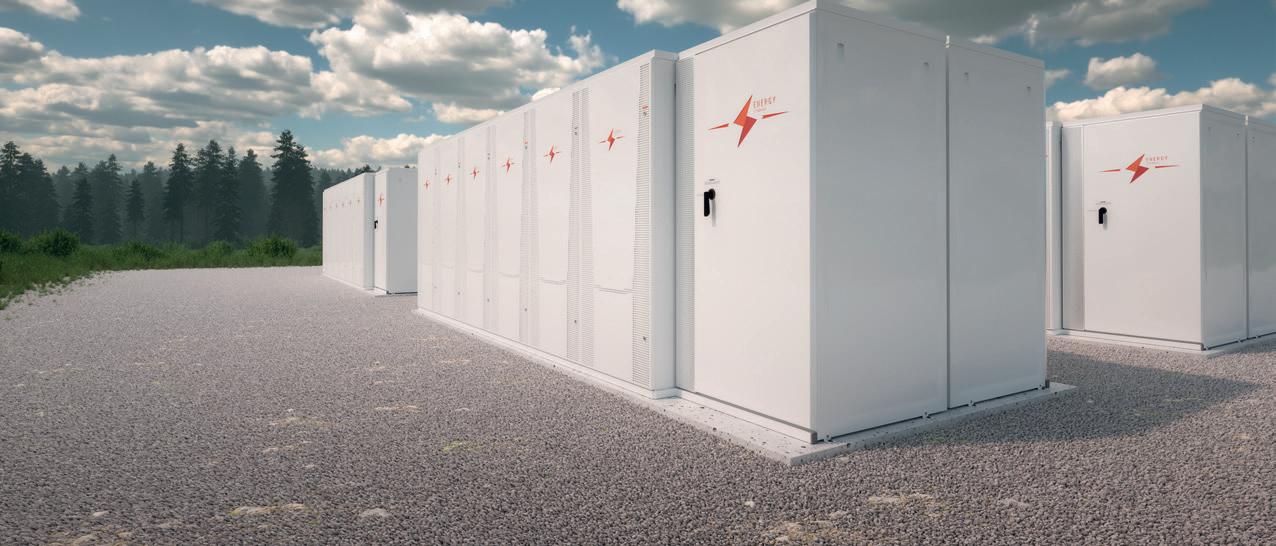


ENERGY STORAGE EVENTS


The Leading Exhibition Series for Batteries and Energy Storage Systems


■ APRIL 16–18, 2024, DUBAI, UAE www.intersolar.ae
■ JUNE 19–21, 2024, MUNICH, GERMANY www.ees-europe.com
■ AUGUST 27–29, 2024, SÃO PAULO, BRAZIL www.ees-southamerica.com
■ SEPTEMBER 3–5, 2024, MEXICO CITY, MEXICO www.intersolar.mx
■ FEBRUARY 2025, GANDHINAGAR, INDIA www.ees-india.in






—
www.ees-events.com Follow us
CNIBF Battery Exhibition
August 2 – 4
Shanghai, China
In order to promote the innovative development of the power battery industry and the exchange and cooperation between the power battery industry chain, the 16th Shanghai International Battery Industry Exhibition in 2024 will be held in Shanghai New International Expo Center on August 2 – 4, 2024 to build a platform for the cooperation and exchange of the whole industrial chain of north-south power batteries. The show area is expected to reach 30,000 square meters, while more than 600 exhibitors from the whole industry chain will show their latest products and technology at the scene.
Furthermore, over 100 visitor groups and 35,000 people are going to visit the site with a purpose to purchase or communicate, making sense to promoting industrial innovation and development.
Contact Zhenwei Exhibition Group www.cnibf.net
Oslo Battery Days Conference
August 19 – 21
Oslo, Norway
The 6th OBD Battery Conference will meet to discuss and provide a platform for technological innovations and business opportunities with the latest updates in that field from Norway and abroad.
Let’s meet and discuss INDUSTRY TRENDS & BEST PRACTICES, from the battery production to its recycling !


For the 2024 event we will offer a spectacular Monday-evening on at the beautiful Akershus Fortress and for the second evening we plan for a Fjordcruise on the fully electric vessel “ Legacy of the Fjords ”.
Contact
Schive AS and Shmuel De-Leon Energy Ltd
www.oslobatterydays.com/
ees South America
August 27 – 29
São Paulo, Brazil
With three parallel energy exhibitions, The smarter E South America is LATAM’s innovation hub for the new energy world. It takes a comprehensive approach to the topics of the energy system transformation by presenting cross-sector energy solutions and technologies. The smarter E South America creates opportunities to address all key areas along the value chain. Focusing on the generation, storage, distribution and use of energy and the ways in which these aspects interact and can be intelligently combined, The smarter E South America brings together international stakeholders of the energy future from across the world’s most influential markets.
Contact Solar Promotion
www.ees-southamerica.com/home
ees Mexico




September 3 – 5
Mexico City, Mexico.




For more information, please contact us at
registration@batteriesevent.com

ees goes Mexico — this year with a special exhibition and a dedicated ees Pavilion at Centro Citibanamex during Intersolar Mexico 2024, taking place from September 3-5 in Mexico City!
The ees Mexico special exhibition offers various exhibit opportunities tailored for every budget. Design your own stand or book a fully equipped stand and pavilion pod which allows your company an easy participation without any organizational efforts. Build your network in Mexio and concentrate on your business, while we facilitate the rest.
Contact Solar Promotion https://www.intersolar.mx/home
FORTHCOMING EVENTS 94 • Batteries International • Spring 2024 www.batteriesinternational.com
2024 OCT. 16 OCT. 18
EXHIBITORS, SPONSORS, PARTNERS
INTERNATIONAL SPEAKERS
ATTENDEES ABOUT THE EVENT:
130+
175
1200+
International
Congress for Battery Recycling — ICBR
September 10 – 12
Basel, Switzerland
ICBR 2024 is the international platform for reviewing the challenges faced by the Battery Recycling Industry on a global basis.
For 29 consecutive years, ICBR has brought together the international community of experts and decision makers of the entire Battery Recycling value chain, including battery recyclers and manufacturers, collection organizations, OEM’s, policymakers, materials and services providers and many more.
Contact
ICM AG
www.events.icm.ch/event
ELBC — The Global Lead Battery Innovation Conference and Expo
September 16 – 19
Milan, Italy
ELBC is the major lead battery innovation conference, bringing together global lead battery experts, researchers, companies and suppliers. The conference’s technical program showcases the latest updates on technical improvements and electrochemical research on topical areas from energy storage to automotive lead batteries.
Now in its 38th year, ELBC is expected to attract over 1000 attendees interested in lead battery innovation.
Contact International Lead Association and the Consortium for Battery Innovation
E: elbcexpo@ila-lead.org
www.elbcexpo.org
Battery Show North America
October 7 – 10
Detroit, Michigan, USA
Discover the Latest Tools, Trends, and Technologies at The Battery Show and EV Tech Expo.
Connecting expert industry leaders, top battery manufacturers and inquiring buyers all under one roof! Get ready to learn about and explore the latest advancements in battery and electric vehicle technology in 2024.
Contact Informa Markets
www.thebatteryshow.com/en/home.html
Batteries Event
October 15 – 17
Lyon, France
The Batteries Event will cover all aspects of the circular economy value chain, starting from the production of the battery through raw materials, cell manufacturing, use and safety, management and applications, going through market trends, research and development, new technologies and finally closing the loop with a focus on recycling, second life and regulations.
International battery industry key players such as OEM, cell and pack manufacturers, end users, experts, researchers and recyclers will come together to discuss and exchange on new chemistries, manufacturing process, battery components, battery second life, recycling, regulation, future expectations and innovations.
Contact
AVICENNE Energy
www.batteriesevent.com
Automotive USA 2024
October 21 – 23
Detroit, USA
Join Reuters Events for Automotive USA 2024 for 2 days of in-depth conference discussions across two stages with the industries most advanced and disruptive leaders. From new market entrants and spin-off business units to legacy OEMs, this is the place to be for the latest technological advancement.
Contact
Reuters Events
www.events.reutersevents.com/automotive/automotive-usa
Global Automotive Components and Suppliers Expo
December 3 – 5
Stuttgart, Germany
Global Automotive Components and Suppliers Expo is the only show in Europe dedicated to showcasing automotive components and component suppliers, making it the must attend event for all automotive OEM and Tier 1 procurement managers, component specifiers and engineers.
Contact
UKi Media and Events
www.globalautomotivecomponentsandsuppliersexpo.com/en/
Battery Bharat
December 6 – 8
Bengaluru, India
Battery Bharat will bring together from world over leading battery manufacturers interested in technology and business cooperation, battery equipment and component manufacturers, experts in waste management and in environmentally sound technologies for the recycling of batteries, recycling equipment manufacturers and recyclers.
Contact
Battery and Recycling Foundation International www.bfi.org.in/index.htm
Advanced Automotive Battery Conference USA — AABC USA
December 9 – 12
San Diego, California, USA
AABC was founded more than 20 years ago to review the status of automotive battery technology and provide informed glimpses into the future. The program will uncover the underlying technical and business issues that will impact the pace and path of vehicle electrification worldwide.
Join us to network with chief battery technologists from some of the world’s leading automotive OEMs, who will share their development trends and projected battery needs, as well as their key suppliers who will present their latest offerings and roadmaps for the future.
Contact
Cambridge Enertech — CET www.advancedautobat.com/us

FORTHCOMING EVENTS www.batteriesinternational.com Batteries International • Spring 2024 • 95
San Diego, California
LIST OF ADVERTISERS 96 • Batteries International • Spring 2024 www.batteriesinternational.com Our advertisers enjoy their elite status with us! Join them! Contact Karen Hampton: karen@batteriesinternational.com or call +44 7792 852337 Company Page number Abertax 69 Accurate Products 81 Atomized Products 27 Batek Makina 35 Batteries Event 94 Battery Council International 12 BFS 37 CAM Srl 59 CLERENS / International Flow Battery Forum 91 Dalton Electric 44 Dross Engineering 17 Eagle Oxide Services Inside Front Cover Engitec Technologies 51 Entek 9 Erhardt & Leimer 78 Farmer Mold & Machine Works Inside back cover Froetek 31 Hadi Offerman 54,55 Hammond Group, Inc 21 ICM AG - ICBR 83 Informa — Battery Show Europe 85 Informa - Battery Show N.America 87 International Lead Association / ELBC 2024 89 Maccor 3 MAC Engineering & Equipment 41, Outside back cover O.M.Impianti 49 Penox Group 73 Sasha’s International 43 Sorfin Yoshimura 33 Solar Promotion - ees Global 93 Wirtz Manufacturing Group 65

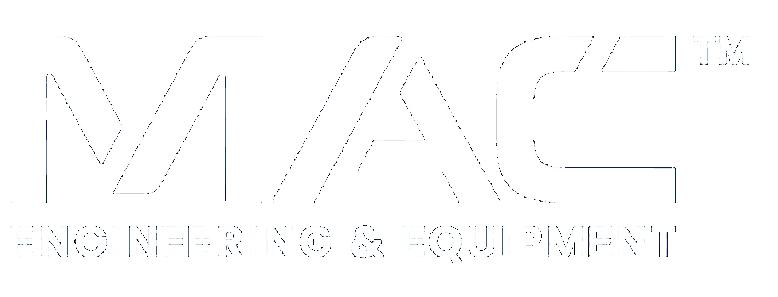

For over 55 years, MAC Engineering & Equipment Company, Inc. has sold more than 4500 machines, to over 300 customers, in 81 different countries, bringing the MAC Advantage worldwide.
MAC ENGINEERING & EQUIPMENT COMPANY, INC.
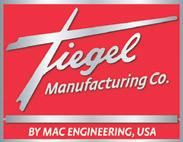
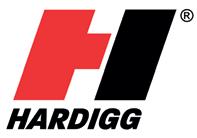
Visit www.mac-eng.com to see how we can bring the MAC Advantage to you!

























































































































































































































